Globetrotting in Asia and Africa 1992-1997
After finishing graduate school in 1992, I flew off to travel the world and see what I had been missing while slaving away in classrooms and laboratories. My original six-month plan became a two-year plan and a five-year reality, with pauses working in Hong Kong to earn money.
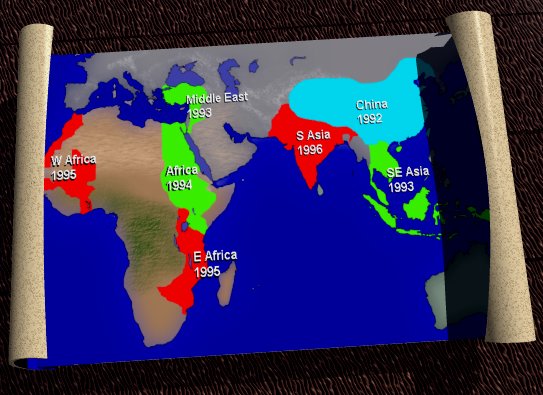
I first wrote this in 1997 when the web was still fairly new, by tidying up my diaries to make an online version for family and friends. I've never been happy with the telegraphic writing style, so expanded it for wider readership a couple times over the years, then in 2022 removed much of the more personal material which no longer had an audience.
My original impressions still look to have some value, and as long as that stays true I'll leave the core of them here. On the other hand, so much has changed over the years that some of what I did and thought will make little sense without context. So, I've begun adding historical notes in places. Those will be marked that way for easier reading.
Don't miss the related photo galleries: Taiwan, China, SE Asia 1, SE Asia 2, Türkiye, Syria and Jordan, Egypt and Sudan, East Africa, Morocco, West Africa, Pakistan and India
China 1992
 My trip started with a taxi and bus ride from Vancouver to Seattle and from there a plane to Taibei.
At the border I had a silly discussion with the immigration officer.
“How long are you staying in the States?”
“About two hours”
“Two hours?”
“I’m just here to fly out.”
“When are you returning to the US?”
“I’m not.”
“What do you mean, you’re not returning?”
It all seemed clear enough to me; perhaps he was fishing to see if I was lying.
Anyway, we eventually got it straight.
My trip started with a taxi and bus ride from Vancouver to Seattle and from there a plane to Taibei.
At the border I had a silly discussion with the immigration officer.
“How long are you staying in the States?”
“About two hours”
“Two hours?”
“I’m just here to fly out.”
“When are you returning to the US?”
“I’m not.”
“What do you mean, you’re not returning?”
It all seemed clear enough to me; perhaps he was fishing to see if I was lying.
Anyway, we eventually got it straight.
After a boring flight with mediocre food, I arrived. My first impressions were not entirely encouraging. Taibei stank like a billion clove cigarettes. The signs were almost all in Chinese, but eventually I found some in English and managed to catch a bus into town. The air felt hot and wet and they were digging up the middle of the street to build an underground railway. I tramped up and down over hulking metal pedestrian bridges. The place generally felt grimy and industrial, as if it had all been built the week before. It interested and tired me at the same time.
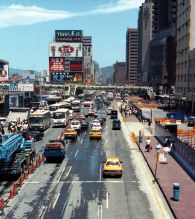 In the city centre I checked into a low-rent backpacker’s hostel, stumbled off to a bed in a dormitory shared with 9 other people, and fell asleep directly.
The next morning at breakfast, a westerner was talking on one of many phones in the lobby but turned to ask me “hey, are you free for a lesson this afternoon?”
He noticed my confused look, then realized I hadn’t come there to teach English, and apologized.
Apparently this was a common reason to be there, and anybody on hand would do as a substitute teacher.
That sort of exchange happened a few more times with different people. The foreigners there seemed all to be English teachers, with no
tourists, and they'd think and ask “why come here? There’s nothing to see. It’s boring.”
In the city centre I checked into a low-rent backpacker’s hostel, stumbled off to a bed in a dormitory shared with 9 other people, and fell asleep directly.
The next morning at breakfast, a westerner was talking on one of many phones in the lobby but turned to ask me “hey, are you free for a lesson this afternoon?”
He noticed my confused look, then realized I hadn’t come there to teach English, and apologized.
Apparently this was a common reason to be there, and anybody on hand would do as a substitute teacher.
That sort of exchange happened a few more times with different people. The foreigners there seemed all to be English teachers, with no
tourists, and they'd think and ask “why come here? There’s nothing to see. It’s boring.”
 Were they right? At first I thought they must have been exaggerating.
I could see a temple outside the hostel window!
I saw the sights. Chiang Kai-Shek’s gargantuan mausoleum suitably impressed.
Snake Alley offered a quick fix of eastern excitement.
Rows of merchants sold counterfeit “copy watches”, until a whistled bird call warned them of an approaching policeman and the vendors all packed up and run away.
The National Museum made the stop in Taiwan worthwhile by itself: I saw more cultural relics there than I later did in all of the mainland.
Were they right? At first I thought they must have been exaggerating.
I could see a temple outside the hostel window!
I saw the sights. Chiang Kai-Shek’s gargantuan mausoleum suitably impressed.
Snake Alley offered a quick fix of eastern excitement.
Rows of merchants sold counterfeit “copy watches”, until a whistled bird call warned them of an approaching policeman and the vendors all packed up and run away.
The National Museum made the stop in Taiwan worthwhile by itself: I saw more cultural relics there than I later did in all of the mainland.
I wandered through parks and gaped at the crowded, busy and noisy streets downtown. For lunch I joined the crowds buying boxes from street corner “slop shops”; carts or booths with pots full of vegetable and meat mixes. After a few days of this, I took the train to Hualian, starting off on a circuit around the island. Two days in Taiwan’s beauty spot bored me thoroughly; the city didn’t impress with its beauty and negotiating it in English proved difficult, so instead of continuing around the coast I took the train back to Taibei and flew out.
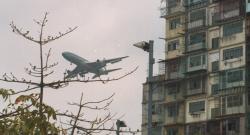 The flight to Hong Kong landed at the old Kai Tak airport.
This had been built in the centre of the city, on a small reclaimed spit of land, and was famous for its tricky and spectacular approach.
Even though we came in from the sea and didn’t make the most dramatic possible landing, it still gave me a small thrill to fly in with skyscrapers around us in all directions.
The terminal had English signs everywhere, and when I got outside I couldn’t smell any clove cigarettes, to my great relief.
I easily found a bus that dropped me off in Tsim Sha Tsui, and without too much trouble located Chungking Mansions, Hong Kong’s low-rent tourist refuge.
Outside, a sea of touts all tried to drag me off to their guest houses.
Inside, bored queue victims slumped wearily against green walls which looked filthy under the fluorescent lights.
I joined a long queue of people melting on the floor while waiting to enter a lift.
On the seventeenth floor of A block, I checked into the Travellers’ Hostel.
The closet-sized room I finally got (and shared with three people) didn’t look like an appealing place to sit around, so I went back out again to see the sights.
The flight to Hong Kong landed at the old Kai Tak airport.
This had been built in the centre of the city, on a small reclaimed spit of land, and was famous for its tricky and spectacular approach.
Even though we came in from the sea and didn’t make the most dramatic possible landing, it still gave me a small thrill to fly in with skyscrapers around us in all directions.
The terminal had English signs everywhere, and when I got outside I couldn’t smell any clove cigarettes, to my great relief.
I easily found a bus that dropped me off in Tsim Sha Tsui, and without too much trouble located Chungking Mansions, Hong Kong’s low-rent tourist refuge.
Outside, a sea of touts all tried to drag me off to their guest houses.
Inside, bored queue victims slumped wearily against green walls which looked filthy under the fluorescent lights.
I joined a long queue of people melting on the floor while waiting to enter a lift.
On the seventeenth floor of A block, I checked into the Travellers’ Hostel.
The closet-sized room I finally got (and shared with three people) didn’t look like an appealing place to sit around, so I went back out again to see the sights.
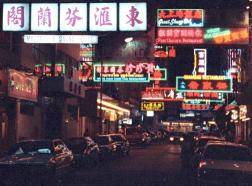 Immediately, I got lost.
The streets were narrow and incredibly busy, with people bustling everywhere and honking horns and flashing lights and neon signs.
The roads split and met each other at crazy angles, and I hadn’t yet learned any of the landmarks.
Also, half the place seemed to be under construction.
I did eventually find my way back, and after a day or so learned to navigate the streets.
Kowloon isn’t really very big so it’s hard to get badly lost.
I stayed in Hong Kong for three weeks, reading up on China, collecting papers to travel there, and seeing some of the many sights.
The Ten Thousand Buddhas Monastery caught my eye particularly, but I liked the views from the Peak as well.
Immediately, I got lost.
The streets were narrow and incredibly busy, with people bustling everywhere and honking horns and flashing lights and neon signs.
The roads split and met each other at crazy angles, and I hadn’t yet learned any of the landmarks.
Also, half the place seemed to be under construction.
I did eventually find my way back, and after a day or so learned to navigate the streets.
Kowloon isn’t really very big so it’s hard to get badly lost.
I stayed in Hong Kong for three weeks, reading up on China, collecting papers to travel there, and seeing some of the many sights.
The Ten Thousand Buddhas Monastery caught my eye particularly, but I liked the views from the Peak as well.
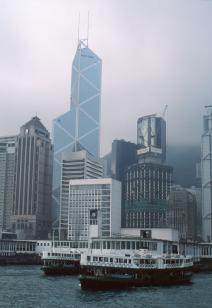 The people in Hong Kong were generally more interesting to observe than the sights,
and the newspapers provided an endless stream of weird and horrifying yet fascinating stories.
One day I read about two neighbours in the New Territories (Hong Kong’s countryside) who found a pile of rubbish on their mutual property line.
Each blamed the other for putting it there, and their argument escalated until they settled it with a crowbar and axe.
The neighbour with the axe won when he killed the other.
Another common sort of story involved people getting into a punch-up in a queue and eventually somebody being killed.
People there told me these things always happened in summer, when the weather is oppressive enough to drive anybody crazy.
The people in Hong Kong were generally more interesting to observe than the sights,
and the newspapers provided an endless stream of weird and horrifying yet fascinating stories.
One day I read about two neighbours in the New Territories (Hong Kong’s countryside) who found a pile of rubbish on their mutual property line.
Each blamed the other for putting it there, and their argument escalated until they settled it with a crowbar and axe.
The neighbour with the axe won when he killed the other.
Another common sort of story involved people getting into a punch-up in a queue and eventually somebody being killed.
People there told me these things always happened in summer, when the weather is oppressive enough to drive anybody crazy.
An American couple in the hostel found an unusual way to make trouble for themselves. They had just returned from China and hated it. Fed up with small irritations and constant hassle, they had arranged their tickets out, gone to the airport and checked in. In the waiting area the woman suddenly got up, said “wait here” then went and stole some trivial thing from a duty-free shop... and got caught! She went to jail. They both missed their flights (and couldn’t reschedule them). New flights used up all their cash and more. They were in big trouble. Why had she done this? He didn’t know but guessed she had just wanted some small bit of revenge. Visitors to China then very often came away hating the place, and many of those who did grumbled freely about it.
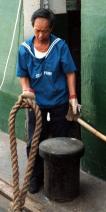 One night I sat as a movie extra in a Jackie Chan film, “City Hunter.” If you’ve seen the movie you’ve seen me, briefly: I’m the tall guy with glasses in the tuxedo,
at a small table near the stage in the bar of the Fuji Maru. The studio paid me some $45 US to sit at that table with a pretty girl and be served drinks by
even prettier girls in skimpy costumes. It sounds like a dream job but I found it tiring and uncomfortable. One night sufficed for me.
One night I sat as a movie extra in a Jackie Chan film, “City Hunter.” If you’ve seen the movie you’ve seen me, briefly: I’m the tall guy with glasses in the tuxedo,
at a small table near the stage in the bar of the Fuji Maru. The studio paid me some $45 US to sit at that table with a pretty girl and be served drinks by
even prettier girls in skimpy costumes. It sounds like a dream job but I found it tiring and uncomfortable. One night sufficed for me.
Late in August, I finally moved on to China proper, arriving at an unknown train station in a concrete wasteland many kilometres from the centre of Guangzhou (Canton). When I tried to get on a bus to go into town, I heard a high-pitched wailing from behind me and noticed the Chinese people around me all jump back quickly. From around the corner of the bus appeared a small man apparently about a hundred years old, but obviously in good shape as he grabbed me by the backpack and threw me out of the way before scrambling onto the bus. The bystanders had a good laugh at that and I eventually managed to squeeze in. I squeezed out again in the centre of town, crushing a few arches and destroying a few hairstyles. The sun had already set so I wandered the streets in early evening looking for a cheap place to stay. I didn’t find any so settled in a medium-priced hotel.
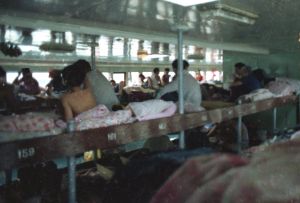 Guangzhou hadn’t looked too appealing in the time I’d spent wandering, so next morning I found my way to the city docks and got on a boat to Wuzhou.
a small town up the Pearl River near the border with Guangxi province.
Third class on this boat comprised two stacked platforms separated into trays just big enough for one person each.
I found it comfortable enough, with good food.
My fellow passengers sat quietly, minding their own business.
The scenery appealed, too; as we moved inland it became less crowded and much quieter and it started to feel more like a foreign country.
Guangzhou hadn’t looked too appealing in the time I’d spent wandering, so next morning I found my way to the city docks and got on a boat to Wuzhou.
a small town up the Pearl River near the border with Guangxi province.
Third class on this boat comprised two stacked platforms separated into trays just big enough for one person each.
I found it comfortable enough, with good food.
My fellow passengers sat quietly, minding their own business.
The scenery appealed, too; as we moved inland it became less crowded and much quieter and it started to feel more like a foreign country.
Wuzhou appeared as a simple concrete dock, a set of giant steps leading into the river. I found the bus stop quickly, bought a ticket and pressed on again. The bus wound its way over scenic hills covered with scrub and little trees. We stopped in several small dusty concrete villages, where I tried frantically to match the names on the signs against the characters on my map before we rolled away. Several times we passed minor accident scenes on the road. The bus rattled and clanked in a way that suggested imminent breakdown, but we made it.
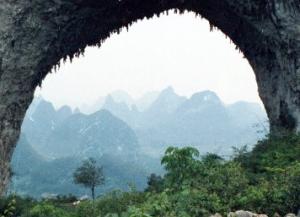 Yangshuo contrasted well with the dusty concrete blocks we’d passed on the way there.
In 1992 it hadn’t grown too much, and older-style buildings made up half of town.
It had already established itself as a backpacker’s ghetto, however, and at night one could wander down the street and choose from many small and cheap restaurants of dubious quality.
I tried to apply the usual rule for these places and eat in the popular ones, but it didn’t work.
Too many other people also wandered the streets looking at crowds.
Restaurants would remain empty until one of us, perhaps a previous customer, sat down, at which point they would quickly fill as all the street wanderers flooded in.
It didn’t save me, anyway, and my first case of traveller’s diarrhoea kept me there longer than I had planned.
Yangshuo contrasted well with the dusty concrete blocks we’d passed on the way there.
In 1992 it hadn’t grown too much, and older-style buildings made up half of town.
It had already established itself as a backpacker’s ghetto, however, and at night one could wander down the street and choose from many small and cheap restaurants of dubious quality.
I tried to apply the usual rule for these places and eat in the popular ones, but it didn’t work.
Too many other people also wandered the streets looking at crowds.
Restaurants would remain empty until one of us, perhaps a previous customer, sat down, at which point they would quickly fill as all the street wanderers flooded in.
It didn’t save me, anyway, and my first case of traveller’s diarrhoea kept me there longer than I had planned.
This didn’t really stop me from doing much. I cycled around villages and climbed a nearby rock formation, called Moon Hill because it has a crescent moon-shaped hole. The food in town tasted good despite its lack of hygiene, so I found it easy to while away an afternoon sitting in a restaurant and watching interesting street life. In the evenings, local people held outdoor math classes with the assistance of a loudspeaker, a spotlight and a cheap blackboard. They also went fishing, using cormorants which would dive into the river and gobble up a fish. To stop the birds from swallowing their catch, the fisherman had fastened tight-fitting rings around their necks, and when the birds came up with their fish they would tease them out of their gullets and into the boat. Their catch for the night looked small; one hopes they made up for it all in the income from the crowds of tourists watching.
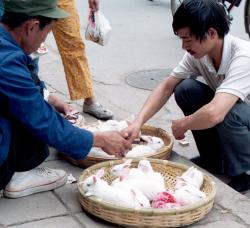 I left Yangshuo after ten days, taking an uninteresting bus ride west to Liuzhou, from which I caught a train on to Kunming.
We bought local food before boarding.
Mid-autumn festival was near in time then so shops stacked great piles of mooncakes, a sort of small greasy pie stuffed with sweet bean paste and an egg yoke.
The shops also stocked various sorts of candies.
Small cupcakes with a sort of sponge-rubber texture were very popular although quite plain-tasting.
While wandering Liuzhou on this shopping trip, we stopped to look at a movie poster and a crowd began to collect around us, just watching us.
We forced our way out while there were still few enough people for that to be relatively easy.
The train arrived, we got on, and rode went through scenic country but this did us no good for sightseeing purposes as night had fallen then and the whole ride took place in the dark.
I left Yangshuo after ten days, taking an uninteresting bus ride west to Liuzhou, from which I caught a train on to Kunming.
We bought local food before boarding.
Mid-autumn festival was near in time then so shops stacked great piles of mooncakes, a sort of small greasy pie stuffed with sweet bean paste and an egg yoke.
The shops also stocked various sorts of candies.
Small cupcakes with a sort of sponge-rubber texture were very popular although quite plain-tasting.
While wandering Liuzhou on this shopping trip, we stopped to look at a movie poster and a crowd began to collect around us, just watching us.
We forced our way out while there were still few enough people for that to be relatively easy.
The train arrived, we got on, and rode went through scenic country but this did us no good for sightseeing purposes as night had fallen then and the whole ride took place in the dark.
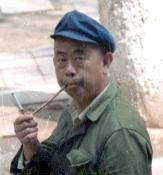 Early in the morning, we arrived in Kunming, a modern-looking concrete wonder.
Yunnan province is known for its mild climate and most people rate Kunming as one of the nicer cities in China.
In World War II it had great strategic importance as the end of the Burma Road and the base of the Flying Tigers.
Travellers can’t see much of this now, but on a hill just outside town one can see the Bamboo Temple, a rare surviving bit of culture (or perhaps one rebuilt after the Cultural Revolution).
Kunming’s back streets also contained many interesting sights, such as black-market rabbit dealers and mysterious market stalls.
My curiosity particularly was piqued by a birth-control poster with a happy mother, father and baby beaming above the slogan “1+1=3”.
Early in the morning, we arrived in Kunming, a modern-looking concrete wonder.
Yunnan province is known for its mild climate and most people rate Kunming as one of the nicer cities in China.
In World War II it had great strategic importance as the end of the Burma Road and the base of the Flying Tigers.
Travellers can’t see much of this now, but on a hill just outside town one can see the Bamboo Temple, a rare surviving bit of culture (or perhaps one rebuilt after the Cultural Revolution).
Kunming’s back streets also contained many interesting sights, such as black-market rabbit dealers and mysterious market stalls.
My curiosity particularly was piqued by a birth-control poster with a happy mother, father and baby beaming above the slogan “1+1=3”.
People-watching was another easy attraction, because people in China like to stare and accept it. Fistfights drew the biggest crowds and these appeared everywhere, every day. Fighting seemed at times to be the Chinese national sport, and they indulged themselves for the smallest reasons. If two crowds tried to cross a street in opposite directions, the high chance of a fistfight occurring made it worth stopping to watch. They found more passive pursuits, too. In a city park, old communists played party tunes and danced and clapped in their blue pajama-like uniforms. I went into a large department store to buy some small item, and found the staff all sleeping on the counters.
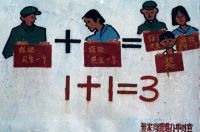 Language difficulties abounded there and elsewhere in China, although they rarely caused trouble.
The infinitely practical Chinese worked around such minor nuisances as the lack of a common language.
Strangers ran up on the street shouting “thank you thank you” for no apparent reason, except perhaps a gross misunderstanding of English.
On the other hand, I quickly learned not to ask for directions.
When people answered, the answers I got rarely made sense.
If they did make sense they were usually wrong, but I suspect this resulted more from some Chinese inability with directions than from language troubles.
Language difficulties abounded there and elsewhere in China, although they rarely caused trouble.
The infinitely practical Chinese worked around such minor nuisances as the lack of a common language.
Strangers ran up on the street shouting “thank you thank you” for no apparent reason, except perhaps a gross misunderstanding of English.
On the other hand, I quickly learned not to ask for directions.
When people answered, the answers I got rarely made sense.
If they did make sense they were usually wrong, but I suspect this resulted more from some Chinese inability with directions than from language troubles.
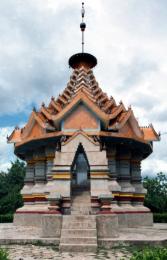 To get out of Kunming,I needed to buy a plane ticket, and this meant going to the office of CAAC and standing in line.
Queue-jumpers abounded there and overwhelmed the lone queue policeman, so getting to the ticket desk required a bit of direct physical action.
Recalling the little old man in Guangzhou, I simply picked up the worst queue-jumpers and threw them to the back of the line.
Less pushy ones I only pushed aside.
Looking back, one can easily see how arrogant and rude this was, but in China and other places I often found myself in these situations
where if I behaved in a polite and respectful manner local people would trample me.
This has remained one of the more problematic issues I’ve faced in years of travelling; how to balance a respect for the people you meet with practical needs.
I think it is difficult because local people sometimes don’t make any special concessions for foreigners, and we in turn don’t know any better way
to do things than to join the crowds at the wrong time or the wrong place and fight.
To get out of Kunming,I needed to buy a plane ticket, and this meant going to the office of CAAC and standing in line.
Queue-jumpers abounded there and overwhelmed the lone queue policeman, so getting to the ticket desk required a bit of direct physical action.
Recalling the little old man in Guangzhou, I simply picked up the worst queue-jumpers and threw them to the back of the line.
Less pushy ones I only pushed aside.
Looking back, one can easily see how arrogant and rude this was, but in China and other places I often found myself in these situations
where if I behaved in a polite and respectful manner local people would trample me.
This has remained one of the more problematic issues I’ve faced in years of travelling; how to balance a respect for the people you meet with practical needs.
I think it is difficult because local people sometimes don’t make any special concessions for foreigners, and we in turn don’t know any better way
to do things than to join the crowds at the wrong time or the wrong place and fight.
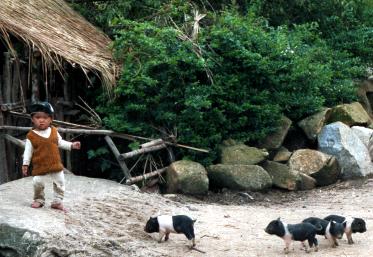 Despite these battles, I did get a ticket.
From Kunming I flew to Xishuangbanna, a triangle of land between Laos and Burma.
The people there are mostly not Han Chinese but hill tribes and minority groups such as the Dais.
The Mekong is very young there and the landscape hilly with lots of terraced farmland.
Where most of China seemed rather dry and dusty, this corner of it closely resembled the jungle scenery one associates with south-east Asia.
Despite these battles, I did get a ticket.
From Kunming I flew to Xishuangbanna, a triangle of land between Laos and Burma.
The people there are mostly not Han Chinese but hill tribes and minority groups such as the Dais.
The Mekong is very young there and the landscape hilly with lots of terraced farmland.
Where most of China seemed rather dry and dusty, this corner of it closely resembled the jungle scenery one associates with south-east Asia.
The capital, Jinghong, had an excellent restaurant serving strangely-named but tasty dishes like “deep-fried cow hide,” “strange-tasting vegetables” and “fried river moss”. The colonial-style guesthouse had a pleasant veranda with bamboo furniture and river views. Despite this pleasant atmosphere, Jinghong didn’t compare in interest to the things one could see on a day trip to the countryside. Market days were good times to see the tribal villages farther into the hills. Tramping around one such village, I shot photo after photo as colourful people struck impressive poses. The muddy streets tossed up some bonus sights, also; a giant satellite dish on top of a mud hut, and a crowd of young Buddhist monks waiting outside the door of a small mud video cinema showing “Terminator II.”
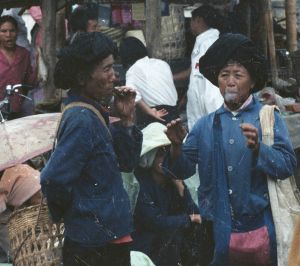 Flying back to Kunming proved no easier than flying in from Kunming.
The airline staff told me I could not fly earlier than Friday that week.
Every earlier flight was full and no amount of begging got me a ticket for Wednesday, when I wanted to go.
Back at my hotel I mentioned this to a friend, a German Sinology student, who also wanted to fly back on Wednesday.
“No problem,” she assured me.
Then she went to the office and, weeping and wailing, explained how she had to fly back immediately because her father had just died.
When she got her ticket I suddenly appeared and she added that I had to go also because I was her brother.
Suddenly I had a reservation for Wednesday on a flight that the airline had said was completely full.
Flying back to Kunming proved no easier than flying in from Kunming.
The airline staff told me I could not fly earlier than Friday that week.
Every earlier flight was full and no amount of begging got me a ticket for Wednesday, when I wanted to go.
Back at my hotel I mentioned this to a friend, a German Sinology student, who also wanted to fly back on Wednesday.
“No problem,” she assured me.
Then she went to the office and, weeping and wailing, explained how she had to fly back immediately because her father had just died.
When she got her ticket I suddenly appeared and she added that I had to go also because I was her brother.
Suddenly I had a reservation for Wednesday on a flight that the airline had said was completely full.
At the airport Chinese officials and businessmen waited impatiently by the waiting room doors. When the plane landed the doors opened and they flooded out, racing to the plane to get into their already-reserved seats. This seemed like crazy impatience but they may have known something I didn’t. As I got on the plane, two passengers were pummeling each other with bare fists over their choice of seat. The co-pilot came back and broke it up, and fortunately for us all did it without getting himself broken up. We flew off.
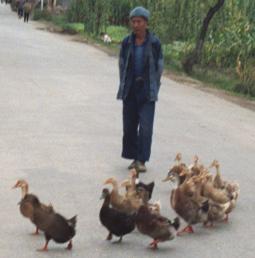 From Kunming I took an overnight “sleeper” bus (with beds instead of seats) to Da Li, a famous stop on the old Burma Road.
Da Li was China’s other backpacker’s ghetto, after Yangshuo.
China supports a few of every known species of traveller but Da Li particularly attracted neo-hippies, backpackers and self-anointed
“Travellers” wearing strange tie-dye clothes and ethnic pillbox hats.
They were largely English and European with lesser numbers from Canada, the U.S.A., and other places.
The town sits on a hillside above a lake, and is walled with gates at each end.
It has a long history, partly as capital of a small independent kingdom, and around town are colourful temples and buildings.
From Kunming I took an overnight “sleeper” bus (with beds instead of seats) to Da Li, a famous stop on the old Burma Road.
Da Li was China’s other backpacker’s ghetto, after Yangshuo.
China supports a few of every known species of traveller but Da Li particularly attracted neo-hippies, backpackers and self-anointed
“Travellers” wearing strange tie-dye clothes and ethnic pillbox hats.
They were largely English and European with lesser numbers from Canada, the U.S.A., and other places.
The town sits on a hillside above a lake, and is walled with gates at each end.
It has a long history, partly as capital of a small independent kingdom, and around town are colourful temples and buildings.
I rode a bus one day north to Lijiang, a town in a green valley in the Tibetan foothills with even more colourful old stone and wood houses.
In some ways it looked like central Asia, which after all was not too far away.
Locals told horror stories from the Cultural Revolution but in the nineties it was quite a peaceful place.
The people there were another minority group, the Naxi.
Their society is matriarchal and women run everything while men do the menial jobs.
Women still took my order in the restaurants but if they didn’t like it, they just told me what to eat.
Lijiang remains one of the most memorable places I’ve been.
Near town there are many scenic treks to be made, Tiger Leap Gorge being the most famous of those.
The thought also tempted me of simply striking out despite rules and heading for Tibet (and in fact people do exactly that), but it didn’t tempt
me seriously.
I did wander up and down hills and out to see the famous Dr. Ho and his herbal medicine/tea shop.
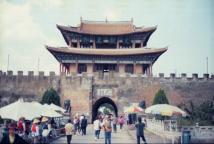
After a few days I hopped another bus back to Kunming. In these recent bus trips my count of observed fatal accidents had soared ever higher. Every road trip in China seemed to toss up another crash scene, and most trips were much worse than my initial impressions during that ride from Wuzhou to Yangshou. I particularly remember one ride in Yunnan where all the bus passengers gaped open-mouthed as we passed the naked body of a dead woman lying in the middle of a road. How had she come to be there? Had she been hit by a car and then had her clothes looted by someone? Simply dumped there after being murdered somewhere else? Of course, I never learned the answer.
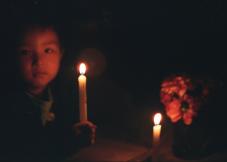 However dangerous it seemed, China’s traffic probably kills a lower percentage of people than in a lot of other poor countries.
This early exposure to it taught me a good lesson; things like Malaria and petty crime tend to concern us much more than they should.
To stay alive in these poor countries, one should really try hard to exercise good sense about which vehicles to ride in.
Statistics back this up; surveys regularly report that traffic accidents are the number one cause of death among tourists.
However dangerous it seemed, China’s traffic probably kills a lower percentage of people than in a lot of other poor countries.
This early exposure to it taught me a good lesson; things like Malaria and petty crime tend to concern us much more than they should.
To stay alive in these poor countries, one should really try hard to exercise good sense about which vehicles to ride in.
Statistics back this up; surveys regularly report that traffic accidents are the number one cause of death among tourists.
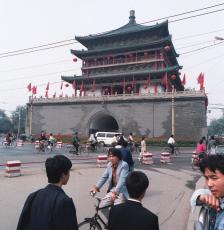 Back in Kunming again, I fought my way through the airline ticket queue one more time and onto another airplane, to Xi’An.
This is the most ancient Chinese capital city, or at least the oldest known surviving one.
Its collection of historic sites was second only to Beijing, if that.
Most foreigners know best the buried funereal army of some six thousand terracotta soldiers built by the first Emperor of China.
Lesser things to see included the city wall and various museums.
At the time I visited the local government had gone a bit crazy with foreigner’s prices, causing me considerable annoyance.
I didn’t mind paying $9 US to see the terracotta soldiers, even though it was ten times local price.
However, I absolutely refused to pay $5 to climb the city wall or $7 to get into a third-rate local museum.
The city itself, a curious mix of the oldest civilization and the newest construction, offered many pleasant strolls.
After seeing the sights I settled down in the Small World restaurant, on the main road in the southern part of town.
There I could always find someone to sit and chat with, discussing anything from Chinese history to international politics.
The cold and damp weather prevailing at that time encouraged this idleness.
Back in Kunming again, I fought my way through the airline ticket queue one more time and onto another airplane, to Xi’An.
This is the most ancient Chinese capital city, or at least the oldest known surviving one.
Its collection of historic sites was second only to Beijing, if that.
Most foreigners know best the buried funereal army of some six thousand terracotta soldiers built by the first Emperor of China.
Lesser things to see included the city wall and various museums.
At the time I visited the local government had gone a bit crazy with foreigner’s prices, causing me considerable annoyance.
I didn’t mind paying $9 US to see the terracotta soldiers, even though it was ten times local price.
However, I absolutely refused to pay $5 to climb the city wall or $7 to get into a third-rate local museum.
The city itself, a curious mix of the oldest civilization and the newest construction, offered many pleasant strolls.
After seeing the sights I settled down in the Small World restaurant, on the main road in the southern part of town.
There I could always find someone to sit and chat with, discussing anything from Chinese history to international politics.
The cold and damp weather prevailing at that time encouraged this idleness.
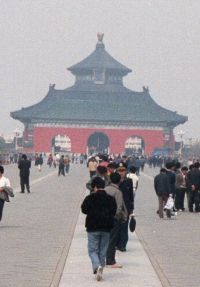 From Xi’An I took the train to Beijing.
Where Xi’an had felt cold and dark, Beijing was bright and sunny.
In actually, being October already, the temperature was nearing winter levels, but the broad streets and open squares of the city made it seem warmer.
Beijing more than anywhere in China abounded with cultural sights, and it presented a microcosm of Developing China.
One could travel the inner city on an underground railway, popping up in front of historical sites hundreds of years old.
The Great Wall, an ancient defence, lay just north of town.
Underneath downtown Beijing lay a more modern defence; the “underground city”.
This had originally been a series of air raid tunnels to protect the government against a nuclear attack from Russia.
When I visited they used it for housing and shops.
Back above ground, temples and Parks dotted the city, as well as numerous shopping districts where souvenirs from across China were offered up.
From Xi’An I took the train to Beijing.
Where Xi’an had felt cold and dark, Beijing was bright and sunny.
In actually, being October already, the temperature was nearing winter levels, but the broad streets and open squares of the city made it seem warmer.
Beijing more than anywhere in China abounded with cultural sights, and it presented a microcosm of Developing China.
One could travel the inner city on an underground railway, popping up in front of historical sites hundreds of years old.
The Great Wall, an ancient defence, lay just north of town.
Underneath downtown Beijing lay a more modern defence; the “underground city”.
This had originally been a series of air raid tunnels to protect the government against a nuclear attack from Russia.
When I visited they used it for housing and shops.
Back above ground, temples and Parks dotted the city, as well as numerous shopping districts where souvenirs from across China were offered up.
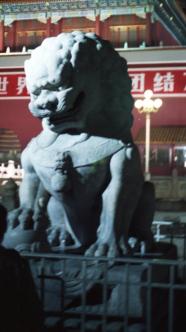 Many of the cultural sites seemed boring and empty, including the Temple of Heaven and Forbidden City.
There was a reason for this, evident when I recalled the National Museum in Taipei.
The curators there had maintained that the history of China showed in "small things" rather than architecture.
At the time I had wondered if this was a self-serving rationalization: the museum in Taiwan could only show small things because those were all the Nationalists
could carry off when they fled from the mainland.
From where had they carried them? Now I had a good idea; from there in Beijing, apparently.
Many of the cultural sites seemed boring and empty, including the Temple of Heaven and Forbidden City.
There was a reason for this, evident when I recalled the National Museum in Taipei.
The curators there had maintained that the history of China showed in "small things" rather than architecture.
At the time I had wondered if this was a self-serving rationalization: the museum in Taiwan could only show small things because those were all the Nationalists
could carry off when they fled from the mainland.
From where had they carried them? Now I had a good idea; from there in Beijing, apparently.
I don’t mean to suggest that the Nationalists were completely wrong in this. Had their mountain of loot remained in China it might well have suffered the fate of so much of the rest of China’s cultural relics, and been destroyed in the Cultural Revolution. Beijing’s ancient cultural sights were barren but at least they still existed; that was an improvement over what I had seen in the rest of the country. If not for the natural setting and street life, many people would simply conclude China has nothing to see. The thoroughness with which the Cultural Revolution had wiped out China's visible history was hard to believe in those days, unless you saw it for yourself. The most famous sights around the country were clear exceptions to the rule of destruction. For instance, the Terracotta soldiers had survived for thousands of years because they lay buried and unknown during the Cultural Revolution and weere only dug up in the 1980s.
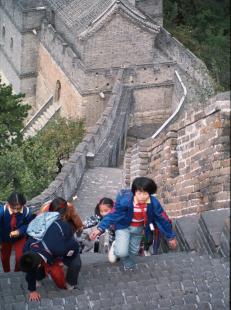 The Great Wall took too much space and piled up too much material for the Red Guard to destroy, although in the nineties others seemed to be trying their best.
I thought I knew the statistics of it beforehand, but found it quite a different thing to see it stretching along sheer cliffs and over sharp peaks, off
to the limits of vision in each direction.
All the hype I'd heard in no way ruined the sight. It was simply and literally the most awesome thing I had ever seen.
I could stand on it for hours picturing it in reality and in my mind’s eye, envisioning it stretching off to far away western wastelands, imagining trekking along the entire thing.
The Great Wall took too much space and piled up too much material for the Red Guard to destroy, although in the nineties others seemed to be trying their best.
I thought I knew the statistics of it beforehand, but found it quite a different thing to see it stretching along sheer cliffs and over sharp peaks, off
to the limits of vision in each direction.
All the hype I'd heard in no way ruined the sight. It was simply and literally the most awesome thing I had ever seen.
I could stand on it for hours picturing it in reality and in my mind’s eye, envisioning it stretching off to far away western wastelands, imagining trekking along the entire thing.
Beijing city life amused for endless hours, as Hong Kong’s had.
The bus system particularly entertained me, topping even Guangzhou for aggressive crowds.
There were no traces of line-ups, just big mobs trying to get on the bus (which was already packed), while other big mobs tried to get off.
Your only real hope if you wanted to take one of these was to wait in the crowd at the first stop and swing your elbows wildly around you while lunging ahead of the mob as it surged in
through the bus doors.
Getting out may have meant climbing out the window to get off the bus again, but you only had to pay about half the time because often the conductor couldn’t reach you through the crowds.
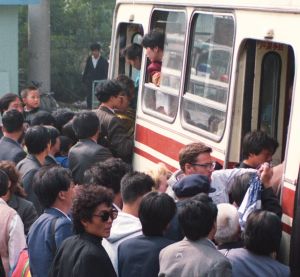
My dormitory in the Hotel Qiaoyuan turned up even more interesting characters than I had met in Da Li. Every night I could count on being woken up at about three o’clock by a young Japanese man grinding his teeth in his bed on the other side of the room. I later discovered that this is common among Japanese travellers and infinitely preferable to screaming, which some also do in their sleep. One Sunday morning an old Spanish man down at the other end of the row began his prayers. By the time I came back in the afternoon he had reached full flight, weeping miserably at the thought of the crucifixion. He did, however, pause briefly to greet me in a calm and collected voice as I came in the door.
Interesting though all this was, it was also stressful and eventually I felt the need to move on. Getting a train ticket back to Guangzhou made my earlier airline battles in Kunming look trivial. At the station I went through several wrong queues, often arriving at the front just as the clerk decided to close up for a break. After a few trips there I lost patience with this and got my ticket by towering over clerks and refusing to move until they told me or gave me what I wanted. Others fared even worse than I; I recall an Israeli man shouting at a woman in a counter “This is a foreigner’s ticket office; you MUST speak English. Now give me a ticket.”
The train ride itself passed much more pleasantly. I travelled in “hard sleeper” class, taking the middle bunk in a six-bed compartment. At that late time of year the countryside had turned grey and brown but the trip offered a chance to rest and reflect. When I arrived, Guangzhou seemed even more ugly and hassle-free than on my first visit, so I wasted no time and didn’t even attempt to cross the border by train. Instead I took an expensive mini-bus direct from the train station to Shenzhen, on the border with Hong Kong. I no longer cared about costs and fuelled my mad rush for Hong Kong with a steady flow of money, keen to return to comfort.
An unplanned stay in Hong Kong (October 1992-April 1993)
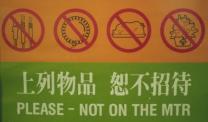 With my return to the big city I had finished one leg of my trip. Next came south-east Asia, but I had made no definite plans.
I considered options and bought a ticket to Bangkok with a free stopover in Manila, departing two weeks later.
Then I spent my time not doing much of anything but reading and shopping.
At Halloween my roommate invited me out on a double date with two of his students, and that swelled into a group outing as they invited more people.
We went to a disco in Lan Kwai Fong, Hong Kong’s trendy night-club area.
Chinese women screamed in well-simulated terror as costumed guys stomped by wearing frightening masks.
The world’s most obnoxious DJ played to English girls dancing in their bras and Chinese girls dancing with each other.
My costume included a large bamboo staff, which parted the crowds nicely
(I have noticed on several occasions that Hong Kongers are overly frightened of sticks and things like sticks).
With my return to the big city I had finished one leg of my trip. Next came south-east Asia, but I had made no definite plans.
I considered options and bought a ticket to Bangkok with a free stopover in Manila, departing two weeks later.
Then I spent my time not doing much of anything but reading and shopping.
At Halloween my roommate invited me out on a double date with two of his students, and that swelled into a group outing as they invited more people.
We went to a disco in Lan Kwai Fong, Hong Kong’s trendy night-club area.
Chinese women screamed in well-simulated terror as costumed guys stomped by wearing frightening masks.
The world’s most obnoxious DJ played to English girls dancing in their bras and Chinese girls dancing with each other.
My costume included a large bamboo staff, which parted the crowds nicely
(I have noticed on several occasions that Hong Kongers are overly frightened of sticks and things like sticks).
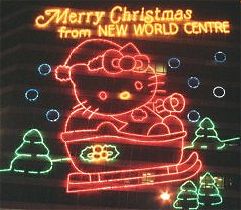
On that night out I met a local girl. We began dating. I postponed my trip to the Philippines for two weeks, and then a month, and then cancelled it entirely. My two-week visit turned into a months-long stay. It was quite easy to fill the time. I taught English and took casual jobs to pay the bills, and saw the many local sights.
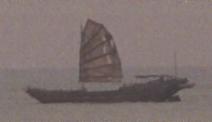 Macau was a particularly memorable destination during that time.
Hong Kong and Macau developed in very different ways, and it was easy to see the differences when visiting Macau.
Only about 10-15% as many people lived there.
A bit of wandering would take you to Portuguese buildings hundreds of years old.
It was much quieter than Hong Kong, and in many ways more pleasant.
In Hong Kong, Macau was unfairly known as a gambling and vice haven.
In fact, the gardens and food and sites made it a very pleasant visit, and one could see the highlights
in a day by taking an early-morning ferry there and a late-night ferry back
Macau was a particularly memorable destination during that time.
Hong Kong and Macau developed in very different ways, and it was easy to see the differences when visiting Macau.
Only about 10-15% as many people lived there.
A bit of wandering would take you to Portuguese buildings hundreds of years old.
It was much quieter than Hong Kong, and in many ways more pleasant.
In Hong Kong, Macau was unfairly known as a gambling and vice haven.
In fact, the gardens and food and sites made it a very pleasant visit, and one could see the highlights
in a day by taking an early-morning ferry there and a late-night ferry back
At Christmas we took a boat to Hainan Island for a week-long beach holiday. At that time, the island had just begun its tourist boom. Haikou, the main port on the north side, was still somewhat sleepy, but the south coast had already sprouted hotels and condominiums and grown concrete everywhere. It little resembled either Hong Kong or the other parts of China I'd toured. Overall it made for a great holiday, marred slightly by bad news on our return. On New Year’s Eve that year, twelve people had been crushed to death at Lan Kwai Fong — in a crowd much like the one there the night we met.
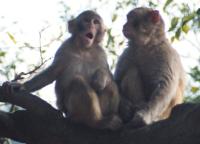 As in other cities, I happily occupied many hours in Hong Kong with people-watching — especially in Chungking Mansions.
While most tourists behaved normally, there were many characters exhibiting varying degrees of insanity and eccentricity.
Some were paranoiac and would relate nothing of their lives, leaving the rest of us to amuse ourselves with hours of speculation.
Others seemed ordinary until they cracked up, usually shortly after returning from China like the couple I had met in my first days in Hong Kong.
I heard about more extreme cases.
In one, a man collected all the bags in his hostel and sorted them into neat piles in the hallway during the night.
Another man had a small misunderstanding with the desk clerk in the Traveller’s Hostel, which elevated until he started a frenzy of shouting.
He obtained a refund by this, which he promptly threw all over the room.
As in other cities, I happily occupied many hours in Hong Kong with people-watching — especially in Chungking Mansions.
While most tourists behaved normally, there were many characters exhibiting varying degrees of insanity and eccentricity.
Some were paranoiac and would relate nothing of their lives, leaving the rest of us to amuse ourselves with hours of speculation.
Others seemed ordinary until they cracked up, usually shortly after returning from China like the couple I had met in my first days in Hong Kong.
I heard about more extreme cases.
In one, a man collected all the bags in his hostel and sorted them into neat piles in the hallway during the night.
Another man had a small misunderstanding with the desk clerk in the Traveller’s Hostel, which elevated until he started a frenzy of shouting.
He obtained a refund by this, which he promptly threw all over the room.
Some old-time travellers, while not showing any obvious erratic behaviour, had obviously drifted a few years too long without any steady contact with people. They'd lost what perspective they may have once had and would do just about anything for money. Many earned a meagre living as full-time movie extras. Drugs had also destroyed many, in particular a group of genuine hippies who lived on the ground floor of Chungking Mansions near the entrance and seemed to do nothing all day but smoke.
Some other foreigners were traders. I met one Swiss man who travelled in a regular circuit. He bought electronic goodies in Hong Kong and sold them in Bangkok, where he bought silk. Then he had the silk made into shirts in Vietnam, and he carried the shirts back to Hong Kong, where he sold them and bought more electronics. collected from as far away as Egypt. At Chinese New Year a flood of Koreans and Israelis appeared, illegally hawking counterfeit bags and clothes, and jewellery and oddities
Professional and amateur reporters, photographers and writers turned up regularly. Missionaries came and went. Still more foreigners worked as hostesses, leaflet distributors, hot dog salesmen, buskers, beggars, fortune-tellers, couriers, smugglers, drug dealers, forgers. Many held more “mainstream” jobs such as bar staff, English teachers and store staff. Some were whores, backpacking western girls who drifted into prostitution.
It should surprise nobody that many of these foreigners were not there legally. Immigration regularly raided Chungking Mansions in the middle of the night, working from the top floor to the bottom and catching anywhere from fifty to two hundred illegal workers, overstayers, illegal immigrants and criminals but always missing or overlooking many things.
By April I was running out of visa time and getting bored.
Then I met a Japanese man who had come overland all the way from Hanoi.
This confirmed rumours I had heard that the China-Vietnam border was open.
At the time, large parts of China were still closed to Vancouver and entry points to Vietnam were few, so this was a big deal.
I began making plans to head south by land to Vietnam.

South-East Asia 1993
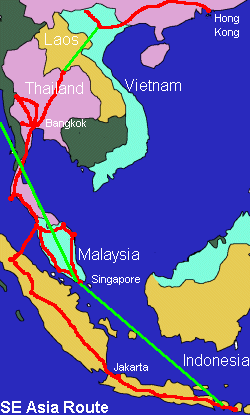 From Hong Kong I repeated my first voyage to Wuzhou. On this trip I had an entire afternoon to spend there, so wandered around Wuzhou.
It consisted of much more than a bus stop. In particular a nice park overlooked the river.
In the evening, I got on another horrible bus and rode overnight to Nanning.
There I stayed only long enough to get on a train to Pingxiang, a little town near the border with Vietnam.
This was an uncomfortable but interesting ride.
I sat with my arm out the window and wondered why, every time we turned a bend, my elbow got wet and little black spots of dirt appeared on it.
When I stuck my head out on one bend and looked, I saw it was a steam train!
The engine was sending back a cloud of steam with little flecks of coal dust.
From Hong Kong I repeated my first voyage to Wuzhou. On this trip I had an entire afternoon to spend there, so wandered around Wuzhou.
It consisted of much more than a bus stop. In particular a nice park overlooked the river.
In the evening, I got on another horrible bus and rode overnight to Nanning.
There I stayed only long enough to get on a train to Pingxiang, a little town near the border with Vietnam.
This was an uncomfortable but interesting ride.
I sat with my arm out the window and wondered why, every time we turned a bend, my elbow got wet and little black spots of dirt appeared on it.
When I stuck my head out on one bend and looked, I saw it was a steam train!
The engine was sending back a cloud of steam with little flecks of coal dust.
From Pingxiang I reached the border and there met two men, one Japanese and one Swiss, both going the same direction I was. None of us had proper visas, although we had made large efforts to get them, so we expected some trouble at the Vietnamese border post. We got it. Officials there threatened to send us back and we begged and whined and finally offered to pay a “special fine” to get across. It cost us $25 US in the end, quite expensive as these things go, but cheaper than flying from Nanning. That was the first time I’d been shaken down in my travels, but it wouldn’t be the last.
Historical note: in 1993 Vietnam was still under embargo by the US, and their war with China was fairly recent history. Thus, their trade with the outside world was severely limited and their infrastructure crumbling. Conditions have surely improved much since then.
In Lang Son, on the Vietnamese side of the border, we made a serious error and took the bus instead of the train to Hanoi.
It was the worst bus ride of my life.
We waited about 7 hours for the bus to fill and it filled completely, piled to the roof with goods in back and carpeted with people in front.
I perched on a bench wide enough for one and a half people, with one more leaning on my lap and one on my shoulder in addition to the Japanese man sitting next to me.
We were less than five minutes out from the station when we had our first breakdown.
They fixed it and we moved on and it broke down again, and again and again.
We had five flat tires.
We waited three hours at a province border post while they collected enough money to pay off the police (a lot of the goods stacked to the roof were smuggled, apparently).
Finally, after fifteen hours and one hundred forty kilometres, we arrived in Hanoi.
I think it was about then that I first thought of travelling by bicycle.
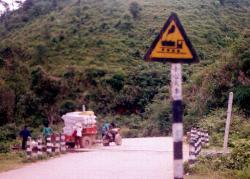
Because of the US embargo, Vietnam hadn’t experienced the rush of investment and speculation that had swept the rest of Asia.
Hanoi was still quite sleepy and quiet.
Cyclos (tricycle rickshaws) zipped around everywhere, flying through intersections in crosswise directions at the same time.
Old wood French buildings sat next to new concrete revolutionary museums and shops doing good business.
The climate in April was maximally hot and humid, although in evenings it cooled somewhat.
It was a fantastic place to eat with the best of French, Vietnamese and Chinese styles, typically for one or two US dollars.
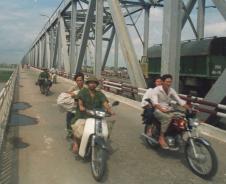
Embargo or not, US dollars were the preferred currency and it was possible to change traveller’s cheques. Sometimes people made silly mistakes. One European man wrote “Hanoi” as the city when he tried to cash the cheque and the bank refused to take it because, due to the embargo they would then be unable to redeem it. A Japanese man changed a thousand US dollars at once and received a box of money (the largest bill then was worth one dollar).
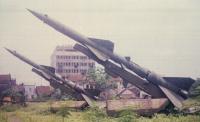 A war theme seemed to pervade everything the Vietnamese did. Hanoi had museums and parks, full of glorious military memorials.
To reach the east side of the river, one had to cross a bridge made largely of patches applied after successive bombing runs had destroyed bits of it.
Their history came across as a collection of glorious war stories. Little children played bullying games which adults refined and continued.
I found myself comparing them with the Spanish, both products of their long struggles to get rid of occupying foreigners,
and I had to wonder what the Americans had thought they were doing when they got into a war with them.
A war theme seemed to pervade everything the Vietnamese did. Hanoi had museums and parks, full of glorious military memorials.
To reach the east side of the river, one had to cross a bridge made largely of patches applied after successive bombing runs had destroyed bits of it.
Their history came across as a collection of glorious war stories. Little children played bullying games which adults refined and continued.
I found myself comparing them with the Spanish, both products of their long struggles to get rid of occupying foreigners,
and I had to wonder what the Americans had thought they were doing when they got into a war with them.
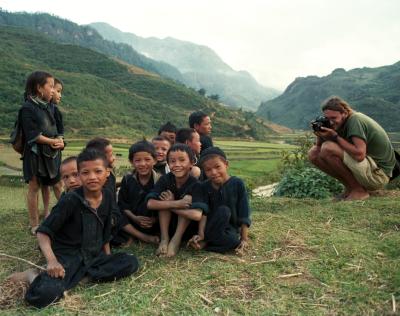 My brief taste of Vietnamese buses had left me determined to stay off them.
Trains overcharged foreigners (legally) by up to five hundred percent and had a reputation for being risky and very slow anyway.
Flights were only slightly more expensive but less satisfying. I put aside southern Vietnam for a later trip, possibly with Cambodia, and concentrated on the north.
For a few days I joined a group which had hired a jeep to go north to Sa Pa.
This area had then only recently been opened to foreigners.
While I don’t generally care much for silly notions about unspoiled places, I liked the reception I got there, where we were among the first European tourists to visit for forty-five years.
My brief taste of Vietnamese buses had left me determined to stay off them.
Trains overcharged foreigners (legally) by up to five hundred percent and had a reputation for being risky and very slow anyway.
Flights were only slightly more expensive but less satisfying. I put aside southern Vietnam for a later trip, possibly with Cambodia, and concentrated on the north.
For a few days I joined a group which had hired a jeep to go north to Sa Pa.
This area had then only recently been opened to foreigners.
While I don’t generally care much for silly notions about unspoiled places, I liked the reception I got there, where we were among the first European tourists to visit for forty-five years.
The hill tribes near Sa Pa (aka Montagnards) are a few of a seemingly endless patchwork of tribal peoples that occupy the hill country from Vietnam all the way up the hills to Tibet. I had met similar groups before in China, living in similar conditions. They farmed terraced hillsides and brought the crops to market in central towns. In Vietnam they seemed a bit richer than in China. Interpol and the Vietnamese police had made these people stop cultivating opium, although a few poppies still popped up every now and then among the corn they planted to replace the opium crop.
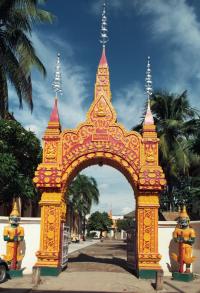 People had many stories to tell of the 1979 Chinese invasion.
It was never hard to find someone who would happily point out burned-out Chinese tanks, or less happily indicate buildings the Chinese had shot up before being forced out.
On balance, that invasion looked like a considerable defeat for the Chinese.
The locals had less to say about the long civil war.
In other parts of Vietnam other tribes had suffered badly in the war; I never learned how they had managed there in the far north.
People had many stories to tell of the 1979 Chinese invasion.
It was never hard to find someone who would happily point out burned-out Chinese tanks, or less happily indicate buildings the Chinese had shot up before being forced out.
On balance, that invasion looked like a considerable defeat for the Chinese.
The locals had less to say about the long civil war.
In other parts of Vietnam other tribes had suffered badly in the war; I never learned how they had managed there in the far north.
I returned to Hanoi, bought a ticket to Laos and left Vietnam. There was a brief moment of concern while I sat in the plane at the airport waiting to take off, as a cloud of mist worked its way up the aisle from the back of the plane to the cockpit. We left anyway and they served lunch. Dessert was a bar of horrible Vietnamese chocolate labelled “Chocolate as good as the Indonesians make it.” The slogan caught my eye, buit this modest boast wasn’t modest enough and didn’t speak well for either country.
Vientiane was then the only part of Laos one could visit without a pre-arranged tour.
It sported a huge number of colourful temples and parks, and had a large expatriate community with the luxuries they expect.
Many were foreign-aid workers, and some were perhaps working on the bridge going up across the Mekong, which would later connect Thailand and Laos by train.
Until they finished building that, the border crossing had to be done in small ferries.
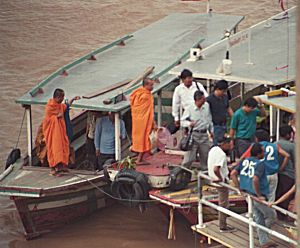
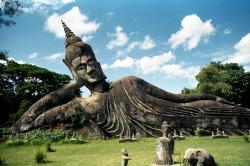 I stayed a couple days in Nong Khai looking around.
Vientiane and Nong Khai both had built fantastic sculpture gardens showing concrete statues of various deities and mythological creatures.
They were broadly similar in other ways, both relatively rural towns with a lot of quiet lanes and a small central core.
Of course, Vientiane was the capital and most developed city of Laos, and its similarity to a quiet Thai country town vividly demonstrated the poverty of Laos.
Aside from the scultpure gardens there were few special sights in Nong Khai, just scenic river vistas, so a couple days sufficed.
I stayed a couple days in Nong Khai looking around.
Vientiane and Nong Khai both had built fantastic sculpture gardens showing concrete statues of various deities and mythological creatures.
They were broadly similar in other ways, both relatively rural towns with a lot of quiet lanes and a small central core.
Of course, Vientiane was the capital and most developed city of Laos, and its similarity to a quiet Thai country town vividly demonstrated the poverty of Laos.
Aside from the scultpure gardens there were few special sights in Nong Khai, just scenic river vistas, so a couple days sufficed.
I can hardly remember the confusion of arriving by train in Bangkok now, but after a bit of casting about and a couple riverboat rides I settled in a room near Khao San road. The room had bedbugs (the first time I had seen them anywhere) so I quickly relocated to another guesthouse. I stayed a couple weeks in Bangkok at that point, touring the temples and sticking a curious nose into the red-light districts. Walking around the city guaranteed exhaustion quickly, but I sometimes escaped into parks and Dusit Zoo also offered a pleasant diversion. When the heat really got to be too much, the city abounded with air-conditioned fast food restaurants and bars, and for the first time in almost a year I could stop in Burger King and Dairy Queen and other such western fast food joints.
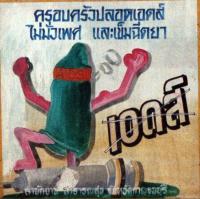 Bangkok also had a very big "scene", centered on Khao San Road.
It was slightly more radical in 1993 than in 2000. I don't know how it's fared in the years since.
The crowd of people there was mostly separate from the sex tourists and package tour groups to be found in various other areas of Bangkok.
Most were backpackers passing through Bangkok on their way to various destinations in south-east Asia.
Within a five minute walk from any of the guesthouses on “Farang Street” one could find necessities and entertainment.
In fact, it was quite possible to spend all of your time within the same two blocks, eating in the cheap restaurants and watching the movies they all played.
Many people did so, and I succumbed for a while myself, tempted by cheap food and huge mounds of books for sale.
Bangkok also had a very big "scene", centered on Khao San Road.
It was slightly more radical in 1993 than in 2000. I don't know how it's fared in the years since.
The crowd of people there was mostly separate from the sex tourists and package tour groups to be found in various other areas of Bangkok.
Most were backpackers passing through Bangkok on their way to various destinations in south-east Asia.
Within a five minute walk from any of the guesthouses on “Farang Street” one could find necessities and entertainment.
In fact, it was quite possible to spend all of your time within the same two blocks, eating in the cheap restaurants and watching the movies they all played.
Many people did so, and I succumbed for a while myself, tempted by cheap food and huge mounds of books for sale.
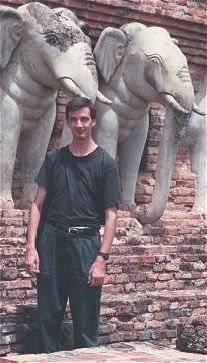 When I finally did manage to pry myself free of Bangkok the rest of my trip through Thailand went quickly.
I saw the ruins of Ayutthaya and Sukhothai; they consisted mostly of simple stone shrines and temples.
I spent a few days up at Mae Sot on the Burmese border and goofed off for a few days at Kanchanaburi.
I was generally struck how most people in almost all of these places did nothing much almost all of the time.
The heat encouraged this, and the height of activity for most foreigners seemed to be a binge of sex and drugs, not necessarily in that order.
Thais seemed little more active. There were tourist sights all around, mostly temples and old ruins.
However, the lure of temples wore off quickly and the ruins didn’t appeal for long.
Tramping around Hill Tribe country again didn’t appeal to me, and when these attractions were taken away about the only remaining attraction in Thailand was its comfort and easy life.
For a while I enjoyed that, but before long became bored and moved on south.
When I finally did manage to pry myself free of Bangkok the rest of my trip through Thailand went quickly.
I saw the ruins of Ayutthaya and Sukhothai; they consisted mostly of simple stone shrines and temples.
I spent a few days up at Mae Sot on the Burmese border and goofed off for a few days at Kanchanaburi.
I was generally struck how most people in almost all of these places did nothing much almost all of the time.
The heat encouraged this, and the height of activity for most foreigners seemed to be a binge of sex and drugs, not necessarily in that order.
Thais seemed little more active. There were tourist sights all around, mostly temples and old ruins.
However, the lure of temples wore off quickly and the ruins didn’t appeal for long.
Tramping around Hill Tribe country again didn’t appeal to me, and when these attractions were taken away about the only remaining attraction in Thailand was its comfort and easy life.
For a while I enjoyed that, but before long became bored and moved on south.
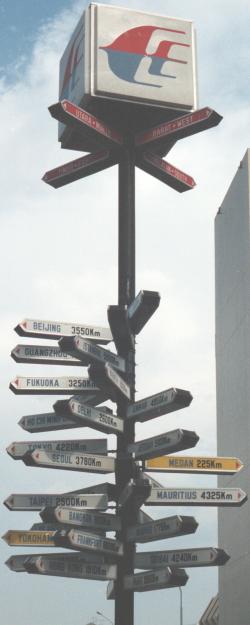 On my way south I stopped for the night in a village called Chumphon.
In the hotel there I was woken from a sound sleep in a pitch black room by a loud sound rather like a cross between a machine gun and a space alien ray gun.
“BRRR-RR-RR-RRR-RR”.
I sat up straight, trying and failing to see anything in the darkness. I went back to sleep and it happened again. It sounded very close.
Then it changed: “BRRRR-RRR-RRR-RRR GE-KO GE-KO GE-KO”.
I turned on the light to see all that noise coming from a Gecko, a little lizard about 20 cm long sitting on a beam under the roof.
I’d seen many of these before, all over Asia, but that was the first one I'd heard.
On my way south I stopped for the night in a village called Chumphon.
In the hotel there I was woken from a sound sleep in a pitch black room by a loud sound rather like a cross between a machine gun and a space alien ray gun.
“BRRR-RR-RR-RRR-RR”.
I sat up straight, trying and failing to see anything in the darkness. I went back to sleep and it happened again. It sounded very close.
Then it changed: “BRRRR-RRR-RRR-RRR GE-KO GE-KO GE-KO”.
I turned on the light to see all that noise coming from a Gecko, a little lizard about 20 cm long sitting on a beam under the roof.
I’d seen many of these before, all over Asia, but that was the first one I'd heard.
I arrived in Penang just in time to celebrate the first anniversary of my arrival in Asia. Then I continued on to Sumatra, landing in Medan and winding my way up on a clanking overloaded bus, to a high plateau. The local people, Bataks, had allegedly practiced cannibalism many years back but had long since been Christianized. They built interesting houses shaped rather like a pair of bull horns, and speckled the landscape with carved stone furniture and monuments. Despite the cool mountain air, wildlife to watch, and gross scenic attractions, a lot of foreigners there seemed interested in much the same things as in Thailand. Brastagi attracted a more athletic crowd of tourists, most headed for Gunung Leuser National Park and its Orang-Utan sanctuary, but Lake Toba had a large crowd of idlers.
The bus to Bukittingi stopped twice on its way south.
First we toured a glorious hot springs area built high with accumulated sulfur deposits, holding pools of water coloured by dissolved minerals.
Then late at night we crossed the equator and stopped to see the accumulated monuments the Indonesians had put up to mark the spot.
Bukittingi overlooked a wide forested canyon, with scenery comparable to that in the Batak highlands.
It lacked special tourist sights, offering a pathetic zoo and some nondescript tunnels carved by the Japanese in World War II.
I found their mobile post office more interesting, a postal counter set up in the back of a small van.
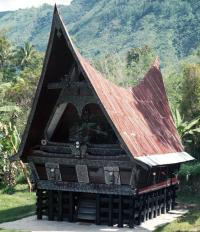
From Bukittingi south I took a luxury coach which turned out to be a Karaoke bus, with a monitor set into the roof and passengers singing into a microphone that they passed around. If you thought video buses were a nightmare, you would find one of these a vision from Hell. Fortunately the Indonesians had decent taste in music, so I didn’t go crazy. A few hours out of Bukittingi we came out of the hills and the rest of Sumatra sailed by, a sea of flat scrub. On the ferry crossing to Java we passed some large platforms in a bay, fish traps or farms of some sort. Then we drove on, skirting the hills as we headed into Java, to Jakarta.

Most visitors seem to think Jakarta is ugly, and I agree with their opinion. What I saw of it consisted largely of standard Asian concrete blocks, with a strip of modern skyscrapers, and a backpacker’s ghetto with a few slightly older buildings. Back streets sported open sewers and walled compounds presumably containing houses. Old Jakarta looked slightly better, a bit like a typical European town. My girlfriend flew in here. We took care of business and visited the National Museum, then left for Yogyakarta.
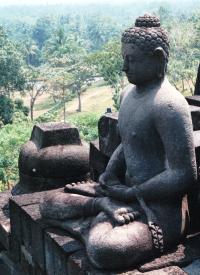 Yogyakarta appealed more than Jakarta, with interesting narrow winding streets and old buildings. The air smelled of spices as well.
Outside of town stood some truly old ruins, most famous of which was the colossal Buddhist stupa at Borobudur.
This loomed on a hill overlooking rolling countryside.
South of the city we found a silver market selling choice items.
In a day trip, I climbed the hills near Mount Merapi, a giant volcano not far from town.
The volcano itself is a tough climb but there are easier hikes near it, offering a glimpse of jungle-covered mountain slopes.
Finally we moved on again, passing the ancient Hindu temples at Prambanan.
Yogyakarta appealed more than Jakarta, with interesting narrow winding streets and old buildings. The air smelled of spices as well.
Outside of town stood some truly old ruins, most famous of which was the colossal Buddhist stupa at Borobudur.
This loomed on a hill overlooking rolling countryside.
South of the city we found a silver market selling choice items.
In a day trip, I climbed the hills near Mount Merapi, a giant volcano not far from town.
The volcano itself is a tough climb but there are easier hikes near it, offering a glimpse of jungle-covered mountain slopes.
Finally we moved on again, passing the ancient Hindu temples at Prambanan.
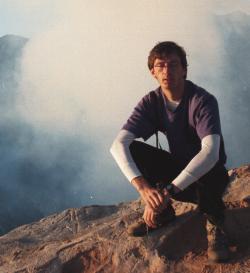 From Yogyakarta we rode a bus to Mount Bromo.
This volcano sits, with a few others, inside a gigantic caldera.
We took the usual approach, staying at a nearby guest house then getting up in the middle of the night to see the sunrise from the volcano rim.
The moon shone that night so we could see a sort of ghostly view of the countryside, and a long line of people tramping from the caldera rim up the volcano.
They were pursued by an even larger number of very annoying and persistent touts trying to sell horse rides.
The touts generated business for themselves; after spending hours fighting with them, one was much more likely to be so tired as to need a horse ride.
At the rim of Mount Bromo, everyone turned left on the crater rim and sat on the same small piece of land to watch the sunrise.
That is, everyone turned left except the two of us and a Japanese man.
We turned right and had a nice view of both the sunrise and the huge crowd of people unable to see anything besides each other.
All things considered, the night-time climb proved disappointing.
The landscaped improved markedly in daytime, appearing grey and brown and dusty, with a stink of sulfur in the air and great belching clouds.
From Yogyakarta we rode a bus to Mount Bromo.
This volcano sits, with a few others, inside a gigantic caldera.
We took the usual approach, staying at a nearby guest house then getting up in the middle of the night to see the sunrise from the volcano rim.
The moon shone that night so we could see a sort of ghostly view of the countryside, and a long line of people tramping from the caldera rim up the volcano.
They were pursued by an even larger number of very annoying and persistent touts trying to sell horse rides.
The touts generated business for themselves; after spending hours fighting with them, one was much more likely to be so tired as to need a horse ride.
At the rim of Mount Bromo, everyone turned left on the crater rim and sat on the same small piece of land to watch the sunrise.
That is, everyone turned left except the two of us and a Japanese man.
We turned right and had a nice view of both the sunrise and the huge crowd of people unable to see anything besides each other.
All things considered, the night-time climb proved disappointing.
The landscaped improved markedly in daytime, appearing grey and brown and dusty, with a stink of sulfur in the air and great belching clouds.
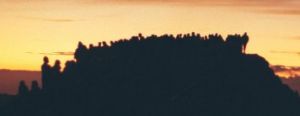 We headed down, then on to a marathon bus ride to Bali, getting off in Kuta.
Depending on who you talk to, Kuta would sound like a paradaisical transplanted Australian beach resort or a hell hole transplanted from Tijuana.
While not feeling much like Asia, it had its advantages; cheap food and drinks, nice beaches, and the omnipresent backpacker cafes with free movies.
We headed down, then on to a marathon bus ride to Bali, getting off in Kuta.
Depending on who you talk to, Kuta would sound like a paradaisical transplanted Australian beach resort or a hell hole transplanted from Tijuana.
While not feeling much like Asia, it had its advantages; cheap food and drinks, nice beaches, and the omnipresent backpacker cafes with free movies.
From Kuta we ascended to Ubud, somewhat higher in altitude and a bit cooler. Ubud began life as a farming village, but then foreigners discovered it and various sorts of artists and travellers moved in. Concrete began to appear around town and guest houses sprouted like mushrooms. By the time of our arrival it had become an upmarket alternative to Kuta, attracting a less raucous crowd but nonetheless dominated by tourism. It offered endless shops filled with handicrafts and clothes for sale, plus some pleasant walks and the usual sort of easy living. I liked it and returned a couple times in later years.
 After a few days there, we came back down the hill and caught a ferry across a narrow channel to Lombok.
This smaller island is much less developed than Bali but offers similar attractions.
For us, as for many people, it was merely a first step on to see further islands — perhaps Flores, Komodo and Timor.
However, we ran out of time and energy for south-east Asia here and decided to leave.
After a few days there, we came back down the hill and caught a ferry across a narrow channel to Lombok.
This smaller island is much less developed than Bali but offers similar attractions.
For us, as for many people, it was merely a first step on to see further islands — perhaps Flores, Komodo and Timor.
However, we ran out of time and energy for south-east Asia here and decided to leave.
In short order we had flown to Singapore and booked tickets there to Istanbul, flying through Kuala Lumpur. We quickly toured Singapore itself. I didn’t think much of it; although pleasant, it resembled a big shopping mall. It did, however, have some good shops selling camping gear that we would use later, and the zoo was well worth visiting. We travelled north to Penang, stopping at Melacca and Kuala Lumpur. I found both pleasant but boring, a verdict that summarizes many places in Thailand and Malaysia. They were relatively well-developed cities with comforts and attractions but not offering a lot to visitors who only stayed for a very short while, as we did. We continued to Penang, which is also not exciting but which has good food and a pleasant atmosphere, and is still my favourite place in SE Asia.
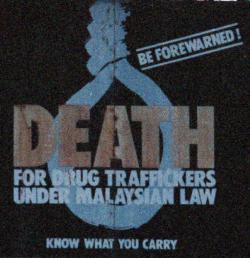
While waiting for flights I headed down the east coast, through Khota Baru and Kuala Terengganu. These two towns contrasted sharply with the west side of the island, being much more conservative and less developed. The eastern beaches, on the South China Sea, were nicer than those on the west side of the Peninsula, and the atmosphere was relaxing although not exciting. Here again I found myself in the same sort of situation I'd been in earlier in Sumatra. The fun things to do here all involved tramping around nature in the centre of the peninsula, but I didn’t have time to do it then. After a few days of this boredom, I went back to Singapore to bury myself in preparations for the upcoming Africa leg of my trip.
The Middle East 1993
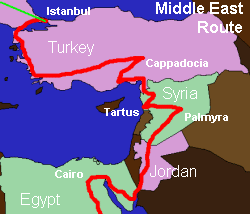 Balkan Bulgarian Airlines carried us to Istanbul comfortably, with a day-long stop in Sofia.
They had just opened the Kuala Lumpur route then, and it showed.
Passengers tried to stretch out in the unused two-thirds of seats, only to be loudly informed that wasn’t allowed.
Communist service standards still prevailed in some areas.
Balkan Bulgarian Airlines carried us to Istanbul comfortably, with a day-long stop in Sofia.
They had just opened the Kuala Lumpur route then, and it showed.
Passengers tried to stretch out in the unused two-thirds of seats, only to be loudly informed that wasn’t allowed.
Communist service standards still prevailed in some areas.
Istanbul seemed a patchwork of contrasting ancient and modern blocks.
We camped in the western suburbs, in a modern campground on the sea, across a busy road from housing estates which looked to have been transported from France.
Buses and various grades of railway carried us handily into the centre of town where we disembarked in front of Aya Sofiya, built almost fifteen
hundred years ago by the Emperor Justinian to be the centre of Christianity in the Roman world.
Up the hill sat a busy market which, one felt, had changed over hundreds of years only in the goods it sold.
Roads worked their way around old fortifications, and the comparatively modern palace and mosques of the Ottoman Sultans commanded the best views on hills
overlooking the city and across to Asia Minor.

Istanbul's food was also one of its outstanding attractions, as great as its ruins. Restaurants served up all the usual varieties of kebabs and pides one associates with Turkey, as well as all the various sorts of food to be found in Greece and many Arab countries (which not long ago were Ottoman territories). Smaller shops specialized in fruit & nuts and various sorts of sweets. Fishermen roasted their catch in boats moored at docks, and served up tasty sandwiches. Market stalls served even tastier sandwiches made with kokorec, chopped and spiced lamb intestines.
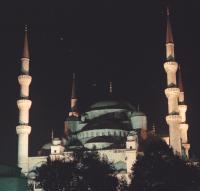 Seeing the sights took about ten days, although we could have spent months or maybe even years at it.
Workmen were renovating Aya Sofiya but some of its charm still showed through the construction.
That was particularly true of the domes in its main hall, which caught sunlight in such a way they seemed to glow.
Nearby, a giant underground cistern sat where it had since Roman days, disused now so tourists could descend to it and see its curious carved columns.
Seeing the sights took about ten days, although we could have spent months or maybe even years at it.
Workmen were renovating Aya Sofiya but some of its charm still showed through the construction.
That was particularly true of the domes in its main hall, which caught sunlight in such a way they seemed to glow.
Nearby, a giant underground cistern sat where it had since Roman days, disused now so tourists could descend to it and see its curious carved columns.
 The most spectacular of all these sights was the Topkapi, the palace of the old Ottoman Sultans.
The collection of treasure there astounded me.
It featured a statue of the Sultan made from a giant pearl, a miniature palace sketch made of gold and gems from Japan, a dagger with a solid emerald handle, and
the alleged hand and occipital bone of John the Baptist, among other less opulent items.
The most spectacular of all these sights was the Topkapi, the palace of the old Ottoman Sultans.
The collection of treasure there astounded me.
It featured a statue of the Sultan made from a giant pearl, a miniature palace sketch made of gold and gems from Japan, a dagger with a solid emerald handle, and
the alleged hand and occipital bone of John the Baptist, among other less opulent items.
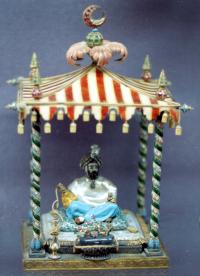 We made a day-long side trip to Bursa, on the other side of the Sea of Marmara.
A cable car ascends a mountain there, where people ski in winter.
The city was pleasant but seemed to be special only in having a particularly good kebab named after it.
On another day trip we went to peek at the Black Sea from Kumköy, a village just outside Istanbul.
We made a day-long side trip to Bursa, on the other side of the Sea of Marmara.
A cable car ascends a mountain there, where people ski in winter.
The city was pleasant but seemed to be special only in having a particularly good kebab named after it.
On another day trip we went to peek at the Black Sea from Kumköy, a village just outside Istanbul.
Back in Istanbul, I had accumulated a few books and wanted to get rid of them, so we sat for a few hours in a city park with a stack of books and a “For Sale” sign. I used this trick in a few different places; simply setting them out with a notice. The books moved quickly and it had the added benefit of breaking the ice with people, making it easier to meet them. In this case we met a man named Hakan who introduced us to his family and friends, and that kept us busy for a few more days in Istanbul. It was getting easier to stay the longer we were there, but eventually we tore ourselves away and started a series of bus rides around the country.
Mostly we toured ruins in Turkey.
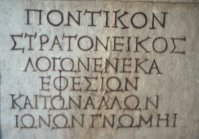 We first stopped at Çanakkale, which boasted two major attractions: the battlefields of Gallipoli (and war cemeteries), and the ruins of Ancient Troy.
We were interested in the latter.
The government had erected a giant wooden Trojan Horse at the site but it didn’t ruin a worthwhile stop.
The "ruins of Troy" actually consist of nine separate sets of cities (presumably ruined before being rebuilt on top of each other).
The Troy of Greek legend is thought to be sixth in the sequence.
When I saw the city, I wondered at its small size.
The reconstructed ruins would amount to only about fifteen buildings.
Does this mean these cities were much smaller than we would expect?
Does it suggest there was a much larger area of wood buildings which haven’t survived? I’ve never found an answer to that
question.
We first stopped at Çanakkale, which boasted two major attractions: the battlefields of Gallipoli (and war cemeteries), and the ruins of Ancient Troy.
We were interested in the latter.
The government had erected a giant wooden Trojan Horse at the site but it didn’t ruin a worthwhile stop.
The "ruins of Troy" actually consist of nine separate sets of cities (presumably ruined before being rebuilt on top of each other).
The Troy of Greek legend is thought to be sixth in the sequence.
When I saw the city, I wondered at its small size.
The reconstructed ruins would amount to only about fifteen buildings.
Does this mean these cities were much smaller than we would expect?
Does it suggest there was a much larger area of wood buildings which haven’t survived? I’ve never found an answer to that
question.
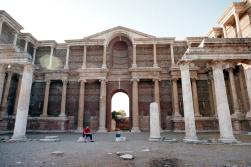 After Çanakkale we spent a night in Izmir, a modern and uninteresting city.
A day trip from there took us to the ruins of Sardis, east of the city.
These had decayed greatly since the city was built some three thousand years ago, so that now there are only a few buildings to see.
One of them is the best-excavated ancient synagogue known, which still showed elaborate mosaic walls and floors.
People in general there were very friendly.
After Çanakkale we spent a night in Izmir, a modern and uninteresting city.
A day trip from there took us to the ruins of Sardis, east of the city.
These had decayed greatly since the city was built some three thousand years ago, so that now there are only a few buildings to see.
One of them is the best-excavated ancient synagogue known, which still showed elaborate mosaic walls and floors.
People in general there were very friendly.
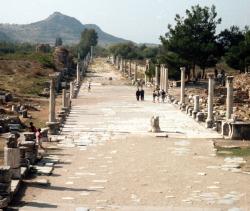 We continued to Selcuk, where lay the ruins of ancient Ephesus.
I enjoyed tramping through them, despite being accosted by the most obnoxious guide I’ve ever met.
He called us idiots and insulted us in front of his paying customers when we politely told him we’d rather tour on our own.
Ephjesus compared very favourably to other ancient sites I’d seen, for preservation and scale.
In its heyday Ephesus was apparently the fourth largest city in the Roman Empire, and it was still relatively easy to picture what the city must have looked like then.
We continued to Selcuk, where lay the ruins of ancient Ephesus.
I enjoyed tramping through them, despite being accosted by the most obnoxious guide I’ve ever met.
He called us idiots and insulted us in front of his paying customers when we politely told him we’d rather tour on our own.
Ephjesus compared very favourably to other ancient sites I’d seen, for preservation and scale.
In its heyday Ephesus was apparently the fourth largest city in the Roman Empire, and it was still relatively easy to picture what the city must have looked like then.
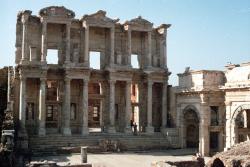 Tourists entered on the Arcadian Way, passing a gigantic theatre which could hold 25,000 people, and a smaller stadium which could seat half as many.
Along the ruined road sat ancient facades, including the spectacular ruins of the library. Columns and stones still contained inscribed Greek and Latin writings.
Scattered around sat other less glorious ruins; a temple of St. John, the supposed house of the Virgin Mary, and the mosque of Isa Bey.
On a warm afternoon taking these in, I sat down on a ruined wall to rest.
I opened my guidebook and realized I was sitting on one of the Seven Wonders of the World — the Temple of Artemis. Little remained of it.
Tourists entered on the Arcadian Way, passing a gigantic theatre which could hold 25,000 people, and a smaller stadium which could seat half as many.
Along the ruined road sat ancient facades, including the spectacular ruins of the library. Columns and stones still contained inscribed Greek and Latin writings.
Scattered around sat other less glorious ruins; a temple of St. John, the supposed house of the Virgin Mary, and the mosque of Isa Bey.
On a warm afternoon taking these in, I sat down on a ruined wall to rest.
I opened my guidebook and realized I was sitting on one of the Seven Wonders of the World — the Temple of Artemis. Little remained of it.
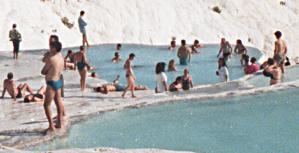 A brief side-trip from Selçuk took us to Pamukkale, which had a few ruins but was famed as a geological wonder.
Hot springs came out of a hillside here carrying heavy loads of mineral sediment which formed terraced pools as they descended the hillside.
This made it a popular place to sit and bathe, soaking up heat from two directions.
A brief side-trip from Selçuk took us to Pamukkale, which had a few ruins but was famed as a geological wonder.
Hot springs came out of a hillside here carrying heavy loads of mineral sediment which formed terraced pools as they descended the hillside.
This made it a popular place to sit and bathe, soaking up heat from two directions.
On the road again, we cruised through a number of towns with various sites and landmarks. Bodrum offered the ancient Mausoleum of Halicarnassus, of which unfortunately nothing remained. Fethiye rested beneath cliffs with giant rock-cut tombs. Antalya sported a beautiful harbour and all these places had good food and common ruins such as ancient walls. After Antalya, we turned inland to visit Cappadocia.
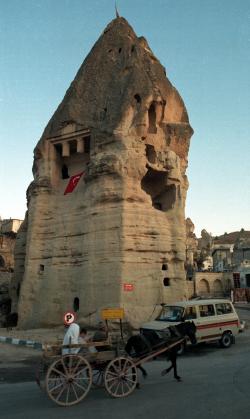 This engaged our interest much more and we would have stayed longer, except that it had got quite frigid by that time (late October).
A long-dead volcano had covered the area around Cappadocia with a thick layer of volcanic ash, which with time had become a form of rock that could be dug into fairly easily.
As long ago as four thousand years, people began carving houses into cliff sides here and underground.
The area had been an Assyrian trading post, a Hittite state, a Greek territory, a semi-independent Persian Kingdom, and a Roman and Byzantine territory.
It sat near one end of the Silk Road and thrived on traffic, even making silk locally.
When Islam began to spread and religious wars erupted, Christians dug underground cities here for protection.
So far around forty of these have been discovered in the valley, with two open to the
public. While exploring one I found a long passage running off into darkness, but didn’t follow it.
This engaged our interest much more and we would have stayed longer, except that it had got quite frigid by that time (late October).
A long-dead volcano had covered the area around Cappadocia with a thick layer of volcanic ash, which with time had become a form of rock that could be dug into fairly easily.
As long ago as four thousand years, people began carving houses into cliff sides here and underground.
The area had been an Assyrian trading post, a Hittite state, a Greek territory, a semi-independent Persian Kingdom, and a Roman and Byzantine territory.
It sat near one end of the Silk Road and thrived on traffic, even making silk locally.
When Islam began to spread and religious wars erupted, Christians dug underground cities here for protection.
So far around forty of these have been discovered in the valley, with two open to the
public. While exploring one I found a long passage running off into darkness, but didn’t follow it.
When we finally had to move on again, we travelled south through the Cilician Gates to Mersin. We debated visiting Northern Cyprus from there but decided not to. Nearby were a couple of famous caves, Cennet and Cehennem (Gennet and Gehenna) which made a nice stop. Then we pressed on to Antakya (Antioch), the last stop in Turkey.
Despite stiff competition, Antakya had perhaps the most dramatic scenery of any of the towns we’d visited in Turkey. It sits in a small bay surrounded by steep and rocky crags. The town is not historically Turkish, and many residents are Arabs. Short walks into the hills led to interesting caves and tunnels and ancient fortifications. They also may have led to Syria, the border of which was very close. Antioch is relatively young by Turkish standards, existing only since the time of Alexander’s conquests, around 300 B.C. It’s most famous for being the location of the first Christian Church. They met in a cave which can still be visited, but which is bare now with only a few remnant decorations on the wall.
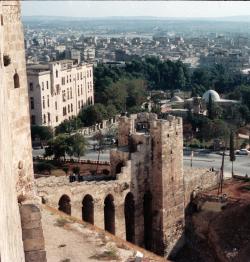 The border crossing to Syria involved considerable hassle.
After a couple hours our bus got free of it and arrived in Aleppo.
A guide met us at the bus stop, promising to help us find a hotel for no extra cost.
I, naturally, didn’t believe him but his tone was unusual: "I think that hotel is full BUT if you want to go check, no problem, let’s go."
We let him demonstrate that he was right and he did find us a hotel and never did ask for any money.
I had thought Turkey easy going but we quickly discovered Syria was even easier still.
The border crossing to Syria involved considerable hassle.
After a couple hours our bus got free of it and arrived in Aleppo.
A guide met us at the bus stop, promising to help us find a hotel for no extra cost.
I, naturally, didn’t believe him but his tone was unusual: "I think that hotel is full BUT if you want to go check, no problem, let’s go."
We let him demonstrate that he was right and he did find us a hotel and never did ask for any money.
I had thought Turkey easy going but we quickly discovered Syria was even easier still.
Aleppo bustled with a surprising variety of people in all sizes and shapes and with all colours of eyes and hair. Traders visited from as far away as Russia and Armenia. In the centre of the city, a giant citadel towered on a hill, looking down on more modern buildings. The site had first been used by the ancient Greeks, and the fortifications had been built in the days of the Seleucids. Not far from it wound a very colorful souk selling all sorts of small things. Shops and restaurants in the more modern parts of town seemed to love neon signs, which glared everywhere one looked. Walls sported revolutionary posters and pictures of Hafez el-Assad.
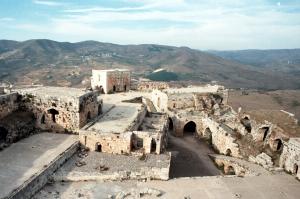 Leaving Aleppo, we took a bus ride through dusty brown countryside until we arrived at the port of Tartus, not far from the border with Lebanon.
Modern concrete blocks lined roads in the better parts of town while crumbling brick walls and decaying building interiors typified the poorer parts.
The city itself didn’t have a lot to see. Obnoxious boys chased us around town making lewd gestures and lecherous men made passes at my girlfriend.
The island of Arwad off the coast was more colourful, an old crusader fort, but the people there seemed actively hostile to foreigners.
This was unusual in Syria.
The norm were shopkeepers who would drag us inside their shops to force free coffee on us and chat and sometimes, only sometimes, remember to ask if we wanted to buy anything.
Leaving Aleppo, we took a bus ride through dusty brown countryside until we arrived at the port of Tartus, not far from the border with Lebanon.
Modern concrete blocks lined roads in the better parts of town while crumbling brick walls and decaying building interiors typified the poorer parts.
The city itself didn’t have a lot to see. Obnoxious boys chased us around town making lewd gestures and lecherous men made passes at my girlfriend.
The island of Arwad off the coast was more colourful, an old crusader fort, but the people there seemed actively hostile to foreigners.
This was unusual in Syria.
The norm were shopkeepers who would drag us inside their shops to force free coffee on us and chat and sometimes, only sometimes, remember to ask if we wanted to buy anything.
On a day trip from Tartus, we visited the Crac-des-Chevaliers, a giant Crusader fortress built on a strategic hilltop overlooking a gap in the coastal mountains. The ruins were well-preserved and much of the interior had been restored so it was possible to wander around large parts of the castle. The Crac was never defeated; the Mamelukes won the site by forging a letter which tricked the Crusaders into believing their cause was lost and that they should surrender.
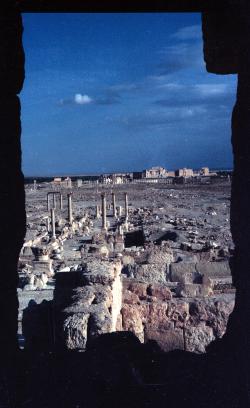 After Tartus and the Crac, we spent a few days at Tadmor, in the desert.
Here sat the ruins of Palmyra, first built some three or four thousand years ago and mentioned in countless historical documents.
In Roman times it had been a great trading city and the setting for one of Imperial Rome’s more interesting dramas.
Palmyra then was a Roman Colony, but around the year 269 AD its queen, Zenobia, declared independence and tried to set up her own independent state.
Since Palmyra sat squarely on the Silk Road and was in a position to control its traffic and get rich on taxes, there was considerable advantage to this.
The Romans disagreed, however, and so invaded and carried away Queen Zenobia in chains.
The Arabs took Palmyra early in the spread of Islam and it declined to ruins as its importance vanished.
There are few intact buildings left to see now from the Roman era, but compared to contemporary sites such as Ephesus it nevertheless looked quite well preserved.
The area itself (an oasis) was interesting in its own right, with an Arab castle on a nearby hill and Bedouin wandering not far from town.
After Tartus and the Crac, we spent a few days at Tadmor, in the desert.
Here sat the ruins of Palmyra, first built some three or four thousand years ago and mentioned in countless historical documents.
In Roman times it had been a great trading city and the setting for one of Imperial Rome’s more interesting dramas.
Palmyra then was a Roman Colony, but around the year 269 AD its queen, Zenobia, declared independence and tried to set up her own independent state.
Since Palmyra sat squarely on the Silk Road and was in a position to control its traffic and get rich on taxes, there was considerable advantage to this.
The Romans disagreed, however, and so invaded and carried away Queen Zenobia in chains.
The Arabs took Palmyra early in the spread of Islam and it declined to ruins as its importance vanished.
There are few intact buildings left to see now from the Roman era, but compared to contemporary sites such as Ephesus it nevertheless looked quite well preserved.
The area itself (an oasis) was interesting in its own right, with an Arab castle on a nearby hill and Bedouin wandering not far from town.
Before leaving Syria we stopped in Damascus, arguably the oldest city in the world and certainly one of its most famous. It nevertheless wasn’t as colourful or interesting as other places in Syria. The Umayyad Mosque and National Museum were good sights to see, and there was lots of food, but a couple days of this was enough and then we were ready to move on to Jordan.
We crossed the border in a shared taxi, piled high with people and goods, then wound our way through anonymous roads and alleys and lanes without much idea where we were. Finally we appeared in Amman. Although a pleasant and relatively modern city (sporting a huge Safeways) built on the site of the great ancient Roman city of Philadelphia, it nevertheless didn’t offer a lot by itself. Still, it was a comfortable base for a couple of day trips. North of Amman lay the ruins of Jerash, another ancient Roman city and much better preserved than the few ruins around Amman.
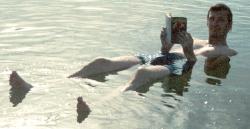 South of Amman, another convenient day trip took us to the Dead Sea.
This gigantic puddle holds so much dissolved salt that it is very difficult to sink on it, so legions of tourists come to lie on their backs and soak up a bit of sun.
Many considered it a beauty treatment to obtain a salty crust this way, or from a mud bath.
While floating high on the water there, the thought struck me that I could have floated all the way across to Israel, except of course that Israeli border guards might have shot me.
I couldn’t sink if I tried, so any time I got tired of swimming I could just stop and float.
South of Amman, another convenient day trip took us to the Dead Sea.
This gigantic puddle holds so much dissolved salt that it is very difficult to sink on it, so legions of tourists come to lie on their backs and soak up a bit of sun.
Many considered it a beauty treatment to obtain a salty crust this way, or from a mud bath.
While floating high on the water there, the thought struck me that I could have floated all the way across to Israel, except of course that Israeli border guards might have shot me.
I couldn’t sink if I tried, so any time I got tired of swimming I could just stop and float.
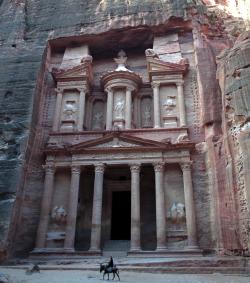 The greatest and most famous sight in Jordan was our last stop, the ruined city of Petra in a canyon in the south of the country.
The Nabateans, an early Arab nation, had carved temples and monumental facades into the sandstone walls of the canyon, adopting a Greek style without actual freestanding columns.
Nowadays one enters through the Siq, a narrow winding crack which suddenly opens into a sort of natural courtyard.
Overlooking the courtyard is the Khasneh, an ancient treasury which you might perhaps recognize as the temple of the Holy Grail from “Indiana Jones and the Last Crusade”.
Many other imposing facades had been carved around the site, but inside almost all these led to simple squared rock chambers.
I found that somewhat disappointing.
The greatest and most famous sight in Jordan was our last stop, the ruined city of Petra in a canyon in the south of the country.
The Nabateans, an early Arab nation, had carved temples and monumental facades into the sandstone walls of the canyon, adopting a Greek style without actual freestanding columns.
Nowadays one enters through the Siq, a narrow winding crack which suddenly opens into a sort of natural courtyard.
Overlooking the courtyard is the Khasneh, an ancient treasury which you might perhaps recognize as the temple of the Holy Grail from “Indiana Jones and the Last Crusade”.
Many other imposing facades had been carved around the site, but inside almost all these led to simple squared rock chambers.
I found that somewhat disappointing.
Tourists in Syria and Jordan were quite rare so we got to know each other fairly well. About a dozen of us from Europe, Canada and the USA were on our way to Egypt and from there to such scattered destinations as Capetown, Pakistan and our homes. In Jordan we also met an interesting variety of non-tourists, including several Iraqi refugees. One of the Iraqis told us fondly how they had been close to having nuclear weapons with which they could have annihilated Israel. Then he let out a wistful sigh, shook his head and reluctantly allowed that was all over now, since the war with the Americans. One could almost see his happy dreams of mushroom clouds over Tel Aviv. Jordan also contained many Palestinians, some of whom had been born after 1967 and thus had never actually been to Palestine, but who had fiery nationalist ambitions nonetheless.
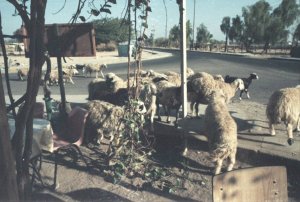 An easy shared-taxi ride took us from Petra to Aqaba. From there we caught a ferry across the Red Sea to Nuweiba, in Sinai.
Differences between Egypt and Jordan made themselves obvious very quickly.
No sooner had we cleared passport control in Sinai than a crowd of people began cajoling us and trying to coax us into a taxi for the trip to wherever we were going.
Since the night was pitch-black and we could see nothing of where we were, this didn’t require a lot of decision.
It did require some bargaining to get a reasonable price, but we managed that and found our way to a simple beach camp site at Tarabin.
This was quite spartan but there was enough to eat and its primitive surroundings proved relaxing, so we rested there a couple days before heading inland.
An easy shared-taxi ride took us from Petra to Aqaba. From there we caught a ferry across the Red Sea to Nuweiba, in Sinai.
Differences between Egypt and Jordan made themselves obvious very quickly.
No sooner had we cleared passport control in Sinai than a crowd of people began cajoling us and trying to coax us into a taxi for the trip to wherever we were going.
Since the night was pitch-black and we could see nothing of where we were, this didn’t require a lot of decision.
It did require some bargaining to get a reasonable price, but we managed that and found our way to a simple beach camp site at Tarabin.
This was quite spartan but there was enough to eat and its primitive surroundings proved relaxing, so we rested there a couple days before heading inland.
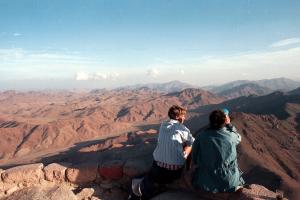 Our only other stop in Sinai was at St. Catherine’s, under Mount Sinai. We arrived there partway through the day and didn’t plan to stay too long.
I scrambled up Mount Sinai, collecting scenic photos and negotiating an interesting descent in the dark down three thousand
steps which had been carved into the mountainside by a penitent pilgrim.
We settled into a hotel that night and in the morning began looking for transport.
This was easy to find; a taxi driver appeared and announced he would take us to Cairo as soon as he had collected everyone who wanted to go.
We thought this assumption boded poorly for our wallets and began looking for a bus.
It didn’t take long to discover there was no convenient bus, and in the end we were quite satisfied with his driving and reasonable cost anyway.
Sinai went by quickly. At the Suez Canal we had to decide between taking a ferry and riding through the tunnel.
We opted for the ferry, snapping a few illegal photos of the canal along the way, and entered Africa.
Our only other stop in Sinai was at St. Catherine’s, under Mount Sinai. We arrived there partway through the day and didn’t plan to stay too long.
I scrambled up Mount Sinai, collecting scenic photos and negotiating an interesting descent in the dark down three thousand
steps which had been carved into the mountainside by a penitent pilgrim.
We settled into a hotel that night and in the morning began looking for transport.
This was easy to find; a taxi driver appeared and announced he would take us to Cairo as soon as he had collected everyone who wanted to go.
We thought this assumption boded poorly for our wallets and began looking for a bus.
It didn’t take long to discover there was no convenient bus, and in the end we were quite satisfied with his driving and reasonable cost anyway.
Sinai went by quickly. At the Suez Canal we had to decide between taking a ferry and riding through the tunnel.
We opted for the ferry, snapping a few illegal photos of the canal along the way, and entered Africa.
North and East Africa 1994
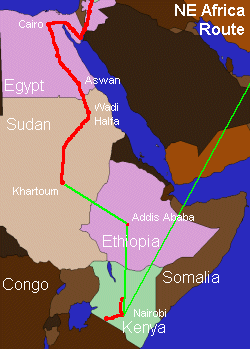 Upon arriving from Sinai, our shared-taxi dropped us in the middle of Cairo and we quickly found a cheap hotel in a decrepit building with no working lift and an unpredictable water supply.
The next day we began taking care of business; visas, plane tickets, etc.
When all our business processes were underway, we went out to see the sights.
First on the list were the Old Kingdom pyramids and the Sphinx at Giza.
These are possibly the most famous monuments in the world, and attracted hordes of crowds.
It was officially forbidden to climb the pyramids but many people seemed to do it anyway, by hiring a guide who would bribe the right people, then ascending at night to see the sunrise.
We weren’t interested, however.
Also at Giza sat the City of the Dead, an ancient cemetery which also serves as a home for very poor living people.
Upon arriving from Sinai, our shared-taxi dropped us in the middle of Cairo and we quickly found a cheap hotel in a decrepit building with no working lift and an unpredictable water supply.
The next day we began taking care of business; visas, plane tickets, etc.
When all our business processes were underway, we went out to see the sights.
First on the list were the Old Kingdom pyramids and the Sphinx at Giza.
These are possibly the most famous monuments in the world, and attracted hordes of crowds.
It was officially forbidden to climb the pyramids but many people seemed to do it anyway, by hiring a guide who would bribe the right people, then ascending at night to see the sunrise.
We weren’t interested, however.
Also at Giza sat the City of the Dead, an ancient cemetery which also serves as a home for very poor living people.
Moving forward in time, we toured old Cairo (dating from Roman times) and wandered the Khan-al-Khalili.
This was more interesting despite carrying much the same things we had seen sold in markets in Syria and Jordan.
The National Museum was well worth the afternoon we passed there, and despite being dirty and crowded Cairo was quite an interesting city to wander around.
In many ways it was surprisingly modern.
Syria and Jordan left memories of old ruins, even in the major cities.
Cairo actually had more ruins but the city left an image of concrete fixed in my mind.
Concrete ramps and elevated highways and oversized hotels seemed to be everywhere.
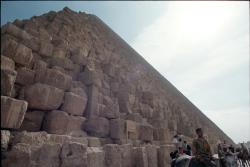
After a week or two we got tired of seeing Cairo and decided to venture south to Luxor. Our first impressions of the town were wholly negative. At the train station touts degenerated into a feeding frenzy while trying to sell us rooms. When we did find a room the hotel owner kept looking for ways to add charges to our bill. On our sole trip to the market a merchant tried a transparent and annoying sleight-of-hand trick. My girlfriend negotiated a price for some trinket and handed over money, expecting a fair amount of change. Then he told her “no, I meant British pounds” (as opposed to Egyptian pounds). This, naturally, made her quite angry and that seems to have been the intent: when she complained and demanded her money back the merchant angrily slapped a banknote into her hand and she started to stomp off. This would have ended badly had I not waded in at that point and opened her fist to show her that instead of returning her money, he had returned some small note close enough to being worthless. She then got her cash back along with a sheepish grin and an unconvincing apology from the market shark.
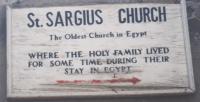 The country around Luxor is carpeted with ancient ruins; the temples of Luxor and Karnak, the Valley of Kings (and lesser valleys of queens and nobles), and an
endless supply of lesser temples and monuments built in a timespan of over a thousand years.
In theory, we could easily have spent weeks there seeing them all.
The scale of them was their most impressive feature.
The ancient Egyptians had built using columns of stone perhaps ten to fifteen metres high, then gone on to carve reliefs on seemingly every exposed surface.
Despite the attractions, the heat and annoying con men made us want to limit our time there, so after a few days we left again and went back to Cairo.
The country around Luxor is carpeted with ancient ruins; the temples of Luxor and Karnak, the Valley of Kings (and lesser valleys of queens and nobles), and an
endless supply of lesser temples and monuments built in a timespan of over a thousand years.
In theory, we could easily have spent weeks there seeing them all.
The scale of them was their most impressive feature.
The ancient Egyptians had built using columns of stone perhaps ten to fifteen metres high, then gone on to carve reliefs on seemingly every exposed surface.
Despite the attractions, the heat and annoying con men made us want to limit our time there, so after a few days we left again and went back to Cairo.
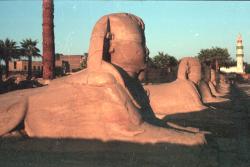 Early in our stay in Egypt, terrorists shot up a tourist bus in Cairo and murdered many of the passengers.
These incidents had been a regular feature of the news then and caused us some minor concern, but we had decided to go to Egypt anyway.
There was a fairly clear pattern to the attacks; they hit prominent package tour groups and guests at expensive hotels.
We kept a low profile and avoided both those things, so estimated we weren’t in much danger.
A bigger problem with the terrorists was that they had largely succeeded at their goal of killing the tourist industry.
This explained the ravenous hunger of the business people we had met in Luxor (and gave us some small idea of the trouble they must have been making for average Egyptians).
A few years later six gunmen murdered fifty-eight tourists and four Egyptians at the temple of Hatshepsut.
A rumour then had it that some of the Egyptian victims had died trying to protect the tourists.
I found it a curious and inspiring thought that if true, these same people an hour earlier had most likely been trying hard to overcharge those tourists they died protecting.
Early in our stay in Egypt, terrorists shot up a tourist bus in Cairo and murdered many of the passengers.
These incidents had been a regular feature of the news then and caused us some minor concern, but we had decided to go to Egypt anyway.
There was a fairly clear pattern to the attacks; they hit prominent package tour groups and guests at expensive hotels.
We kept a low profile and avoided both those things, so estimated we weren’t in much danger.
A bigger problem with the terrorists was that they had largely succeeded at their goal of killing the tourist industry.
This explained the ravenous hunger of the business people we had met in Luxor (and gave us some small idea of the trouble they must have been making for average Egyptians).
A few years later six gunmen murdered fifty-eight tourists and four Egyptians at the temple of Hatshepsut.
A rumour then had it that some of the Egyptian victims had died trying to protect the tourists.
I found it a curious and inspiring thought that if true, these same people an hour earlier had most likely been trying hard to overcharge those tourists they died protecting.
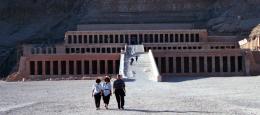
Historical note: in 1994 Sudan was still a single country, with much of the south and west no-go areas because of the ongoing civil war. Travel in the northeast was possible, but difficult and discouraged. Similarly, Eritrea had just split from Ethiopia after an exhausting series of wars. Both those countries were just beginning to rebuild, and still somewhat paranoiac.
My girlfriend went home, and Christmas came and New Year’s and finally I got my Sudanese visa. The way it arrived was almost ridiculous. I went to check on it and the official told me “Oh, maybe next week” again. He had told me this two or three weeks in a row. I asked “How long will I have to wait?” and his eyes lit up. “Wait? You are waiting?” The next day, I collected my visa. Do most people not care how long their visas take? Do they do something other than wait? Are there no tourists or business people, so that the only people who apply are government or UN aid workers happy to sit on their bottoms doing nothing?
I booked a ferry ticket from Aswan to Wadi Halfa and left. The first class train to Aswan cost six US dollars. Aswan was a dry little desert town, well-developed for tourism and resembling a beach resort in some ways. There I met a couple of brilliantly crazy Polish students attempting to make it to Eritrea and back within three weeks, for a short holiday. This seemed somewhere between unrealistic and impossible to me, but they insisted they could do it.
The ferry, an overcrowded and aging iron hulk, went overnight to Wadi Halfa. The three of us camped on the top deck, chatting with numerous keen and friendly Sudanese. The shore went by silently and the sky was crystal-clear. The ride was very peaceful and relaxing. Arrival was not. If you fly to Khartoum you may get the feeling it sits at the end of the universe, but that’s not true. Wadi Halfa is the end of the universe and looks the part. The town is nothing more than a brown pile of mud-brick houses with a few cinderblocks for variety, practically no place to eat and nothing to do. It had a couple cheap hotels, noteworthy only in being segregated into men’s and women’s areas (with no visible boundary between them). A small hill provided dramatic views of the rugged landscape.
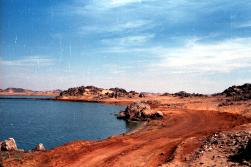 An American reporter joined us there. She had managed to get into Sudan despite having gone to Israel on the same passport, a noteworthy feat.
We booked four seats on a bus which was really a truck with seats, to Khartoum.
We didn’t want to wait for the train, because it might not have arrived for weeks.
The Polish guys wanted to know when the bus would go and a local man replied "It will go when it is full."
They wanted to know when that would be and a communication problem immediately developed.
The Sudanese man tried in his best broken English to explain that there simply was no schedule and we would wait six months if it took that long for the bus to fill.
“Ah, is no when, is no how long ...”
The Poles couldn’t adapt to this lack of scheduling and, more amazing, still thought they could get to Eritrea and back to Egypt in three weeks.
An American reporter joined us there. She had managed to get into Sudan despite having gone to Israel on the same passport, a noteworthy feat.
We booked four seats on a bus which was really a truck with seats, to Khartoum.
We didn’t want to wait for the train, because it might not have arrived for weeks.
The Polish guys wanted to know when the bus would go and a local man replied "It will go when it is full."
They wanted to know when that would be and a communication problem immediately developed.
The Sudanese man tried in his best broken English to explain that there simply was no schedule and we would wait six months if it took that long for the bus to fill.
“Ah, is no when, is no how long ...”
The Poles couldn’t adapt to this lack of scheduling and, more amazing, still thought they could get to Eritrea and back to Egypt in three weeks.
The bus actually departed a day and a half after we booked seats. Estimating how long it would take to reach Khartoum I worked out I would need about four litres of water for myself. I took nine instead, figuring some fool would make the ride without bringing enough water for himself. I was right. The Poles also had nine litres of water each but left almost all of this in their packs, which were tied to the roof and buried under mountains of gear. When we finally arrived in Khartoum they found their bottles smashed and their packs soaking.
This bus ride was more demanding than the ride to Hanoi months earlier, but I was prepared and didn’t mind it as much. We had only been able to get seats in the back, behind the rear wheels, so we bounced up and down all the way across the desert, following the east side of the Nile through Akasha, Abri, Delgo and Kerma until we finally came to Dongola. After crossing we followed the west bank south to Debba then set off across the desert straight to Omdurman. After five or six hours riding, I tuned out my surroundings and concentrated on hanging from the overhead bar. I found I could almost sleep in this position. Whenever the bus stopped I staggered off and fell asleep properly in the first patch of shade I could find. The scenery was an unending desert vista, with the occasional glimpse of greenery and mudbrick houses. Outside Dongola the surreal sight of a modern service station greeted us, complete with a large sign but surrounded by sand. They had petrol, fortunately, so we didn’t have to wait.
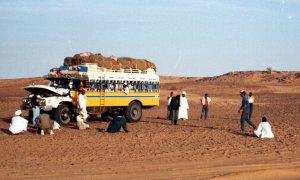 As we rode our health deteriorated steadily.
At one point I got an extra-long nap while the driver slept off a hangover.
I needed it: in Egypt I had had a small cold, and since I foolishly forgot to bring a dust mask or bandanna it got worse all the way south as I inhaled sand.
It didn’t help my health any that I regularly bashed my head on projecting bits of metal as we bounced over bumps.
The Poles developed symptoms of some intestinal disorder.
They had been drinking well water in addition to my water and thought they were safe because they took half a Flagyl tablet a day.
The American woman held up quite well for the first 40 hours or so, then spontaneously cracked and began chanting no more no more no more” until she ran out of energy.
As we rode our health deteriorated steadily.
At one point I got an extra-long nap while the driver slept off a hangover.
I needed it: in Egypt I had had a small cold, and since I foolishly forgot to bring a dust mask or bandanna it got worse all the way south as I inhaled sand.
It didn’t help my health any that I regularly bashed my head on projecting bits of metal as we bounced over bumps.
The Poles developed symptoms of some intestinal disorder.
They had been drinking well water in addition to my water and thought they were safe because they took half a Flagyl tablet a day.
The American woman held up quite well for the first 40 hours or so, then spontaneously cracked and began chanting no more no more no more” until she ran out of energy.
My supplies and energy also deteriorated as we rode on across the sand. Finally, while digging ourselves out of a sand lake one night somebody noticed a glow on the horizon and shouted “Look, Khartoum!” This produced a cheer. We made it into town just after sunrise and retrieved our baggage. The Poles went on their way to stay with new-found friends while I wandered off to look for the hostel (collecting new friends of my own as I searched).
Eventually I found the hostel and settled in. Like the hotel in Wadi Halfa, it too was divided into men’s and women’s sections. The larger men’s floor had a large crowd of students staying there while they studied at a Madrassa, and a few people visiting from various areas of southern Sudan. The crowd of foreigners passing through was never less than interesting. A couple South Africans in a Landrover appeared one day. They had driven up all the way from Durban with considerable trouble but now were almost at the end of their trip, with only the relatively easy Sahara crossing left. Two acquaintances from Cairo, a couple, showed up going south. She had been ill with hepatitis but a week later was smoking steadily and a few weeks later was unwisely guzzling beer again. An Australian named Greg passed through, headed for Capetown as I was, and a Dutch man appeared on his way to Eritrea, Yemen and (he hoped) through Oman and on to Iran. All of our little knot of foreigners going south had a big problem here. The Eritrean Embassy had stopped issuing visas except to residents of Sudan, and we could not convince them to let us in. I elected to fly on to Addis Ababa with everyone else heading south — except for Greg, who arranged an Ethiopian visa with a fake plane ticket, then crossed the mountains on foot.
Khartoum had a nice adventurous feeling to it, due mainly to the people I met. It also had a dramatic history, and looking around one could imagine General Gordon on the street (they had markers showing where his fortifications had been). Foreign diplomats and aid workers crowded the better restaurants. A few of these people made a good impression; when I saw Oxfam volunteers they were packed into small mud-covered vehicles, obviously returning from a day doing some real work somewhere. However, too many of these foreign “benefactors” lived high off the hog, lone fat men driving shiny white jeeps to and from their air-conditioned mansions. Save the Children had at least three large walled estates, representing different national branches. Behind the shiny white jeeps drove locals in cars pockmarked by bullet scars, and they drove past an endless supply of street children and war wounded. This scene did nothing to raise my opinion of the aid industry, and much to lower it. My impressions of the Sudanese were almost wholly positive, despite obvious signs of the inequalities and ethnic tension there. I still remember them as some of the most friendly and hospitable people I have met anywhere.
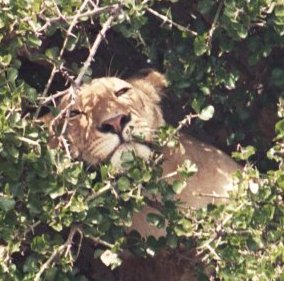 By the time I left Khartoum, my bad cold had turned to bronchitis and when I landed in Ethiopia I had no energy to do anything.
I quickly flew on again to Nairobi, which was cheaper and healthier.
In my brief stay in Addis Ababa I still managed to get chased by one of Mengistu’s thugs, who shouted that I was an American soldier.
My brief impression of Ethiopia was that, while undoubtedly scenic and historic, it could be a lot of hassle.
By the time I left Khartoum, my bad cold had turned to bronchitis and when I landed in Ethiopia I had no energy to do anything.
I quickly flew on again to Nairobi, which was cheaper and healthier.
In my brief stay in Addis Ababa I still managed to get chased by one of Mengistu’s thugs, who shouted that I was an American soldier.
My brief impression of Ethiopia was that, while undoubtedly scenic and historic, it could be a lot of hassle.
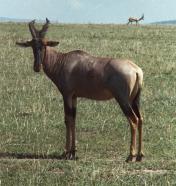 I liked Nairobi immediately. In 1994 there was a big foreign crowd there, comprising reporters and volunteer doctors and small businessmen. I lazed in town for a couple
weeks until my bronchitis had gone away, then headed out to climb Mount Kenya.
It had been a very dry year so I didn’t take a raincoat and this ruined my efforts: on my second day going up the mountain I woke up to find it raining.
My partners elected to carry on but I thought I had better wait.
This was fortunate, as the weather turned out to be a record rain/snow fall and within a couple days all the people who had headed up the slopes returned defeated.
Back in Nairobi again I settled down to reading and chatting and recruiting somebody to share the cost of a safari vehicle.
I liked Nairobi immediately. In 1994 there was a big foreign crowd there, comprising reporters and volunteer doctors and small businessmen. I lazed in town for a couple
weeks until my bronchitis had gone away, then headed out to climb Mount Kenya.
It had been a very dry year so I didn’t take a raincoat and this ruined my efforts: on my second day going up the mountain I woke up to find it raining.
My partners elected to carry on but I thought I had better wait.
This was fortunate, as the weather turned out to be a record rain/snow fall and within a couple days all the people who had headed up the slopes returned defeated.
Back in Nairobi again I settled down to reading and chatting and recruiting somebody to share the cost of a safari vehicle.
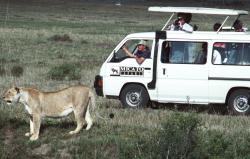 Eventually I teamed up with three Germans appeared for a week-long safari.
Nairobi sits in hill country, green and tree-covered, but we quickly descended from there into dry scrubby plains, then carried on to the Serengeti itself at Masai Mara National Park.
We spent a couple days there happily snapping photos of all sorts of animals; elephants, giraffes, lions, zebras, rhinos, cheetahs, warthogs, jackals, hyenas, buffalo, ostriches,
and endless many species of antelope and bird life.
Small multicoloured lizards abounded, too.
Eventually I teamed up with three Germans appeared for a week-long safari.
Nairobi sits in hill country, green and tree-covered, but we quickly descended from there into dry scrubby plains, then carried on to the Serengeti itself at Masai Mara National Park.
We spent a couple days there happily snapping photos of all sorts of animals; elephants, giraffes, lions, zebras, rhinos, cheetahs, warthogs, jackals, hyenas, buffalo, ostriches,
and endless many species of antelope and bird life.
Small multicoloured lizards abounded, too.
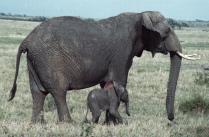 The hippos didn’t co-operate much, preferring to stay hidden in deep pools of water, but the lions put on an impressive show.
They would sprawl on their backs like oversized house cats, climbing trees and rough-housing with their cubs.
Some of the other safari vehicles there put on an equally impressive show, but in a negative way.
They hounded the animals, driving in close in their low-budget minivans while their camera-toting passengers leaned out open roofs to snap photos.
Micato Safaris seemed particularly bad for this.
That sort of chase couldn’t have been too rewarding for the tourists and surely did the animals little good.
The hippos didn’t co-operate much, preferring to stay hidden in deep pools of water, but the lions put on an impressive show.
They would sprawl on their backs like oversized house cats, climbing trees and rough-housing with their cubs.
Some of the other safari vehicles there put on an equally impressive show, but in a negative way.
They hounded the animals, driving in close in their low-budget minivans while their camera-toting passengers leaned out open roofs to snap photos.
Micato Safaris seemed particularly bad for this.
That sort of chase couldn’t have been too rewarding for the tourists and surely did the animals little good.
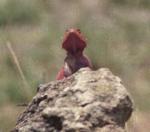 Outside the Mara, the wildlife changed somewhat. We noticed large dirt towers by the roadside, built by termites or ants.
Monkeys and baboons began to appear in large numbers.
These were particularly common at Lake Nakuru, a relatively small park in which the WWFN had invested large amounts of money to create a rhino sanctuary surrounded by an electric fence.
After Nakuru we made a quick tour of a couple local lakes, and ended at Lake Baringo.
The main sight there was the huge pink field of flamingoes who descended on the lakes to feed, changing from one lake to another as their levels rose and declined (and with them the amount of food).
Finally we pressed on to Nyahururu, where we enjoyed swinging on a vine at Thomson’s Falls.
Outside the Mara, the wildlife changed somewhat. We noticed large dirt towers by the roadside, built by termites or ants.
Monkeys and baboons began to appear in large numbers.
These were particularly common at Lake Nakuru, a relatively small park in which the WWFN had invested large amounts of money to create a rhino sanctuary surrounded by an electric fence.
After Nakuru we made a quick tour of a couple local lakes, and ended at Lake Baringo.
The main sight there was the huge pink field of flamingoes who descended on the lakes to feed, changing from one lake to another as their levels rose and declined (and with them the amount of food).
Finally we pressed on to Nyahururu, where we enjoyed swinging on a vine at Thomson’s Falls.
Historical note: at that time Rwanda, Burundi and DR Congo were all fairly peaceful but nervous. Past conflicts were mostly on hold, refugees and combatants displaced to nearby camps. All that changed suddenly while I was in Nairobi...
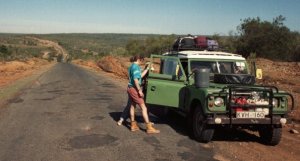 Back in Nairobi for a third time, I began making plans for a loop around Lake Victoria.
These didn't go anywhere; I grew less and less energetic till one of the volunteer doctors there diagnosed giardia.
While I sat trying to cure that, the news reported that the presidents of Rwanda and Burundi had been shot down at Kigali Airport.
Within days this led to one of the most horrific massacres of modern times, the attempted genocide in Rwanda.
Back in Nairobi for a third time, I began making plans for a loop around Lake Victoria.
These didn't go anywhere; I grew less and less energetic till one of the volunteer doctors there diagnosed giardia.
While I sat trying to cure that, the news reported that the presidents of Rwanda and Burundi had been shot down at Kigali Airport.
Within days this led to one of the most horrific massacres of modern times, the attempted genocide in Rwanda.
I had been considering visiting Rwanda and Burundi, but likely wouldn't have even if the war hadn't happened. In fact, I didn’t go anywhere there after that. The giardia went away but my enthusiasm didn’t return. The thought of one more bus ride seemed like agony, especially considering the high risk of getting robbed during the bus trip. Nairobi was so famous for crime then that people later took to calling it Nairobbery. I wasn’t in the estimated 10-20% of backpackers who got mugged, but I still didn’t relish walking with a full load through a crowded bus stand.
 So, I sat enjoying soft city life and made my plans to leave.
In the time before my flight I met Greg again, who I had last seen in Khartoum.
Since that first meeting he had crossed Ethiopia and Kenya by land, hitch-hiking through the mountains.
I saw other people on their way to various fascinating activities and had by no means given up on Africa,
but the time was right to work for a bit, save money and change my mode of travel.
After pondering such matters, I flew back to Asia.
So, I sat enjoying soft city life and made my plans to leave.
In the time before my flight I met Greg again, who I had last seen in Khartoum.
Since that first meeting he had crossed Ethiopia and Kenya by land, hitch-hiking through the mountains.
I saw other people on their way to various fascinating activities and had by no means given up on Africa,
but the time was right to work for a bit, save money and change my mode of travel.
After pondering such matters, I flew back to Asia.
Another unplanned stay in Hong Kong (April 1994-August 1995)
From Africa I landed in Bangkok first, for a little holiday after my long trip.
Within four hours there somebody stole my wallet, which I had carefully protected for three months in Kenya.
I sat in Bangkok anyway and watched movies for a couple weeks, then went to Penang and from Penang on to Singapore and finally back to Hong Kong.
A local school there offered me a year’s contract teaching high-school level English for adults.
I quickly worked out that, as I only wanted to work for one year, this was a better deal than the loose plans I'd had to return to Taiwan, so I stayed.
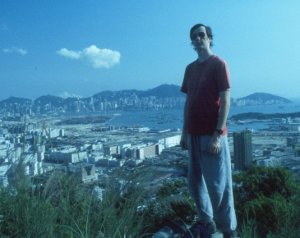
Hong Kong English teaching at its lowest level was “freetalk,” where a native speaker would come and talk about anything students wanted to discuss. A step up were private lessons, where students would meet one-on-one with teachers of varying quality and qualifications, and work on specific problems. Then there were regular schools with experienced teachers and at the very top were the specialists with experience and TOEFL qualifications who could earn an amazing amount of money. Pay in the business ranged from $5 US per hour to $10,000 US per month.
Most of my students were housewives and secretaries. Many studied English to get a better job, and many because they wanted to emigrate to Canada or Australia or any other respectable country that would admit them. This phenomenon was widely misunderstood in the west. These people were mainly very happy in Hong Kong. What they really wanted was not to live somewhere else, where they would need to learn a new language, would make less money, would pay more taxes and would have a more difficult life. What they wanted was the ability to leave in case things went bad after Hong Kong rejoined China in 1997.
For most of that year I lived in Chungking Mansions. The room I had thought would be ideal turned out to be a bedbug ranch. I moved rooms again, to one which was much closer to ideal, and stayed happy there for several months despite developing a hernia at Christmas time and despite frequent raids by the Immigration Department. Finally, one of my roommates got a good job and moved out. In his place a depraved swine moved in, and the depraved swine invited one of his even worse friends, and finally the two of them chased me out. I rented a private room the size of a closet for my last few months. When I left I was ready for a month of open space and went back to Canada for a holiday.
Morocco 1995
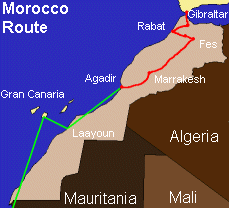 For this trip I wanted to avoid public transport as much as possible.
The inherent discomfort and inconvenience of it had limited me far too much when travelling in the past.
My height was a big factor; I stand 193 cm tall and usually have to squeeze to fit into any sort of public transport seat.
This made most trips less than pleasant, even when the scenery was brilliant or I had interesting seatmates to talk with.
The high accident rate I had seen in buses and minibuses had also turned me off public transport.
I’d come to believe that if I routinely rode in these unsafe contraptions with their dangerous drivers, sooner or later I would die in one.
For this trip I wanted to avoid public transport as much as possible.
The inherent discomfort and inconvenience of it had limited me far too much when travelling in the past.
My height was a big factor; I stand 193 cm tall and usually have to squeeze to fit into any sort of public transport seat.
This made most trips less than pleasant, even when the scenery was brilliant or I had interesting seatmates to talk with.
The high accident rate I had seen in buses and minibuses had also turned me off public transport.
I’d come to believe that if I routinely rode in these unsafe contraptions with their dangerous drivers, sooner or later I would die in one.
Having decided what not to do, I then had to decide how I would get around. Walking appealed to me, but it was too slow and if I resorted to hitch-hiking I would have safety worries as well as hassles. Driving a Landrover would have been nice, but too expensive and I didn’t want the commitment of taking a partner with me. That left bicycles and motorcycles. I chose the pedal option because I had friends who’d done this before and loved it, and because bicycles can be easily shipped on planes and don’t require any special papers. The physical effort involved never concerned me much. I found at the end of a day riding buses I was exhausted anyway, but if I rode a bicycle at least I would get some fresh air and exercise for my trouble.
 I flew to Paris, then left immediately for Lourdes. I’d picked it as an easy destination I could reach in a mad rush out of Paris, and because I knew it had many cheap places to stay.
This saved me some cash as I sat for a few days to recover from jet lag.
My first day cycling took me a short 35 km down the road.
The next day I did 78 km over the Col d’Aubisque.
At the time it seemed like a big climb, but later in Pakistan I rode in river valleys which were higher.
Those two days went by quietly, cycling on near-deserted small roads through the Pyrenees.
Every now and then a farmer would cheer me on, or dogs would pursue me, or the fog would suddenly part leaving me a glimpse of deep mountain gorges.
A few more days saw me over the Col du Pourtalet and, partly by train, on to Granada.
There I stayed several days, seeing the Alhambra and riding up to the Sierra Nevada.
I made one last train jump to Gibraltar before I began riding full-time.
I flew to Paris, then left immediately for Lourdes. I’d picked it as an easy destination I could reach in a mad rush out of Paris, and because I knew it had many cheap places to stay.
This saved me some cash as I sat for a few days to recover from jet lag.
My first day cycling took me a short 35 km down the road.
The next day I did 78 km over the Col d’Aubisque.
At the time it seemed like a big climb, but later in Pakistan I rode in river valleys which were higher.
Those two days went by quietly, cycling on near-deserted small roads through the Pyrenees.
Every now and then a farmer would cheer me on, or dogs would pursue me, or the fog would suddenly part leaving me a glimpse of deep mountain gorges.
A few more days saw me over the Col du Pourtalet and, partly by train, on to Granada.
There I stayed several days, seeing the Alhambra and riding up to the Sierra Nevada.
I made one last train jump to Gibraltar before I began riding full-time.
I had visited Gibraltar years before and promised myself I would come back. It hadn’t changed much, still overcrowded and gaudy and wonderful. I climbed the rock again, snapped a few photos of the Barbary Apes, and looked across to Morocco again. The next day I rode to Algeciras and took the ferry to Ceuta, landing back in Africa.
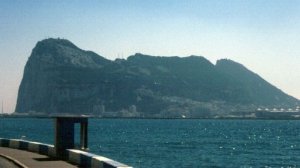 My stay in Ceuta was only hours long, but long enough to ride once all the way around it.
The town appealed, with stone streets and steep hills, but the costs frightened me off so I rode across the border and on towards Tetouan.
The border crossing went easily, with an amused and interested guard asking me if I had any drugs and making some mysterious gestures and using a French noun I didn’t understand.
After a few minutes we worked out that he wanted to know if I was carrying any mace (to use when chased by dogs, presumably).
After satisfying him that I wasn’t carrying anything unlawful, I rode off into the dark.
The busy Moroccan highway wasn’t much fun at night, and I quickly found a deserted luxury hotel to stop at.
My stay in Ceuta was only hours long, but long enough to ride once all the way around it.
The town appealed, with stone streets and steep hills, but the costs frightened me off so I rode across the border and on towards Tetouan.
The border crossing went easily, with an amused and interested guard asking me if I had any drugs and making some mysterious gestures and using a French noun I didn’t understand.
After a few minutes we worked out that he wanted to know if I was carrying any mace (to use when chased by dogs, presumably).
After satisfying him that I wasn’t carrying anything unlawful, I rode off into the dark.
The busy Moroccan highway wasn’t much fun at night, and I quickly found a deserted luxury hotel to stop at.
The next day I made it handily to Tetouan, where I had a bit of excitement during my brief stay. A tout attached himself to me for a few minutes too long and a policeman dragged him away for questioning, despite my half-hearted lie that he hadn’t been botheringme. I hadn’t expected this; when I first visited Morocco in 1989 the touts were fierce in their hassling, but things had changed somewhat since then. The government had spent a lot of effort to clean up the tourist business. Without the wild charm it was less fun, particularly in Marrakech, but it was also much less hassle — a mixed blessing.
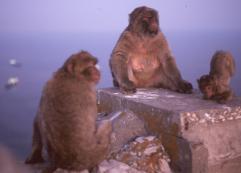 From Tetouan I pushed on over rolling hills to Chefchaouen, a pleasant whitewashed village.
I had planned on a day or two here but had to stay a bit longer.
In Gibraltar I had caught up on my Typhoid vaccination, and here the side-effects caught up with me, leaving me dizzy and weak for a weekend.
When I’d recovered, I descended from the hills to Ouazzane, also a whitewashed village but not nearly as pleasant.
A slick group of con artists met me at my fleabag motel room (which had holes in the walls) and by the end of the afternoon had managed to milk me of several souvenirs and a free lunch.
In 1989, a similar group had sold me a carpet for a couple hundred US dollars. I was getting better at handling these people.
From Tetouan I pushed on over rolling hills to Chefchaouen, a pleasant whitewashed village.
I had planned on a day or two here but had to stay a bit longer.
In Gibraltar I had caught up on my Typhoid vaccination, and here the side-effects caught up with me, leaving me dizzy and weak for a weekend.
When I’d recovered, I descended from the hills to Ouazzane, also a whitewashed village but not nearly as pleasant.
A slick group of con artists met me at my fleabag motel room (which had holes in the walls) and by the end of the afternoon had managed to milk me of several souvenirs and a free lunch.
In 1989, a similar group had sold me a carpet for a couple hundred US dollars. I was getting better at handling these people.
The road from Ouazzane led to the main highway and south, 140 km through fertile farmland to Kenitra. There I pitched my tent at a beachside campground, under conditions that resembled a war zone. The campground must have had fairly serious problems with theft, judging from the effort they’d invested in security.
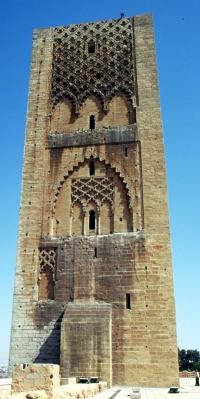 In one more morning after Kenitra, I arrived in Rabat.
Morocco’s capital had sights; royal palaces, ancient ruins, impressive bird life and lots of colourful old stone buildings.
I had a bit of business to do there, which took a lot of time.
Mainly, I wanted to get a visa for Mauritania.
I knew it would be difficult if I wanted to go by land, and that I should have done it in Paris or Madrid, but I didn’t care enough to spend the cost to get one in Europe.
I didn’t manage to get one in Rabat, and as in Sudan a couple years earlier, I didn’t care to spend my way through the hassles of buying a fake plane ticket.
Instead I switched to my backup plan, to ride through Morocco then fly to the Canary Islands and from there travel to West Africa somehow.
This didn’t feel like any sort of loss to me; I’d crossed the Sahara before, and was looking forward to seeing Gran Canaria.
In one more morning after Kenitra, I arrived in Rabat.
Morocco’s capital had sights; royal palaces, ancient ruins, impressive bird life and lots of colourful old stone buildings.
I had a bit of business to do there, which took a lot of time.
Mainly, I wanted to get a visa for Mauritania.
I knew it would be difficult if I wanted to go by land, and that I should have done it in Paris or Madrid, but I didn’t care enough to spend the cost to get one in Europe.
I didn’t manage to get one in Rabat, and as in Sudan a couple years earlier, I didn’t care to spend my way through the hassles of buying a fake plane ticket.
Instead I switched to my backup plan, to ride through Morocco then fly to the Canary Islands and from there travel to West Africa somehow.
This didn’t feel like any sort of loss to me; I’d crossed the Sahara before, and was looking forward to seeing Gran Canaria.
Meknes looked nicer than the other cities I’d passed through in Morocco, with its walls and fortresses. Farther north the villages had been small walled and whitewashed towns. From Meknes on the cities were all big brown-walled citadels, often with stone streets. Another tourist there told me how he’d been stopped at night on the road I’d taken, then sold a load of hashish at gunpoint. It sounded an interesting form of banditry but banditry all the same. This caused me to think twice about riding at night, but didn’t stop me from a short day trip to the ruins of Volubilis, just north of Meknes. This old Roman city thoroughly disappointed compared to the ruins I’d seen in Syria and Jordan. It had reached a much lower state of repair, consisting of little more than a few old pavements with grass growing everywhere.
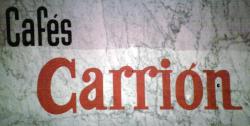 From Meknes my route took me to Fes, an easy ride through countryside that grew steadily more rugged and hilly.
Fes had a convenient new town with hotels and restaurants, and a very scenic old town with canyon-like cobblestone lanes winding around the bottom of a valley.
It also had swarming crowds of people.
The occasional cart forced its way through the masses and back lanes led into picturesque hidden markets and mosques.
From Meknes my route took me to Fes, an easy ride through countryside that grew steadily more rugged and hilly.
Fes had a convenient new town with hotels and restaurants, and a very scenic old town with canyon-like cobblestone lanes winding around the bottom of a valley.
It also had swarming crowds of people.
The occasional cart forced its way through the masses and back lanes led into picturesque hidden markets and mosques.
From Fes I had to choose between a couple interesting routes, and opted to ride south through the Middle Atlas rather than go east and around through the desert. The climb up from Fes to Ifrane was easily accomplished, with the road not too steep and the green hills easy on the eye. I ended the day at Azrou, another village which has surely graced the front side of many postcards. However, I picked a bad place to eat that night and didn’t get enough food as a result. This was a serious mistake.
The next day I picked a road up through the mountains and past the Sources of the Oum Er Rbia. The hotel manager had said it was an easy ride and I had foolishly believed him, then found myself riding 120 km up and down over three mountain passes. By the end of the night at Khénifra, I had worked up a nice case of hypoglycemia to the point where I could hardly ask for a hotel room. I did eventually manage to find one, and stayed a couple days. I particularly enjoyed this singularly normal town. It had little in the way of special sights, but lots of good food, friendly people and a good climate.
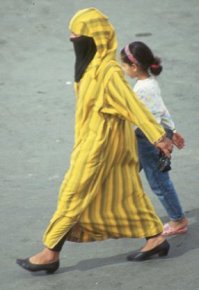 The road from there to Marrakech was flatter but no easier.
The next day’s ride south was perhaps the worst of my trip.
An unwise short cut brought me my first flat tire, followed by several more as I wound my way down a tortuous back road which the government was busy rebuilding
— in the process making it completely unusable.
At night I stopped in a dingy hovel in Beni Mellal.
The next two days I spent crossing near-desert, complete with wandering camels, to Marrakech.
The road from there to Marrakech was flatter but no easier.
The next day’s ride south was perhaps the worst of my trip.
An unwise short cut brought me my first flat tire, followed by several more as I wound my way down a tortuous back road which the government was busy rebuilding
— in the process making it completely unusable.
At night I stopped in a dingy hovel in Beni Mellal.
The next two days I spent crossing near-desert, complete with wandering camels, to Marrakech.
Marrakech had been a hippie Mecca in the past but it certainly was not in 1995. The cleanup I had noticed in Tetouan showed even more here. The Jemaa Fnaa had supposedly bustled with drug dealers and hippies and hawkers in the sixties but in the nineties it was tidy and orderly. All the food dealers had to wear white coats and get licences. It still presented quite a sight, with rows of glaring torches at night illuminating the carts of food hawkers. Like Fes, Marrakech had an old section and a new section. The old town also had winding narrow streets, with red walls all around.
I headed south, ascending from the plain around Marrakech into the High Atlas. Shortly after leaving the city, I ran into the most annoying of many annoying people I met in Morocco. I was used to stone throwers and beggars but in a small village I met one boy who was both. He chased me down the street shouting “give me give me give me. When I had to walk my bike around a giant mound of rocks, he began to pull at things on my rack, trying to carry them off. I kicked at him and he jumped back, then picked up two fist-sized missiles. I dropped the bike and he dropped the rocks as I advanced on him... but my bike effectively glued me to the road so I let him escape. Later I ran into another boy, perhaps the first one’s brother, who cycled along next to me telling me which way I was going, then demanded money. When he didn’t get it he wished me a pleasant accident.
Asni was the usual stop on the route up to the Tizi’n’Test but I only had to stop there for five minutes to realize five minutes was enough. Everybody there seemed to want to sell me something, before I’d even stopped my bike. I kept going to Ouirgane. This had a few fewer touts and annoying people. When the only restaurant in town tried to overcharge me by two hundred percent, I lightened my load by firing up my small camp stove and cooking my remaining food in the toilet of my hotel room.
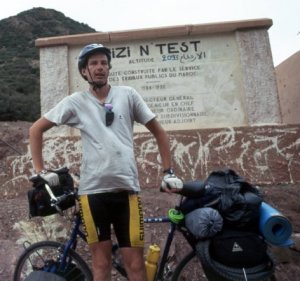 From Ouirgane to Taroudannt the next day was my longest ride ever, 175 km over the Tizi’n’Test, a famous pass.
The view up in the High Atlas would have made it worthwhile by itself but the 30 km downhill stretch, coasting through 1800 m of altitude, really made it good.
My muscles started working again at the bottom and I pedalled into Taroudannt feeling quite sufficiently stiff and sore.
I stayed on another day there to recover from fatigue and look around town.
Like most I had visited in Morocco, it had a high wall and other fortifications, left over from days when there must have been many enemies thereabouts.
From Ouirgane to Taroudannt the next day was my longest ride ever, 175 km over the Tizi’n’Test, a famous pass.
The view up in the High Atlas would have made it worthwhile by itself but the 30 km downhill stretch, coasting through 1800 m of altitude, really made it good.
My muscles started working again at the bottom and I pedalled into Taroudannt feeling quite sufficiently stiff and sore.
I stayed on another day there to recover from fatigue and look around town.
Like most I had visited in Morocco, it had a high wall and other fortifications, left over from days when there must have been many enemies thereabouts.
The day after that I cycled on to Agadir, my last stop in Morocco. Agadir may as well have been a beach resort in France. It was a pleasant stop but an expensive and unmemorable one. My cycling in Morocco wasn’t quite over; I started riding to Agadir airport then discovered my map was out of date, and the airport was now 30 km out of town. Still, I made it on time and flew to Gran Canaria with only minor trouble. The airline check-in attendants were convinced I needed a visa for the Canary Islands, because the Canadian government had just concluded a bitter diplomatic feud over fishing rights with Spain. A few weeks earlier Canadians had needed visas to visit Spain, but it was no longer true by then.
An interlude in Gran Canaria
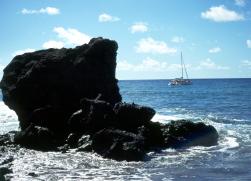 At the other end of that flight I didn’t have much better luck.
My bike arrived safe and sound and passport control was no problem, as I had expected even if the Moroccans hadn’t.
A friendly woman behind a desk at the tourist office handed me a map and a few leaflets, from which I quickly located the few campsites on the island and zoomed off.
At the other end of that flight I didn’t have much better luck.
My bike arrived safe and sound and passport control was no problem, as I had expected even if the Moroccans hadn’t.
A friendly woman behind a desk at the tourist office handed me a map and a few leaflets, from which I quickly located the few campsites on the island and zoomed off.
Unfortunately, the road largely followed the coast so instead of the 20-30 km it looked on the map, I found myself cycling over 60 km in the hot sun in my dress clothes. Still, there were convenience stores where I could buy cold drinks and the view of the rocky volcanic coastline was spectacular, so I didn’t complain too much as I bumbled along. I passed a few small old stone towns and a few more modern concrete tourist villages, and finally settled at a campsite in Tauro, on the south side of the Island, where I set up my tent and fell asleep exhausted.
My plan here was to find either a boat or a flight, to Mauritania or as close to it as I could get. My ideal boat ride would have been on a yacht going south but I had arrived just in time for the trans-Atlantic crossing so everyone was going the wrong direction. My next option was to try to find a ride on a freighter. There were many of these and they did follow the routes I liked. There was a practical problem, though. Although you wouldn’t know it to look at the tourist areas, Gran Canaria was part of Spain and as elsewhere in Spain the majority of people spoke only Spanish. I quickly assessed my chances of finding a ride on a freighter and decided it would take far too long given that I didn’t speak the language well enough to discuss “business.” Other people have managed this, but they must have had more tenacity or better connections than I did, or maybe just spoke better Spanish.
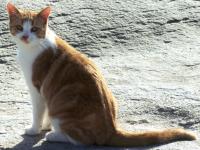 Then I began to look at flights. It didn’t take me long to find out that there were few direct flights.
Worse, what flights there were cost too much money, for example a ridiculous $700 US regular one-way fare to Dakar.
Continuing on in my hunt, I found a return fare for a more reasonable $450.
After a couple weeks I had about decided on that when a last-minute scouring of every travel agent in Playa del Ingles turned up a small
company which ran one-day tourist excursions to Dakar and Banjul.
Their next trip happened to go to Banjul so I decided to go to Banjul, booked my ticket and settled my plans.
This flight cost me all of $250 US.
Then I began to look at flights. It didn’t take me long to find out that there were few direct flights.
Worse, what flights there were cost too much money, for example a ridiculous $700 US regular one-way fare to Dakar.
Continuing on in my hunt, I found a return fare for a more reasonable $450.
After a couple weeks I had about decided on that when a last-minute scouring of every travel agent in Playa del Ingles turned up a small
company which ran one-day tourist excursions to Dakar and Banjul.
Their next trip happened to go to Banjul so I decided to go to Banjul, booked my ticket and settled my plans.
This flight cost me all of $250 US.
Was it reasonable to spend three weeks there trying to save $450 US? Yes, it was. My cost of living there was only about $10-15 per day and it was a worthwhile destination. Between trips into town to hunt down cheap fares I enjoyed myself on the beach and toured the island a bit as well. The south coast of Gran Canaria is a developed concrete jungle but convenient. The interior is more wild country, in and around the eroded ruins of a giant volcano.
After three weeks there I was ready to move on to Africa. I wasn’t ready for the cycle ride back to the airport, however. Leaving at 2 AM I expected a nice night-time ride on an empty highway, which I got. I didn’t expect a 50 kph wind blowing in my face for half of the distance, but I got that also. I managed anyway despite being blown off my bike twice.
West Africa (November 1995-March 1996)
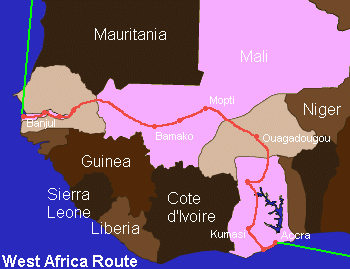 A year or so before I went to the Gambia, there had been a coup d’etat, so I wasn’t sure what to expect when I landed.
It looked pretty peaceful.
Passport control went smoothly and the porters were more than happy to help me with my luggage, even despite my protests that I wanted them not to help.
The ride into town this time turned out to be some thirty kilometres long, but not difficult. The country was flat as a pancake.
A year or so before I went to the Gambia, there had been a coup d’etat, so I wasn’t sure what to expect when I landed.
It looked pretty peaceful.
Passport control went smoothly and the porters were more than happy to help me with my luggage, even despite my protests that I wanted them not to help.
The ride into town this time turned out to be some thirty kilometres long, but not difficult. The country was flat as a pancake.
Finding a place to stay in Banjul was rather more trouble. For years the standard place for backpackers to stay had been Uncle Joe’s, but it had gone out of business. Other famous old places looked undesirable, so I looked for some place new. This required a lot of looking. Gambians weren’t fond of advertising. Pretty soon I figured out the local way of finding things and just asked someone. He asked someone else who asked someone else who found a place promptly.
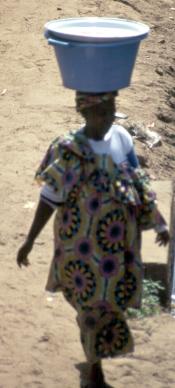 Banjul was a tremendously run-down town. At the time I arrived they were in the middle of a road renovation project.
This meant that they had dug up all the potholed roads a couple years before but had yet to replace them with anything else.
They finally started on the day I left. Power was on 16 hours per day for two days out of three and 24 hours for one day, in theory.
In practice it didn’t quite reach those numbers.
The buildings came in two styles, old colonial architecture and shacks.
Out in the suburbs the look of town improved somewhat. This was the expatriate area, naturally.
With my bike it didn’t matter where I stayed, so I stayed in town where I had first arrived, and cycled the 16 km out to the beach and
the suburbs whenever I wanted.
Banjul was a tremendously run-down town. At the time I arrived they were in the middle of a road renovation project.
This meant that they had dug up all the potholed roads a couple years before but had yet to replace them with anything else.
They finally started on the day I left. Power was on 16 hours per day for two days out of three and 24 hours for one day, in theory.
In practice it didn’t quite reach those numbers.
The buildings came in two styles, old colonial architecture and shacks.
Out in the suburbs the look of town improved somewhat. This was the expatriate area, naturally.
With my bike it didn’t matter where I stayed, so I stayed in town where I had first arrived, and cycled the 16 km out to the beach and
the suburbs whenever I wanted.
In town I found myself eating mainly at the African Heritage Cafe, an upmarket place run by a Danish woman. It had great food and a balcony where I could sit and watch people on the street. There I met a character named Jack, an old Danish hippie who had moved to the Gambia after his divorce and opened a bar. While running it he had enjoyed life a bit too much and somebody had reported to the police that he liked to smoke marijuana. He had spent many months in jail waiting to go to trial and finally got out on bail. His business had failed meantime. He trusted a European friend to run it for him and his friend stole all the money. At the time I met him he was still waiting through continuations in his trial as the prosecutor failed to find his key witness. Jack’s lawyer was confident that eventually they would have to drop the case but meanwhile he lived in an unpleasant state.
All across Africa I met people who liked drugs and particularly who liked marijuana. Many African countries had very harsh penalties for drug use, and the Gambia is not by far the worst. However, most of these people seemed not to be concerned about it, as they seemed not to be concerned about many things that could make a big mess of their lives there. When I told them Jack’s story it failed to make any dent as well. Would it have more impact if I knew the outcome?
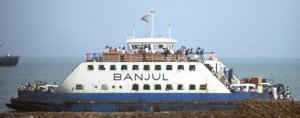 My main business in Banjul (aside from seeing the city) was to collect visas, and this proved easy enough once I gave up trying to do things the “normal” way
and started doing them through connections and guides, their way.
The Mali consul was a businessman but the Mauritanian consul had a real consulate.
For Senegal I didn’t need a visa and Guinea I ruled out early on; geography more or less forced me to decide between a coastal route and an
inland route, and I unwisely chose the inland road.
My main business in Banjul (aside from seeing the city) was to collect visas, and this proved easy enough once I gave up trying to do things the “normal” way
and started doing them through connections and guides, their way.
The Mali consul was a businessman but the Mauritanian consul had a real consulate.
For Senegal I didn’t need a visa and Guinea I ruled out early on; geography more or less forced me to decide between a coastal route and an
inland route, and I unwisely chose the inland road.
In between visa expeditions I talked with people and made day trips around the west end of the country, to Abuko Nature Reserve in particular. This small park preserves a dense bit of green jungle with a good variety of birds. I laid in enough food to see me to Senegal and finally headed off. The first day I had hoped to make it to Tendaba Camp, some 145 km upstream, but road conditions made that unfeasible. Also, although I didn’t realize it till much later, my bicycle seat had been knocked down somehow during the flight to Banjul. The result of this was that I didn’t have quite enough leg room, and that centimetre or two difference caused me a very large amount of knee trouble over the next week. Towards the end of that first day out I met a German businessman who had stopped by the side of the road and he invited me to stay with a contact of his at a nearby fish factory. This was a fantastic stroke of luck. I got a free bed for the night and all the shrimp I could eat, with watermelon and safe water to wash the food down.
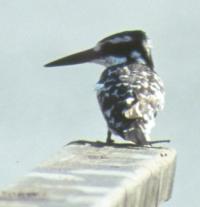 Reaching Tendaba camp the next day was easy enough despite the ever-worsening road.
At the camp I met a large group of management students from Canada on some sort of educational tour, and chatted with their professor.
The students seemed uninterested in anything outside their group.
They had seen a bit of the country, listened to official bullshit from various government officials, spent a lot of time talking with each other without seeing anything of the
country beyond the veneer presented to them, and would soon go home having gained no more than superficial knowledge of the country.
It seemed a sad comment on some aspect of education.
I stayed a couple days, enough time to tramp around the bush and watch monkeys and the very large variety of colourful local birds.
Reaching Tendaba camp the next day was easy enough despite the ever-worsening road.
At the camp I met a large group of management students from Canada on some sort of educational tour, and chatted with their professor.
The students seemed uninterested in anything outside their group.
They had seen a bit of the country, listened to official bullshit from various government officials, spent a lot of time talking with each other without seeing anything of the
country beyond the veneer presented to them, and would soon go home having gained no more than superficial knowledge of the country.
It seemed a sad comment on some aspect of education.
I stayed a couple days, enough time to tramp around the bush and watch monkeys and the very large variety of colourful local birds.
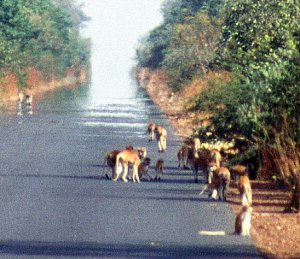 The bad road continued to Soma, the halfway point and junction with the north-south trans-Senegal highway, then turned into smooth blacktop going east.
Monkeys and baboons abounded but places to stay didn’t and that night I roosted at a semi-derelict tourist camp where I cooked my own food rather than rely on the dubious local eatery.
The next day I made it easily to Georgetown and almost rode past as well.
The Gambian distaste for signs extends to highway markings, too, and the turnoff for Georgetown was completely unmarked.
However,as always I just had to stop somebody and ask them where the road went.
The bad road continued to Soma, the halfway point and junction with the north-south trans-Senegal highway, then turned into smooth blacktop going east.
Monkeys and baboons abounded but places to stay didn’t and that night I roosted at a semi-derelict tourist camp where I cooked my own food rather than rely on the dubious local eatery.
The next day I made it easily to Georgetown and almost rode past as well.
The Gambian distaste for signs extends to highway markings, too, and the turnoff for Georgetown was completely unmarked.
However,as always I just had to stop somebody and ask them where the road went.
Georgetown has one of the Gambia’s few real “sights”; the stone circles at Wassu, north of town. These were something like Stonehenge but not nearly as impressive. Their origin, however, is more mysterious; nobody seems to have much clue at all who built them or why. The ride out to see them was better than the destination, particularly as our bush taxi was an off-duty (I hoped) ambulance. Georgetown’s other major attraction is its position on the river, which makes it a good base for day-long river trips. Local fisherman caught barracuda. That surprised me until I remembered that the River Gambia was not really a river at all but a long tidal estuary. Even hundreds of kilometres upstream you can still see it rise and fall with the tides and still find salt-water fish.
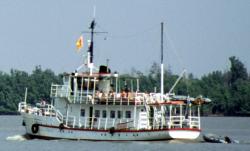 Once Georgetown was a bustling colonial town.
By 1995 it was well on its way to becoming a ghost town.
I saw little reason for it to exist any more.
It didn’t sit at a useful crossroads and if the Gambia merged with Senegal it would become even more of a backwater than it already was.
This wasn’t likely to happen because Gambians were proud of being “English” instead of “French.”
Thus, they doomed themselves to poverty by remaining semi-isolated in their little sliver of land.
This was silly because they were substantially the same mix of people as in surrounding Senegal and many of them spoke French anyway.
Once Georgetown was a bustling colonial town.
By 1995 it was well on its way to becoming a ghost town.
I saw little reason for it to exist any more.
It didn’t sit at a useful crossroads and if the Gambia merged with Senegal it would become even more of a backwater than it already was.
This wasn’t likely to happen because Gambians were proud of being “English” instead of “French.”
Thus, they doomed themselves to poverty by remaining semi-isolated in their little sliver of land.
This was silly because they were substantially the same mix of people as in surrounding Senegal and many of them spoke French anyway.
From Georgetown I pushed on to Basse Santa Su, the new traffic hub near the east end of the country. This tiny town had a bustling market with traders from Mali, Guinea, Mauritania and everywhere else in west Africa. Locally-based expatriates suggested that a lot of the goods for sale there would ultimately be smuggled to different places. Most things for sale seemed to be Chinese-made so I gathered they were shipped up from the coast. There were also many refugees in the area, from Sierra Leone, Liberia, Mauritania, and other places.
The main highway ran south from Basse and then around to Tambacounda in a big curve through Casamance. I didn’t want to ride this so I asked around about the roads and some Peace Corps volunteers told me to ride straight out east, through the village of Fatoto where they worked. I did so, stopping a night to stay with them. Their tales of official corruption and incompetence were enlightening and interesting but not surprising. I had heard similar things from similar people before in Africa and would hear them again and again.
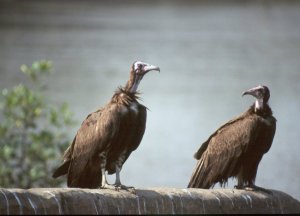 A very large number of people in these agencies seemed disillusioned with the work they did.
This is not noteworthy, perhaps, but it impressed me that the people most disillusioned seemed to be the ones doing the most useful work
(for example, teaching in local schools or working in local clinics).
They usually could give me clear and believable answers to the most detailed questions I could think to ask about local people and customs.
They lived with local people and talked to them every day. They knew most people in their towns and everyone there knew them.
At other times I talked to the upper echelon of volunteers, typically working for the UN or government aid agencies, and heard only vague generalities that one could get from a book.
Some of these people I saw but never met at all as they stayed only in hotels too expensive for me (and I was far from being a penny-pincher),
and huddled together in small clans whenever they ventured outside to eat in expensive restaurants.
What’s the real story?
An outsider will maybe never know all that goes on with these groups but I think I can safely claim that being disillusioned is the rational and realistic response.
The good work done by people at the bottom seems too often to be misdirected by their superiors, or hijacked for personal gain by a clique of corrupt and self-enriching middlemen.
A very large number of people in these agencies seemed disillusioned with the work they did.
This is not noteworthy, perhaps, but it impressed me that the people most disillusioned seemed to be the ones doing the most useful work
(for example, teaching in local schools or working in local clinics).
They usually could give me clear and believable answers to the most detailed questions I could think to ask about local people and customs.
They lived with local people and talked to them every day. They knew most people in their towns and everyone there knew them.
At other times I talked to the upper echelon of volunteers, typically working for the UN or government aid agencies, and heard only vague generalities that one could get from a book.
Some of these people I saw but never met at all as they stayed only in hotels too expensive for me (and I was far from being a penny-pincher),
and huddled together in small clans whenever they ventured outside to eat in expensive restaurants.
What’s the real story?
An outsider will maybe never know all that goes on with these groups but I think I can safely claim that being disillusioned is the rational and realistic response.
The good work done by people at the bottom seems too often to be misdirected by their superiors, or hijacked for personal gain by a clique of corrupt and self-enriching middlemen.
From Fatoto I crossed the border, stopping to wait while the Gambian passport officer tried to find enough ink to stamp me out. On the Senegalese side I had to search to find the border post, and it became quite clear how smuggling could be the main business of Basse Santa Su; sneaking across the border was so easy that anyone who could carry anything saleable could earn money smuggling. I did eventually find the border post and continued down the excellent road to Tambacounda. When I arrived, the contrast with the Gambia struck me immediately. The countryside hadn’t changed, still flat and dry scrub, but the standard of living had gone up about 50 percent in a few kilometres. This wasn’t saying much, to be sure, but Senegal had power almost all the time and many more things to buy, even in an outpost like Tambacounda. It also had more bureaucracy. Coming into town a policeman stopped me. He checked my passport, looked at the time stamp and shook his head in amazement that I could cycle so quickly. I added to his awe by telling him how I had stopped to watch monkeys and snakes. He welcomed me to Senegal and I went to town.
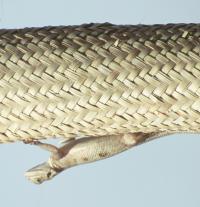 The next day I cycled on towards Mali.
The road started out not too badly but quickly deteriorated.
It was a dirt road and had giant potholes two metres deep with ruts and mud patches.
I pushed on and it got steadily worse.
Numerous people had told me that this road was OK till the border and very bad after that.
This sort of road advice is unreliable when it doesn’t come from other cyclists, but with even the gross details and a quick calculation I saw that I had little chance of reaching
Bamako for Christmas if I insisted on cycling.
After 30 km I turned around and headed back.
The next day I cycled on towards Mali.
The road started out not too badly but quickly deteriorated.
It was a dirt road and had giant potholes two metres deep with ruts and mud patches.
I pushed on and it got steadily worse.
Numerous people had told me that this road was OK till the border and very bad after that.
This sort of road advice is unreliable when it doesn’t come from other cyclists, but with even the gross details and a quick calculation I saw that I had little chance of reaching
Bamako for Christmas if I insisted on cycling.
After 30 km I turned around and headed back.
Re-entering town, I met another policeman who asked to see my passport. This one seemed suspicious of me and asked me to open a couple bags. Then he asked if I had any guns. When he asked to see my vaccination card I decided he was fishing for a bribe. He didn’t get one and gave up. Back in town I made a train reservation. This took some work; the ticket clerk didn’t want to admit I could do it but a platform worker told me I could and led me to the right person at the right time. I relaxed in town for a day then got on the train when it arrived, several hours late as usual.
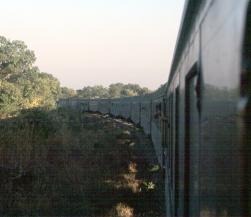 I had a first class seat on the good train on this route but it didn’t do much to increase comfort.
I found myself in a cabin with a couple men and a family of Gambian bumpkins.
One of the men took my cycle bags from the overhead rack and re-arranged them, piling them higher up on top of his sack despite my protests.
When my bags later fell down on top of the family I got several angry glares.
I guess they thought since the bags were mine, it must be my fault they fell.
I had a first class seat on the good train on this route but it didn’t do much to increase comfort.
I found myself in a cabin with a couple men and a family of Gambian bumpkins.
One of the men took my cycle bags from the overhead rack and re-arranged them, piling them higher up on top of his sack despite my protests.
When my bags later fell down on top of the family I got several angry glares.
I guess they thought since the bags were mine, it must be my fault they fell.
At the border, Senegalese passport control was a chaotic mess. In Mali a man came around to each cabin. He told me my “visa,” actually a letter, was not a visa but just a temporary substitute and that I would have to go to Immigration in Bamako to replace it with a real visa. This was no surprise but it was a surprise when the other man in the cabin quietly wrote me a note asking his friend in Immigration to help me quickly. It turned out the man was an immigration official himself.
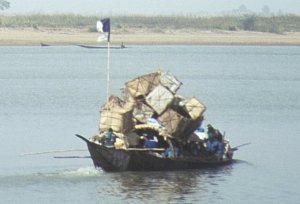 The road looked nice from the train and I was sorry not to have cycled it.
What I saw was a dry dirt track wandering up and down over small hills next to the riverside.
I was even more sorry when I couldn’t manage to call my family from Bamako for Christmas anyway, and when I saw what the other side of Mali was like.
Arrival in Bamako was a hassle. I couldn’t retrieve my bike until the next day.
When I did retrieve it that wasted so much of my time that I had to give up all hope of getting my paperwork done quickly.
It took many days despite the letter from the man on the train, which saw me through Bamako immigration in fifteen minutes and saved me days of waiting.
The road looked nice from the train and I was sorry not to have cycled it.
What I saw was a dry dirt track wandering up and down over small hills next to the riverside.
I was even more sorry when I couldn’t manage to call my family from Bamako for Christmas anyway, and when I saw what the other side of Mali was like.
Arrival in Bamako was a hassle. I couldn’t retrieve my bike until the next day.
When I did retrieve it that wasted so much of my time that I had to give up all hope of getting my paperwork done quickly.
It took many days despite the letter from the man on the train, which saw me through Bamako immigration in fifteen minutes and saved me days of waiting.
I moved from the expensive hotel I had stayed in on arrival in Bamako to the Pension MS, a cheap hotel/brothel. From there I got out and around town, enjoying excellent food but not enjoying the horrible traffic. Bamako sits on the banks of the river Niger, surrounded by low hills and bluffs. The climate was dry and the air dusty at the best of times, and the environment wasn’t improved by the rickety contraptions travelling up and down the streets belching toxic fumes everywhere. It had a few low-rise buildings in the centre of town and a few nice hotels scattered here and there. A more modern eastern strip held the embassies and supermarkets and other foreigners’ haunts.
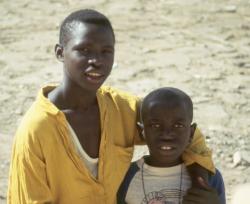 A few days before Christmas I started to develop a mysterious fever.
It got slightly worse every day and much worse at night until one night I had a delirious nightmare and woke up while sleepwalking around the room.
At that point I took my quinine and the fever went away within a day.
Malaria? My best guess but that’s not worth much.
I didn’t want the hassle of finding a doctor over the holiday season, and expected if I did he or she would likely prescribe a malaria cure without waiting for test results.
Looking back, this was probably not too smart.
Quinine has nasty side-effects of its own, including hearing damage and possible heart trouble.
A few days before Christmas I started to develop a mysterious fever.
It got slightly worse every day and much worse at night until one night I had a delirious nightmare and woke up while sleepwalking around the room.
At that point I took my quinine and the fever went away within a day.
Malaria? My best guess but that’s not worth much.
I didn’t want the hassle of finding a doctor over the holiday season, and expected if I did he or she would likely prescribe a malaria cure without waiting for test results.
Looking back, this was probably not too smart.
Quinine has nasty side-effects of its own, including hearing damage and possible heart trouble.
Christmas dinner was a giant watermelon and Lebanese food, shared with a South African couple. Bamako had a lot of people who prey on foreign tourists and they regularly pestered us when we sat down in cafes for dinner. One particularly aggressive pest sprinted up to me outside a restaurant and I immediately waved him off. This was a mistake. For three days this guy shouted abuse at me every time he saw me outside, calling me a racist. I might perhaps have guessed wrongly about what he had wanted but didn’t see any evidence later to change my mind.

East of Bamako the road was blacktop highway, very smooth and flat and easy and utterly boring. I saw no sights. The scenery gradually got drier and dustier, angling through the Sahel in the vague direction of the Sahara. Villages were pleasant enough but not visibly different from any of the dozens I had passed before. Also, I was still weak from my mystery fever and found the hot sun made it tough to cycle so I stopped pedalling and took the bus to Ségou.
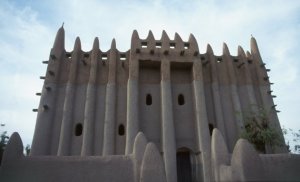 New Years’ in Ségou was a big improvement over Christmas in Bamako.
I bought a large pile of fireworks and had fun tossing them around and giving them to local boys to toss.
Segou was much more rural and friendly than Bamako and didn’t produce as many tourist parasites.
One still managed to attach himself to me and to other foreigners, and pester us constantly to go with him to see small villages
Finally we told him flatly to go away. That earned us the racist label again. I didn’t care.
New Years’ in Ségou was a big improvement over Christmas in Bamako.
I bought a large pile of fireworks and had fun tossing them around and giving them to local boys to toss.
Segou was much more rural and friendly than Bamako and didn’t produce as many tourist parasites.
One still managed to attach himself to me and to other foreigners, and pester us constantly to go with him to see small villages
Finally we told him flatly to go away. That earned us the racist label again. I didn’t care.
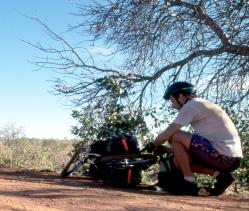 From Segou I continued by bus to Mopti, a big tourist centre complete with teeming schools of touts and tourist leeches.
I liked it anyway because it was almost the other side of the Sahara from Morocco, and the thought of that appealed to me in some way, as did the rugged semi-desert scenery.
On the outskirts of town were Tuareg refugee camps and in town people from everywhere.
From Segou I continued by bus to Mopti, a big tourist centre complete with teeming schools of touts and tourist leeches.
I liked it anyway because it was almost the other side of the Sahara from Morocco, and the thought of that appealed to me in some way, as did the rugged semi-desert scenery.
On the outskirts of town were Tuareg refugee camps and in town people from everywhere.
Djenné, in contrast, was a nightmare. I made a day trip and shortened it to a brief afternoon stroll. When I turned down a local “guide” he followed me around all afternoon shouting abuse. This made me determined not to hire any guides, on principle, but it also made for an unsatisfying day. The famous mud-brick mosque there may be the biggest in the world but it was no better looking than were others I had seen or saw later, and Djenné was no more interesting a town than others nearby.
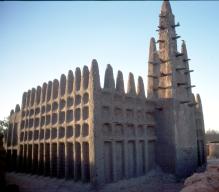 On that day trip I had some trouble with police because I hadn’t registered when I’d arrived in Djenné.
Registration was no longer officially required but the police pestered you anyway.
I escaped that time by pointing out that I had only been in town for two hours.
When I left Mopti later I ran into another checkpoint and told them I would register when I returned to Mopti.
This translated to "never" but they didn’t ask far enough to discover that so I didn’t tell them.
On that day trip I had some trouble with police because I hadn’t registered when I’d arrived in Djenné.
Registration was no longer officially required but the police pestered you anyway.
I escaped that time by pointing out that I had only been in town for two hours.
When I left Mopti later I ran into another checkpoint and told them I would register when I returned to Mopti.
This translated to "never" but they didn’t ask far enough to discover that so I didn’t tell them.
The trip to Timbuktu was impractical at that time of year, by bicycle, so I cycled south through the Dogon country instead. I made a small mistake and left Mopti too late, at seven a.m. instead of six, which meant I got caught out in the afternoon sun. My progress stopped almost completely. I rode for twenty minutes then spent forty resting under a tree. I kept on that way all the way to Bandiagara anyway, because I had no choice. My rule was never to cycle after dark if I could avoid it. I did make it to Bandiagara an hour before sunset, and rewarded myself with a cold Coke just outside of town with time to spare.
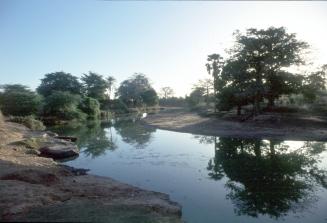 Bandiagara didn’t have a huge selection of hotels so I accepted an invitation from two French volunteer aid workers to stay with them.
They told me the road I had taken was infested with bandits and that they had been held up on it just after sunset one day,
most likely with police connivance as it happened very near a checkpoint.
This second near-miss with bandits confirmed my no-cycling-after-dark policy doubly in my mind and when I left I made sure to get out as early as possible.
Bandiagara didn’t have a huge selection of hotels so I accepted an invitation from two French volunteer aid workers to stay with them.
They told me the road I had taken was infested with bandits and that they had been held up on it just after sunset one day,
most likely with police connivance as it happened very near a checkpoint.
This second near-miss with bandits confirmed my no-cycling-after-dark policy doubly in my mind and when I left I made sure to get out as early as possible.
That early departure was a particularly good idea that day as the road turned out to be the worst I ever saw anywhere in the world. I had a flat tire within an hour, then another and another. The flats stopped as I carried my bicycle over a “road” paved with boulders the size of bowling balls. Even so, I found time to look at Dogon villages on the way, and time to fend off a few touts and large crowds of children begging for pens. Dogon country is famous around the world for its exotic customs but like most other places I went in Mali, it showed the worst effects of mass tourism. When I reached the edge of the escarpment I gave up on the road altogether and headed down on the bare rock and on small footpaths. At the bottom people were more friendly and less trouble so I stopped for a drink of Indian Tonic and rested an hour or two. Then I pushed on, literally: the next twelve kilometres of road were one long trench of soft sand and I had run out of spare tubes for my tires, which were now both flat. I couldn’t have cycled anyway so didn’t care much.
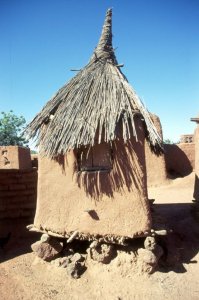 I made it to Bankass, arriving at sunset again, and found the Campement and local restaurant, both busy with overland trucks and other tourists.
The restaurant might possibly have been the worst-run in the world but there was nowhere else to eat so we endured.
The tire problem turned out to be a combination of things resulting in ruined valves on the inner tubes.
They were beyond fixing and needed to be replaced.
I made it to Bankass, arriving at sunset again, and found the Campement and local restaurant, both busy with overland trucks and other tourists.
The restaurant might possibly have been the worst-run in the world but there was nowhere else to eat so we endured.
The tire problem turned out to be a combination of things resulting in ruined valves on the inner tubes.
They were beyond fixing and needed to be replaced.
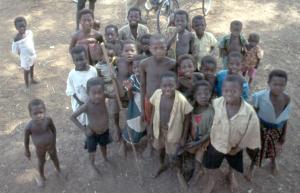 Cycling south the next day, I hit soft sand again. It stretched on for eighteen exhausting kilometres.
When I finally hit the normal rocky and corrugated dirt road again, I stopped and stretched out under a tree to relax a bit before pressing on to.
Koro had an easy-going border post where nobody cared about my lack of registration stamps.
It also had a Campement and a bar with cold drinks and a helpful owner.
While I chatted with him, a Dutch overland truck arrived and I happily accepted a ride onto Ouahigouya, the next decent-sized town down the road in Burkina-Faso.
Cycling south the next day, I hit soft sand again. It stretched on for eighteen exhausting kilometres.
When I finally hit the normal rocky and corrugated dirt road again, I stopped and stretched out under a tree to relax a bit before pressing on to.
Koro had an easy-going border post where nobody cared about my lack of registration stamps.
It also had a Campement and a bar with cold drinks and a helpful owner.
While I chatted with him, a Dutch overland truck arrived and I happily accepted a ride onto Ouahigouya, the next decent-sized town down the road in Burkina-Faso.
Ouahigouya had nothing so I continued on the Dutch truck to Ouagadougou. There I found spare tubes without any great problem. I got to know the people on the truck; they were a mix of different singles, all on their way to Cameroon. We stayed in Ouagadougou a few days, stuffing our faces with good food and getting visas and dancing the night away. The Dutch group offered to take me along with them as far as I wanted, and I accepted a ride to Kumasi in Ghana. What I had seen of the countryside so far was, except for the Dogon country, much the same as on that first day riding out of Bamako; flat, hot and boring with no wildlife or sights.
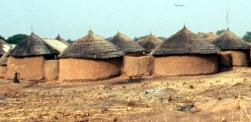 The truck ride turned out to be a good deal, as the road indeed continued to bore me all the distance to Kumasi.
We stopped for a couple days at Mole National Park on the way.
From a comfortable viewing deck on a hillside we watched elephants coming to drink at a crocodile-infested pool.
A few baboons wandered in and out of the tourist area, and the occasional elephant.
A couple boys came by the restaurant one afternoon, carrying a biggish lizard they had killed to eat.
Conservation didn’t seem to be the top priority of park management.
The truck ride turned out to be a good deal, as the road indeed continued to bore me all the distance to Kumasi.
We stopped for a couple days at Mole National Park on the way.
From a comfortable viewing deck on a hillside we watched elephants coming to drink at a crocodile-infested pool.
A few baboons wandered in and out of the tourist area, and the occasional elephant.
A couple boys came by the restaurant one afternoon, carrying a biggish lizard they had killed to eat.
Conservation didn’t seem to be the top priority of park management.
The truck rolled on, crossing the Volta a few times and stopping for drinks every now and then, and finally arriving in Kumasi. We put up there at a mission guesthouse, some of us taking rooms and some of us camping on the lawn. Kumasi had a bit to offer, keeping us all busy for a couple days. It looked more modern than the other cities I’d passed through in West Africa, but had crime problems. Most places in Ghana one could wander freely and safely (except during occasional tribal scuffles). In Kumasi you had to be more careful, especially after dark.
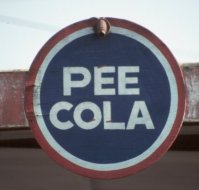 I cycled south from Kumasi. The scenery now was hilly jungle and much more interesting, green with small shack villages.
While stopped by the side of the road for a drink, I idly watched a squirrel run across the road.
A truck hit it and immediately all traffic in sight screeched to a halt.
The drivers got out and ran to see who could get the squirrel first.
The winner carried it off for dinner with a happy smile on his face.
Later that day, I saw people proudly showing off bush rats they had caught and killed, also.
In some parts of West Africa they call these Grasscutters, and they are apparently a delicacy.
I never got to try one but their popularity was evident!
I cycled south from Kumasi. The scenery now was hilly jungle and much more interesting, green with small shack villages.
While stopped by the side of the road for a drink, I idly watched a squirrel run across the road.
A truck hit it and immediately all traffic in sight screeched to a halt.
The drivers got out and ran to see who could get the squirrel first.
The winner carried it off for dinner with a happy smile on his face.
Later that day, I saw people proudly showing off bush rats they had caught and killed, also.
In some parts of West Africa they call these Grasscutters, and they are apparently a delicacy.
I never got to try one but their popularity was evident!
The coast was quite a different area again from the interior, with its gigantic whitewashed slaving forts and different peoples. I quite liked it but by now I was in a hurry to push on to Accra and collect my mail. I hitched a last ride with a pickup truck to avoid crazy dangerous traffic on the coast highway, all the way to Accra.
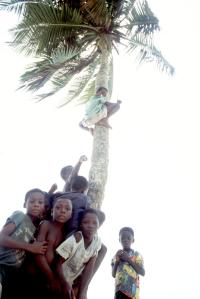 Perhaps predictabyly, my mail hadn’t arrived yet in Accra and my rushing had been wasted effort.
I waited. While I waited the Dutch truck arrived and we went out for more nightlife.
They continued on towards Cameroon a few days later and offered to take me with them.
I would have liked to go but by then had busywork to do with visas and mail so had to say no.
I thought I would never see them again but was completely wrong. We both stayed in Accra and Ghana much longer than expected.
Perhaps predictabyly, my mail hadn’t arrived yet in Accra and my rushing had been wasted effort.
I waited. While I waited the Dutch truck arrived and we went out for more nightlife.
They continued on towards Cameroon a few days later and offered to take me with them.
I would have liked to go but by then had busywork to do with visas and mail so had to say no.
I thought I would never see them again but was completely wrong. We both stayed in Accra and Ghana much longer than expected.
I had a major problem here: I found it impossible to get a Nigerian visa. I had tried and failed in Ouagadougou. I tried again and failed again in Accra. The Dutch truck failed in Lomé. Other people we knew tried and failed in Cotonou. The only nearby place where I knew I could get one was Abidjan but I wasn’t willing to head off in the wrong direction to do it. The news was full of stories about Cameroon and Nigeria shooting at each other in the Bakassi peninsula, so it wasn’t clear that I could cycle on from Nigeria to Cameroon even if I got into Nigeria. I soon gave up on the land route to Central Africa.
Next in line was the possibility of moving by boat from Ghana to Cameroon. This was possible but looked to be quite expensive and possibly time-consuming as well. It still left the problem of getting through CAR and Congo and obtaining visas which would cost still more money. The cost finally convinced me to leave out Central Africa. I didn’t want to. When I bought my bicycle, I had in mind specifically those areas, where a bike would bring the biggest advantage. I consoled myself with thoughts of cycling into central Africa from Uganda.
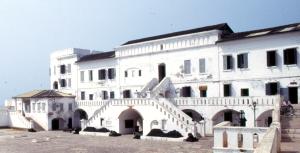 All this took a couple weeks. While I was checking these things out I looked around Accra and bought souvenirs and gifts for home, and met people.
One night after I had all my souvenirs in the mail and a rough plan in mind, I went out to dinner.
On the way home I walked across the road and stepped over a divider in the middle only to discover there was nothing on the other side.
The resulting tumble twisted my ankle so badly I couldn’t walk and couldn’t sleep properly for a few days, prolonging my stay in
Accra still more.
All this took a couple weeks. While I was checking these things out I looked around Accra and bought souvenirs and gifts for home, and met people.
One night after I had all my souvenirs in the mail and a rough plan in mind, I went out to dinner.
On the way home I walked across the road and stepped over a divider in the middle only to discover there was nothing on the other side.
The resulting tumble twisted my ankle so badly I couldn’t walk and couldn’t sleep properly for a few days, prolonging my stay in
Accra still more.
The day after my accident the Dutch truck returned, having failed to make it any closer to Cameroon than Lomé. Their group split up here. When I’d first met them in Mali I got along well with all of them but they had a lot of tension with each other. By the time we’d made it to Ouagadougou, the driver had been fired and two or three passengers had left. On their first pass through Accra a couple more had gone, and now they all went their separate ways. Is this sort of friction inevitable on these long-haul trucks? I don’t think so; some groups seem to manage well. However, it does seem a common problem. Their relationships with each other became magnified way beyond their real importance, and there was always a hint of sex in the air. Some of the men picked up African women any time they stopped for the night in town, which also caused them some social problems.
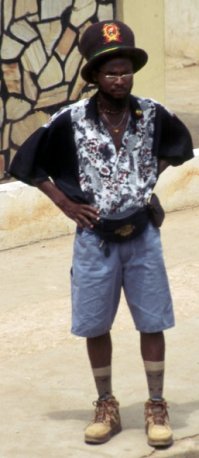 The truck owner was headed back north to park his truck until some future return, taking a couple of their group with him.
They invited me to come along back to Kumasi, or even Ouagadougou but, even had I wanted to, moving was simply too much trouble and (literally) too painful.
My own stay here wound down over the next couple weeks.
Gradually my foot improved till I could walk again.
I booked a ticket to Nairobi, then spent a few days touring the coast by bus.
The truck owner was headed back north to park his truck until some future return, taking a couple of their group with him.
They invited me to come along back to Kumasi, or even Ouagadougou but, even had I wanted to, moving was simply too much trouble and (literally) too painful.
My own stay here wound down over the next couple weeks.
Gradually my foot improved till I could walk again.
I booked a ticket to Nairobi, then spent a few days touring the coast by bus.
Two things happened before I left Ghana. First was the funeral of the chief who owned the hotel where I stayed. This was a big colourful party. Second, the government published a notice in a paper one day saying that many hotels and restaurants had failed licensing requirements and were ordered to shut down by March first. I saw many of the places I had stayed on the list but thought the announcement just bureaucratic noise. Then on March first I came back to my room after lunch and found a squad of uniformed policemen closing the hotel down. If they closed every place on the list, it must have caused the backpackers and low-budget visitors in Ghana infinite trouble. I managed to find a room in a hotel across the street, which I'd remembered had not been on the list, and there I ended my stay.
East Africa 1996
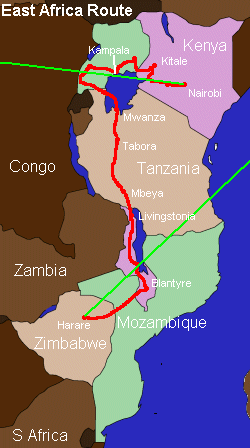 Ethiopian Airlines took me to Nairobi in comfort but charged me US$93 to carry my bicycle.
Reaching Nairobi, I passed a small personal milestone. I had made it all the way around the world.
At the airport I loaded my bags on my bike and rode into town.
The cool fresh air was an immediate relief, and I was very happy to be back somewhere familiar.
In the past I had stayed at the New Kenya Lodge in Nairobi but this time I opted for the Hotel Iqbal, which had more space for a bicycle.
It was also cleaner but in general I preferred the New Kenya, which had a more interesting crowd of people.
Ethiopian Airlines took me to Nairobi in comfort but charged me US$93 to carry my bicycle.
Reaching Nairobi, I passed a small personal milestone. I had made it all the way around the world.
At the airport I loaded my bags on my bike and rode into town.
The cool fresh air was an immediate relief, and I was very happy to be back somewhere familiar.
In the past I had stayed at the New Kenya Lodge in Nairobi but this time I opted for the Hotel Iqbal, which had more space for a bicycle.
It was also cleaner but in general I preferred the New Kenya, which had a more interesting crowd of people.
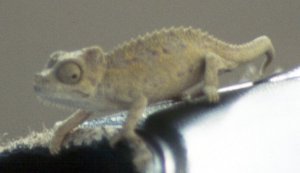 As this was my second visit to Nairobi, I had only a few things I wanted to do there: celebrate my thirtieth birthday,
collect mail, buy maps, perhaps find a cycling partner, then head off. This still took me three weeks.
I spent two just relaxing, reading cheap books, going to the movies, talking to old and new friends.
I found my maps and collected my mail and sent even more mail.
Then I got a cold or flu or some similar thing one night, and after it had an attack of giardia and that cost me another five days.
In that time I met a couple more cyclists and we agreed to start off together.
As this was my second visit to Nairobi, I had only a few things I wanted to do there: celebrate my thirtieth birthday,
collect mail, buy maps, perhaps find a cycling partner, then head off. This still took me three weeks.
I spent two just relaxing, reading cheap books, going to the movies, talking to old and new friends.
I found my maps and collected my mail and sent even more mail.
Then I got a cold or flu or some similar thing one night, and after it had an attack of giardia and that cost me another five days.
In that time I met a couple more cyclists and we agreed to start off together.
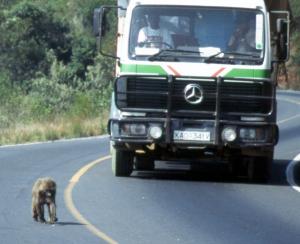 In Morocco I had cycled everywhere. In West Africa I had cycled less than half of my total distance.
I wasn't out for athletic achievement, just a better way to get around, but this still didn't sit well.
On the east side of the continent I determined to spend more time actually riding.
In Morocco I had cycled everywhere. In West Africa I had cycled less than half of my total distance.
I wasn't out for athletic achievement, just a better way to get around, but this still didn't sit well.
On the east side of the continent I determined to spend more time actually riding.
We started with a short ride to Limuru, in the hills outside Nairobi. Next day we carried on all the way to Lake Naivasha, a stretch of roughly eighty kilometres following a ridge line first, and then wandering over the floor of a hot and dry valley. This was a fairly rough ride, but we elected to do it all in one day anyway, as there were few places to stay on the way. We didn’t make it before dark and had to walk the last section of potholed road in the rain. Next day's ride went by more easily, easily to Fisherman’s Camp on the south side of the lake. We stayed a few days.
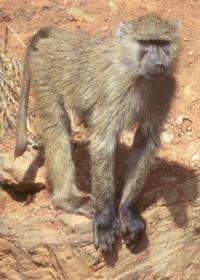 Nearby was Hell’s Gate Park, one of the few in Kenya where cyclists were allowed.
It had a rewarding variety of game and I recommend it highly.
I particularly liked the Rock Hyraxes, which live in cliffs.
These are the size of marmots but zoologists claim they are closely related to elephants.
They are not very shy and will pose nicely on rocks while you get your money’s worth out of your zoom lens.
It was also a particularly enjoyable feeling to buzz along on my cycle and have herds of zebra thunder across the road in front of me as they saw me coming.
Although zebra are supposed to be just a variation of horse, they make strange coughing sounds instead of the neigh or whinny sound I was familiar with,
so I had little advance warning of where they were.
Nearby was Hell’s Gate Park, one of the few in Kenya where cyclists were allowed.
It had a rewarding variety of game and I recommend it highly.
I particularly liked the Rock Hyraxes, which live in cliffs.
These are the size of marmots but zoologists claim they are closely related to elephants.
They are not very shy and will pose nicely on rocks while you get your money’s worth out of your zoom lens.
It was also a particularly enjoyable feeling to buzz along on my cycle and have herds of zebra thunder across the road in front of me as they saw me coming.
Although zebra are supposed to be just a variation of horse, they make strange coughing sounds instead of the neigh or whinny sound I was familiar with,
so I had little advance warning of where they were.
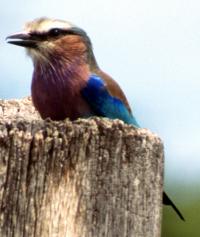 Lake Naivasha itself had birds and hippos and other animals.
The hippos had been a big problem at the campsite in the past, but the campsite manager had solved this by digging a big trench between his business and the lake.
I would have preferred the problem, I think.
Joy Adamson’s farm was nearby and there were backroads and bush trails to ride on. There was too much to see, in fact.
It would have been a good place to base myself and make short trips.
My basic purpose, however, was still to “survey” Africa so I pushed on yet again.
Lake Naivasha itself had birds and hippos and other animals.
The hippos had been a big problem at the campsite in the past, but the campsite manager had solved this by digging a big trench between his business and the lake.
I would have preferred the problem, I think.
Joy Adamson’s farm was nearby and there were backroads and bush trails to ride on. There was too much to see, in fact.
It would have been a good place to base myself and make short trips.
My basic purpose, however, was still to “survey” Africa so I pushed on yet again.
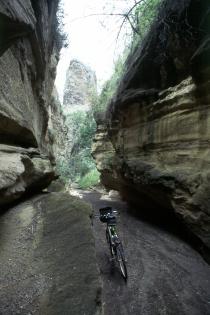 Our trio split up at this point, with the others leaving a day before me.
The road onwards followed the west side of the lake closely, passing through a few small villages, then split.
One branch merged with the main highway and another wandered up and over a high ridge.
Our trio split up at this point, with the others leaving a day before me.
The road onwards followed the west side of the lake closely, passing through a few small villages, then split.
One branch merged with the main highway and another wandered up and over a high ridge.
I took the high road. At the top of the hill the dirt track changed to an inexplicable 50 m of blacktop highway. I never found out the story behind this. Paved for a specific photo or video session, perhaps? On the other side of the hill, I missed the turn I wanted to take to Nakuru. This was probably just as well, because within half an hour it started to rain and the road turned to mud. When I finished the short distance to the main highway my wheels and brakes and frame were coated with centimetres of thick sticky mud. I really hadn’t wanted to cycle on this “highway of death”, the A104 into Nakuru, but it was a more pleasant ride knowing the alternative was impossible.
I stayed a few days in Nakuru, making a dash by bus back into Nairobi one long day to pick up mail. When I left, I timed my exit so I would ride the route of the Kenya Safari Rally just as it went past. This brought me a lot of good photos but it also caused me large crowd problems as hundreds of young children decided I was more interesting than the rallyists and their cars. I escaped and climbed up and up and up and up to Kericho, passing green hillsides with tea and coffee plantations. The next day I breezed down and down and down, all the way to Kisumu on Lake Victoria.
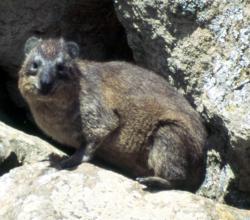 Kisumu was a largish, slow-paced city. It had a pleasant campsite on the lake, with reeds covering the shoreline and the occasional distant hippo to see.
Fireflies made for pleasant evenings there.
Leaving town I rode up and up into the hills again, climbing to Kakamega and passing the equator on the way.
This highway was too busy for comfort and I didn’t appreciate it at all.
Kenyan roads were generally dangerous and there more than most places I tried to stay on back roads.
Kakamega to Kitale, on the other hand, went easily and pleasantly.
In Kitale I met up with the two other cyclists again.
We had wanted to continue around the north side of Mt. Elgon but it rained almost daily and we had heard the mud on the road could be very bad,
so instead we took the south road, around to Mbale in Uganda in two days.
Kisumu was a largish, slow-paced city. It had a pleasant campsite on the lake, with reeds covering the shoreline and the occasional distant hippo to see.
Fireflies made for pleasant evenings there.
Leaving town I rode up and up into the hills again, climbing to Kakamega and passing the equator on the way.
This highway was too busy for comfort and I didn’t appreciate it at all.
Kenyan roads were generally dangerous and there more than most places I tried to stay on back roads.
Kakamega to Kitale, on the other hand, went easily and pleasantly.
In Kitale I met up with the two other cyclists again.
We had wanted to continue around the north side of Mt. Elgon but it rained almost daily and we had heard the mud on the road could be very bad,
so instead we took the south road, around to Mbale in Uganda in two days.
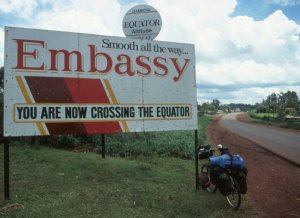 Somewhere on this road I stopped under a tree to rest and a large bearded man came up to me.
His name was Johnstone and he liked to preach, and he thundered the bible at me for ten minutes while I waited for my friends to catch up.
After his sermon he gave me twenty shillings and told me to go buy myself a Coke.
Somewhere on this road I stopped under a tree to rest and a large bearded man came up to me.
His name was Johnstone and he liked to preach, and he thundered the bible at me for ten minutes while I waited for my friends to catch up.
After his sermon he gave me twenty shillings and told me to go buy myself a Coke.
Historical note: by this time in 1996 the Rwandan civil war had ended, and the Congolese civil war had not yet begun. Nobody who paid attention would consider it peaceful, though. Huge numbers of people had fled into the eastern Congo from Rwanda and were already destabilizing it. In northern Uganda the LRA also presented a major danger. Southern Uganda had made great strides recovering from decades of civil war and travel there was safe enough, given the usual precautions one should take anywhere. Banditry and terrorism remained serious concerns in the southern border areas, as they had for many years.
Near the Ugandan border, “death highway” 104 was actually quite quiet. At the border itself a lot of trucks had accumulated, including many vehicles from UNAMIR (the UN mission to Rwanda), which was just leaving then. On the Ugandan side the road was also quiet and pleasant until it joined the road from Kampala to Mbale, at which point it became busy and dangerous. Coming from Kenya, Mbale (and by extension Uganda) seemed broken and run-down, with semi-functioning power and water and little to buy in shops and restaurants. Its setting in hill country was dramatic, but Uganda’s landscape seemed more imposing than its architecture.
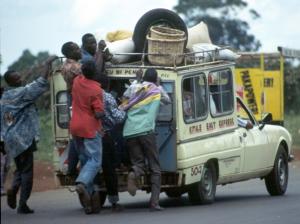 Near Mbale we saw Sipi Falls, a moderate flow over a projecting cliff on the side of Mount Elgon.
We reached the place in a day trip out by public mini-van.
On the way back our van broke down near a field of sugar cane and while we waited for repairs, a couple people raided the field and presented us with sticks to chew and suck on.
The raw sugar cane juice was very good and thoroughly refreshing, although probably not good for our teeth.
Near Mbale we saw Sipi Falls, a moderate flow over a projecting cliff on the side of Mount Elgon.
We reached the place in a day trip out by public mini-van.
On the way back our van broke down near a field of sugar cane and while we waited for repairs, a couple people raided the field and presented us with sticks to chew and suck on.
The raw sugar cane juice was very good and thoroughly refreshing, although probably not good for our teeth.
I rode off on my own from this point, down the direct and less busy dirt road towards Kampala. This was tough going, due to a rough road and hot weather, so I had to stop in Iganga that night. This small road town somehow managed to support an expensive night spot and a reasonable hotel, possibly patronized by aid workers based there. In two more nights I made Jinja and Kampala, stopping to see one of the sources of the Nile on the way. My first impressions of Uganda held true: its cities looked much like those in Kenya in some ways, except perhaps that they looked both to have been better built and to have degraded more.
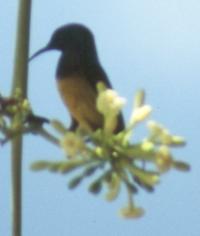 At Kampala I settled in at the Backpacker’s Hostel just outside of town.
As in Nairobi, in Kampala I mainly stopped for business.
However, since my last trip to Africa in 1994 Kampala had apparently become the centre of the African backpacker’s universe, rather than Nairobi.
At the campsite I met almost all of the people I had earlier seen in Accra, on the other side of the continent.
They had crossed the Congo and were continuing on their way south.
At Kampala I settled in at the Backpacker’s Hostel just outside of town.
As in Nairobi, in Kampala I mainly stopped for business.
However, since my last trip to Africa in 1994 Kampala had apparently become the centre of the African backpacker’s universe, rather than Nairobi.
At the campsite I met almost all of the people I had earlier seen in Accra, on the other side of the continent.
They had crossed the Congo and were continuing on their way south.
I also met many people on their way to see gorillas, heading into one of the most politically unstable areas of the world.
One day a group of Ugandan rebels attacked the town of Kisoro, coming across the border from Congo in the centre of gorilla country.
Nobody seemed sure who the rebels were but the Peace Corps and other foreign agencies pulled all their staff out of the area.
I met a woman who was in Kisoro at the time and she commented that the locals had all worried for her safety,
particularly fearing she might be kidnapped.
The aim of the raid was apparently the town armoury, and the rebels succeeded — so they were armed and at large.
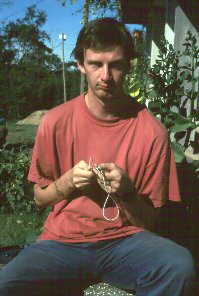
Despite this, tourists kept tramping off to see the gorillas, only a couple days after the attacks. When I asked them if they thought this was wise I got various unreasoned responses such as “well, you have to take some risks” and “they think it was just a one-off attack.” I've always found this attitude baffling. You must take some risks, true, but this doesn’t mean taking stupid risks or heading deliberately to trouble areas. In this case, the facts quite directly contradicted such thinking, as well. A year or two later, around a dozen gorilla tourists were killed in a similar raid.
During the time covered in this story, I counted about twelve backpackers who had got themselves killed by ignoring dangers they shouldn’t have. I don't think I knew any of them personally, but I'm sure I knew the type. They’d avoided one pitfall by realizing that foreign countries aren’t always dangerous, but then they apparently fell into the twin pit of thinking they are never dangerous. A lot of misinformation seemed to combine with an unhealthy tendency to trust word-of-mouth advice, yielding a dangerous cocktail.
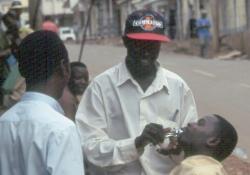 Visas took me one week in Kampala, sightseeing another, and then I found an interesting book called “The Scramble for Africa” and that took me a week to read.
While I was waiting people came and went: aid workers, overland truckers and even a group of three pink buses full of drunken Swedish tourists
calling themselves “The Pink Caravan.”
Visas took me one week in Kampala, sightseeing another, and then I found an interesting book called “The Scramble for Africa” and that took me a week to read.
While I was waiting people came and went: aid workers, overland truckers and even a group of three pink buses full of drunken Swedish tourists
calling themselves “The Pink Caravan.”
Another delay came during the Presidential Elections. This was mainly a contest between the current president Museveni and an old boy from the Obote days named Ssemogerere. Foreigners were solidly behind Museveni. Ssemogerere’s comments, or at least those printed in public, suggested electing him would be a national disaster on a par with re-electing Idi Amin. We weren’t sure how Ugandans felt, though, so many foreigners found excuses to leave before elections and others had escape plans ready. In the event, Museveni won a large victory with only the north voting solidly for Ssemogerere. Most people I met were generally relieved.
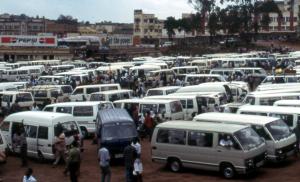 When I was about ready to move again, I couldn’t because I had developed some strange medical problem with weakness and headaches.
I went to the doctor, who found an amoebic cyst in my blood and strange marks on my back.
He didn’t know what to think so prescribed a course of Fasigyn for me as he was sure it must be some sort of parasite.
Probably he was right because the drug did the trick.
By that time I had been there for four weeks.
When I was about ready to move again, I couldn’t because I had developed some strange medical problem with weakness and headaches.
I went to the doctor, who found an amoebic cyst in my blood and strange marks on my back.
He didn’t know what to think so prescribed a course of Fasigyn for me as he was sure it must be some sort of parasite.
Probably he was right because the drug did the trick.
By that time I had been there for four weeks.
Towards the end of the drug treatment came a dog problem. Kampala had many wild and semi-wild dogs, and some of them would invade the campsite at night and run wild causing trouble. The owner tolerated them, or slept too soundly to catch them, until one night they went wilder than usual, smashing furniture and killing his two newly-acquired kittens. I suggested shooting them and he shot down my stupid idea, pointing out we were in city limits. Somehow I had never thought of these laws as mattering there. The night of the dog attack somebody must have agreed with me, as we heard shooting and squeals from a nearby house.
The owner called the city council to solve the dog problem, and they laid poison bait around the campsite. The next morning seven dead dogs lay there, including the cat-killers. The day after, three or four more dead dogs also lay there. This wasn’t planned. Some bait had been scattered around the property, apparently. The next day another dog died, but this one was a nice dog who had never caused trouble. The owner was unhappy. He was even more unhappy when some disgruntled neighbour poisoned his own dog the day after that.
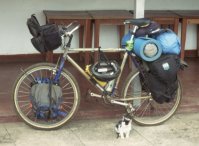 About the time of the dog battle another cyclist rode in, coming down from the north.
He and I traded stories. We were both going south, he on a slightly different route than I was.
We agreed that Uganda had the worst and most dangerous drivers we had ever seen, even including Kenya.
He left by ferry for Mwanza, and the next day we heard a Lake Victoria ferry had sunk with an estimated five hundred dead.
Luckily for him, the sunken boat wasn’t the one he was on but another one coming from Bukoba.
The boat had capsized during the night but many people apparently survived till the next day, when authorities drilled a hole in the bottom/top to get them out.
This released the air bubble below decks and causing it to sink instantly.
About the time of the dog battle another cyclist rode in, coming down from the north.
He and I traded stories. We were both going south, he on a slightly different route than I was.
We agreed that Uganda had the worst and most dangerous drivers we had ever seen, even including Kenya.
He left by ferry for Mwanza, and the next day we heard a Lake Victoria ferry had sunk with an estimated five hundred dead.
Luckily for him, the sunken boat wasn’t the one he was on but another one coming from Bukoba.
The boat had capsized during the night but many people apparently survived till the next day, when authorities drilled a hole in the bottom/top to get them out.
This released the air bubble below decks and causing it to sink instantly.
Finally I left Kampala, riding to Mityana and Mubende on the road to Fort Portal. The road that far was great, but after Mubende it changed to dirt. I had pulled a muscle in my leg on the way to Mityana and found the last half of the road very tough going so hitched a ride with some Serbian highway engineers, who were busy paving the dirt section, into Fort Portal.
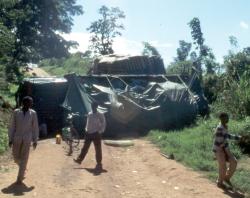 In Fort Portal you see some of Africa’s most dramatic and impressive scenery.
At least, you do if clouds don’t surround it but the clouds were thick when I arrived, and it rained almost every day I spent in western Uganda.
I rode on into Kibale Forest, which was also very nice, cool with open treescapes in all directions, then stayed a couple days to watch wildlife.
I saw many monkeys but no chimpanzees and took a most interesting bush path over the hills to rejoin the main highway at Kasese, where I stopped for the night.
In Fort Portal you see some of Africa’s most dramatic and impressive scenery.
At least, you do if clouds don’t surround it but the clouds were thick when I arrived, and it rained almost every day I spent in western Uganda.
I rode on into Kibale Forest, which was also very nice, cool with open treescapes in all directions, then stayed a couple days to watch wildlife.
I saw many monkeys but no chimpanzees and took a most interesting bush path over the hills to rejoin the main highway at Kasese, where I stopped for the night.
From Kasese I rode into Queen Elizabeth Park, crossing the equator again. In the park I rode past lines of baboons watching me, around herds of buffalo and antelope. The road followed a valley bottom, between steep hills at the base of the Ruwenzoris. At Kazinga Channel I stopped for the night and stayed in a bedbug-infested local hotel rather than pay the huge amount extra to get into the “official” part of the park for the night.
There I had to make another decision: keep to the main road or take a more direct dirt road south? I was heading for Kisoro. The attack was weeks past by then and the alert over. Park authorities told me the dirt road was fine, not to worry about the lions. I should find it easy going unless it got wet. UN vehicles piling up there warned me about trouble in the refugee camps in Congo, a precursor to the revolution which overthrew Mobutu, but since I wasn’t going that far I didn’t care. Lions I did care about, but I thought I could safely discount the truck driver who swore he saw tigers. Anyway, the next morning it was raining and the dirt road turned to mud, so I didn’t need to decide.
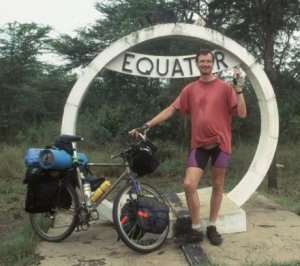 Continuing on the main road I rode around in a big loop over hills and ridges, past tea and coffee plantations to Bushenyi.
That was enough hill country for me.
I dropped my plans for Kisoro and carried on to Mbarara, then from there rode on back roads to Rakai, where aid workers were astonished to see me.
Finally I rode on bush paths to the border with Tanzania.
This produced a fun, if mean, set of encounters with village children who ran away screaming in terror at the sight of my horrible white face and strange spaceman-like cycling gear.
Continuing on the main road I rode around in a big loop over hills and ridges, past tea and coffee plantations to Bushenyi.
That was enough hill country for me.
I dropped my plans for Kisoro and carried on to Mbarara, then from there rode on back roads to Rakai, where aid workers were astonished to see me.
Finally I rode on bush paths to the border with Tanzania.
This produced a fun, if mean, set of encounters with village children who ran away screaming in terror at the sight of my horrible white face and strange spaceman-like cycling gear.
At the border I had a disagreement of opinion with an Immigration official about whether I had overstayed or not, confusion caused by a visa extension I obtained before my first visa ran out. He heckled and chastised and browbeat me, then let me grovel and admit my terrible mistake before asking for a bribe. I played along with all this and finally escaped without paying him anything, into Tanzania.
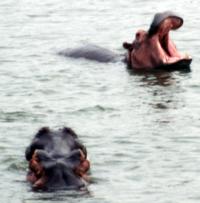 My impressions of Uganda were mixed overall.
The scenery and sights were as impressive as anywhere in Africa I’d been, and in the cities I enjoyed myself very much and the people were friendly.
In the countryside, though, I found many people treated me like some sort of strange animal.
I often thought they would rather have poked me with a stick than say hello.
The roads were filled with crazy dangerous drivers who really didn’t seem to care if they killed me or anyone else.
In general the people seemed dehumanized, which shouldn’t be surprising given their recent history and the
immense devastation of years of civil war.
My impressions of Uganda were mixed overall.
The scenery and sights were as impressive as anywhere in Africa I’d been, and in the cities I enjoyed myself very much and the people were friendly.
In the countryside, though, I found many people treated me like some sort of strange animal.
I often thought they would rather have poked me with a stick than say hello.
The roads were filled with crazy dangerous drivers who really didn’t seem to care if they killed me or anyone else.
In general the people seemed dehumanized, which shouldn’t be surprising given their recent history and the
immense devastation of years of civil war.
When I met people who seemed exceptions to this they almost always turned out to be from other countries. In no other country have I got these impressions, and I find while other tourists don’t generally share my opinions, other cyclists I have met do. When people tell you Ugandans (or others in current war zones) are beautiful and super-friendly, reply “If they’re so friendly why have they spent the last forty years killing each other?” I do recommend visiting but in Uganda more than elsewhere one will learn a lot by getting off the tourist track.
Uganda was also a good showcase of aid agency work and all its worst features. Nobody with eyes could miss the large population of fat men in three piece suits driving their shiny white jeeps. Sometimes they used their vehicles to move house, sometimes they used them to run me off the road, but rarely did I see them being used for any good purpose.
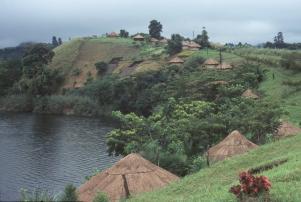 I hadn’t expected to like Tanzania, because of the hassles I had had getting a visa and because of the tales of bureaucracy and tourist annoyance that I had heard.
My first sight of it encouraged me, though.
The people I met were friendly and didn’t hassle me as in Uganda.
The road from the border was bad at first and got worse but I managed and as I managed I grew to like the place more and more.
I hadn’t expected to like Tanzania, because of the hassles I had had getting a visa and because of the tales of bureaucracy and tourist annoyance that I had heard.
My first sight of it encouraged me, though.
The people I met were friendly and didn’t hassle me as in Uganda.
The road from the border was bad at first and got worse but I managed and as I managed I grew to like the place more and more.
The western side of Lake Victoria was hill country, and I found myself riding up and down gentle slopes all the way from the border into Bukoba. This was a quiet run-down town with a couple good hotels and a campground, founded a hundred years earlier by the eccentric German/British leader Emin Pasha. The dirt streets reminded me of an old western American frontier town. Indoors they kept up to date more, with Michael Jackson videos playing in the bar and well-stocked pharmacies. Food didn’t abound, however, and the few restaurants tended to serve a couple variations on fish.
Moving on from Bukoba I had yet another route problem. I had wanted to cycle to Lake Tanganyika and then take the ferry to Zambia However, since the ferry on Lake Victoria had sunk a few weeks earlier, many going south had decided to take the land route and bandits had been raiding the road daily. Overland trucks put their passengers on boats to Mwanza, then drove through taking no valuables with them. I took the ferry. It didn’t sink and I quite enjoyed the ride.
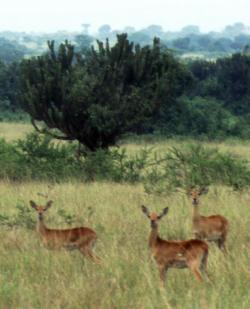 I liked Mwanza, as I had liked Bukoba.
The hills rolled a bit less there and the country was generally a bit more bleak and flat.
The town sat among dry rocky hills with bits of scrub and thorn bush.
Although pleasant enough, it didn’t tempt me for more than a couple days.
Next I planned to ride south in more or less a straight line through Tabora to Mbeya.
That road started out very bad, then slightly better, then developed pavement, then grew worse again.
The wind blew in my face all the way.
After 80-odd km I hitched a ride with a jeep I saw stopped at an intersection.
I liked Mwanza, as I had liked Bukoba.
The hills rolled a bit less there and the country was generally a bit more bleak and flat.
The town sat among dry rocky hills with bits of scrub and thorn bush.
Although pleasant enough, it didn’t tempt me for more than a couple days.
Next I planned to ride south in more or less a straight line through Tabora to Mbeya.
That road started out very bad, then slightly better, then developed pavement, then grew worse again.
The wind blew in my face all the way.
After 80-odd km I hitched a ride with a jeep I saw stopped at an intersection.
The driver, a Namibian, worked for Anglo-American at the nearby Mwadoi diamond mine. He invited me to come and stay for the night, and there they plied me with free food and drinks and hot water. The Mwadoi diamond mine had been started by a Canadian prospector around the time of colonization, then had prospered for a while and finally run out of business. In its heyday it was apparently a large self-supporting company town with happy families and community life. By the nineties it was almost deserted, but DeBeers and Anglo-American had made a deal with the Tanzanian government to re-open it and mine the tailings. They had a group of foreign workers there running things with some local help. Some of them told me a story about a plane which had landed on their runway twenty-five years ago. It had needed a spare part, which they had sent for, but the part never came and the plane was still sitting on the runway. Maintenance didn’t seem to be Tanzania’s strong point: the ferry capsizing on Lake Victoria was also eventually ascribed to poor maintenance.
From the mine I cycled south to Nzega and the next day on towards Tabora. The road grew worse and worse, with deep ruts and thick sand and gravel through gently rolling countryside carpeted with thick brush. My progress slowed until I faced a night in the bush. That particular section of bush didn’t look inviting so instead I hitched a ride on a truck into Tabora. This sits pretty much in the middle of nowhere. Tabora is a near-ancient crossroads town, which for hundreds of years was a base for Arab slavers in east Africa. It is also a famous stop on the way into unknown places. Burton and Speke had passed through while searching for the source of the Nile. Stanley had left Livingstone there while he went to get further supplies, and Livingstone had died in Tabora. I liked the place very much; It had an “end of the world” feeling rather like Khartoum. The area around town featured more open space than the brushland I had passed through. The sun shone brightly and the climate was cool and dry. It also had a good hotel and restaurant. Since Uganda, I had developed a habit of staying in the best hotel in these small towns, which rarely cost me more than $4 US per night. Tabora’s railway hotel was a sprawling whitewashed colonial wonder with beautiful guest rooms and a huge dining and banquet area.
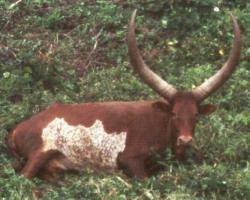 People in Tabora told me horror stories about the road south, which apparently had both Tsetse flies and lions.
I’d been making quick progress on my route south and didn’t feel time pressure, so I decided to try cycling it anyway.
It was relatively short and I felt I could keep up a faster pace.
The first day out I made it to Sikonge, where a Danish missionary couple put me up for the night.
The day after I started out towards Rungwa.
Early in the day, a truck passed me and I seized the chance to ride. The road in that area was much easier than that in northern Tanzania,
but not too interesting, with uniform brown scrub the only view in most directions.
This bit of hitch-hiking was the right call. We rode through forest fires and by wild animals and through clouds of Tsetse flies,
over incredible potholes for four painful hours until finally the truck dropped me off when they turned off the road.
People in Tabora told me horror stories about the road south, which apparently had both Tsetse flies and lions.
I’d been making quick progress on my route south and didn’t feel time pressure, so I decided to try cycling it anyway.
It was relatively short and I felt I could keep up a faster pace.
The first day out I made it to Sikonge, where a Danish missionary couple put me up for the night.
The day after I started out towards Rungwa.
Early in the day, a truck passed me and I seized the chance to ride. The road in that area was much easier than that in northern Tanzania,
but not too interesting, with uniform brown scrub the only view in most directions.
This bit of hitch-hiking was the right call. We rode through forest fires and by wild animals and through clouds of Tsetse flies,
over incredible potholes for four painful hours until finally the truck dropped me off when they turned off the road.
According to the map, Rungwa looked pretty close to my drop off point, so I cycled ahead. There were still a couple hours of daylight left. The Tsetse flies found me quickly and feasted every time I stopped. Every few hundred metres I saw lion tracks on the road. As it got near dark this started to worry me. I was sure that lions, like many animals, were probably most active at sunrise and sunset and I didn’t want to get eaten. As it got darker it worried me more and more but I thought I heard voices from down the road so I decided to push on anyway, rather than stay in a small fleabitten village. It turned out I had guessed right: just at dusk I arrived in Rungwa.
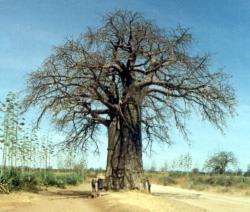 Rungwa is a crossroads town like Tabora, but lacked its charm, facilities, food and history.
I camped next to their football pitch that night, then left that miserable place the next day.
Going south the flies were far worse than they had been the day before. For eight hours they chased me.
If I stopped they settled on me, even in the few seconds it took to drink a sip of water.
They liked to bite my ankles and rump, and especially my shoulders.
They managed to reach these even though I wore my rain coat for protection. They just bit me right through it.
Partway through the day I saw some yellow baboons but couldn’t stop to look at them because the flies would have eaten me entirely.
Finally I ended the day at Ilungu, a little village even more miserable than Rungwa.
Rungwa is a crossroads town like Tabora, but lacked its charm, facilities, food and history.
I camped next to their football pitch that night, then left that miserable place the next day.
Going south the flies were far worse than they had been the day before. For eight hours they chased me.
If I stopped they settled on me, even in the few seconds it took to drink a sip of water.
They liked to bite my ankles and rump, and especially my shoulders.
They managed to reach these even though I wore my rain coat for protection. They just bit me right through it.
Partway through the day I saw some yellow baboons but couldn’t stop to look at them because the flies would have eaten me entirely.
Finally I ended the day at Ilungu, a little village even more miserable than Rungwa.
Ilungu had a bus stop and an English-speaking buyer travelling through told me I could take the bus that night. I had had enough of Tsetse flies so did as he suggested. The bus stopped at Makongolosi, well short of Mbeya but good enough for me. The pleasant little bus stop town had a few good places to eat and get cold drinks, and lots of traffic passed through. A local policeman was quite interested in me and my trip through the bush. Over breakfast he told me there were no more Tsetse flies going south, so I cycled on again. The scenery here was a big improvement over the big stretch of bush I had just crossed but it was uphill and I was very tired. I scored a last ride to the top of a hill overlooking Mbeya. This was Tanzania’s highest point reachable by road. Then I had a nice long and satisfying coast down the hill into Mbeya.
Despite flies and lion tracks, I had enjoyed my trip through the bush. Everywhere I went kids said “Shikamoo, Mzee”, a respectful greeting for one’s elders. It was a shock to realize I was an elder, but at age 30 I was older than 80 percent of Tanzania’s population. Anyway, when I arrived in Mbeya the greeting changed to “Muzungu give me money” so I quickly stopped thinking about it. The bad impressions I’d had of Tanzania before going there were confirmed somewhat in Mbeya, which I guess was back on the tourist track. The small villages I’d passed through on the way there probably saw only a handful of white faces every year.
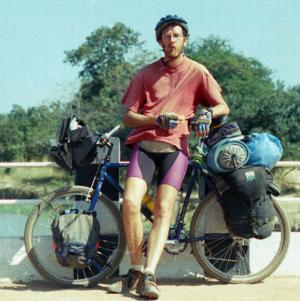 I rested a day in Mbeya then started for Malawi.
The road was paved and easy there, and I pushed up and up through the hills all the way to Tukuya, where I stopped for the night.
The dry and boring bush country I’d passed through had disappeared now, replaced by wonderfully scenic high and forested hills.
The next day came the greatest downhill ride of my entire trip, sixty kilometres all the way to Lake Malawi with hardly a touch on the pedals.
I rested a day in Mbeya then started for Malawi.
The road was paved and easy there, and I pushed up and up through the hills all the way to Tukuya, where I stopped for the night.
The dry and boring bush country I’d passed through had disappeared now, replaced by wonderfully scenic high and forested hills.
The next day came the greatest downhill ride of my entire trip, sixty kilometres all the way to Lake Malawi with hardly a touch on the pedals.
At the bottom I crossed the border with minimal nuisance from the corrupt Malawian officials. They made a half-hearted attempt to squeeze me for a bribe, trying to find some bit of paperwork that they could pretend was done wrong. They didn’t get anywhere and soon gave up. Then I set off across the few remaining flat kilometres and ground almost to a halt. I could not muster the energy to do much more than walk, even though the cycling was supremely easy. At my slow pace I still made it into Karonga, which with its convenience store and modern pharmacy struck me with a sense of being back in civilization. Settled in a hotel, I got down to work solving this latest medical trouble. On the road I had received an estimated 100-120 Tsetse fly bites and I was naturally worried about sleeping sickness, but the symptoms didn’t fit. After a day or two flatulence and diarrhoea hit me and I realized it was giardia again. It took another couple days to cure that.
Various people had warned me that the next bit of road, to Livingstonia, was horrible with potholes but none of these people were cyclists so I ignored their opinions. The road was badly potholed indeed and driving on it must have been a nightmare but on my bike it hardly slowed me down. It wound close to the lakeside, up and down over small hills and through a few tiny villages. What potholes there were diminished about halfway through the day. While cycling, a strange feeling grew that I only gradually identified. It seemed strange that I had cycled all day and nobody had run me off the road or passed on a blind hill or curve, that people drove on the correct side of the road by and large — in short that people drove like civilized humans. In Uganda I had speculated that one could help conservation efforts and road safety campaigns at the same time by teaching the gorillas and chimpanzees to drive buses, but in Malawi such irreverent thoughts never tempted me.
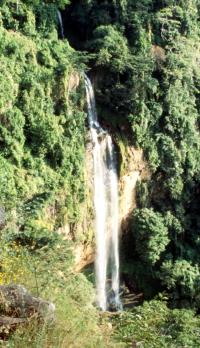 Finally I reached the climb to Livingstonia, up some twenty switchbacks to a plateau, on a dirt road.
Numerous backpackers waited at the bottom for a lift but I headed up by myself.
On the way up a local boy attached himself to me, saying he had better walk with me as there were robbers on that road.
I figured he was just after a tip, particularly since he kept telling me how he was low on money, but let him come along.
Then at the top I was surprised when he simply said good-bye and left. Was he right?
Were there bandits there, too?
Finally I reached the climb to Livingstonia, up some twenty switchbacks to a plateau, on a dirt road.
Numerous backpackers waited at the bottom for a lift but I headed up by myself.
On the way up a local boy attached himself to me, saying he had better walk with me as there were robbers on that road.
I figured he was just after a tip, particularly since he kept telling me how he was low on money, but let him come along.
Then at the top I was surprised when he simply said good-bye and left. Was he right?
Were there bandits there, too?
Yes, he was right. People at the Stone House, the local missionary guesthouse, warned me that there were a lot of thieves around. To reinforce the point, the next morning a couple walking down the road were stripped of everything they owned at knife-point. Everywhere I went in Malawi, the crime rate had soared since the old dictator Banda was deposed. Daylight robbery was common in all the tourist centres I visited. Later on, in another town, I met a couple girls who had been attacked by a group of men with machetes. When they shouted for help the police appeared quickly and shot one of the bandits. They refused to take him to hospital until he led them to the others, and in the end the thieves were caught and sentenced to fourteen years of hard labour.
Bandits were hardly a new problem for me, so this didn’t spoil my stay at Livingstonia. I walked, visiting Manchewe Falls and simply admiring the view while I used up my remaining fuel and food (I expected little camping on the road ahead). I shared my room with an Australian named Greg, who I had first met two years earlier in the Sudan (mentioned above). We were both heading across Africa when we first met and were both still heading south when we met again there. In the meantime I had gone back to Hong Kong to work while he had gone to work in Rwanda. It was a stunning coincidence, but I managed to double it a day or two later when a couple people rode up from the bottom of the hill and I recognized one as a backpacker I knew from Hong Kong. Other people came and went but no meeting was as interesting as those. Finally I teamed up with another cyclist and we rode south.
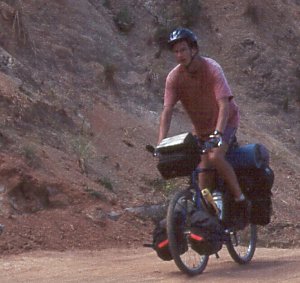 Rather than go down the twenty bends again we took a back road, a pleasant dirt track which went by Nyika Plateau before connecting with tarmac.
In Rumphi we met the couple who had been robbed, staying there for the trial of their bandits.
That night they sat in a local restaurant playing with their recently-recovered palmtop computer and splendidly demonstrating the stupidity which had made
them easy targets for robbery in the first place.
Rather than go down the twenty bends again we took a back road, a pleasant dirt track which went by Nyika Plateau before connecting with tarmac.
In Rumphi we met the couple who had been robbed, staying there for the trial of their bandits.
That night they sat in a local restaurant playing with their recently-recovered palmtop computer and splendidly demonstrating the stupidity which had made
them easy targets for robbery in the first place.
Rumphi to Nkhata Bay went smoothly. We arrived at sunset again, stopping for a huge luxurious lunch on the way. The campsite there was a favourite with overland trucks. It offered diving and a bit of hiking, with accomodation in tents or bamboo and thatch huts. It was pleasant but the party atmosphere didn’t appeal much. I stayed a couple days studying maps, then pressed on by myself. The road onward looked to be the same sort of gentle, moderately interesting country. Thinking about it, I grew bored and eventually I decided I simply didn’t want to do it.
That snap decision was practically the end of my cycling in Africa. From there I took the bus south to Salima, made a cycling side trip to the beach, then rode a bus on again to Blantyre. The scenery was pleasant enough but boring, as expected. It improved near Blantyre, with some rocky hills, but by then I was ready to leave. At that point I had been cycling in Africa for ten months, and it had become a routine; nothing seemed new any more. I took one last bus ride through Tete, Mozambique and on to Harare.
While I was waiting for one of the buses on this leg, a small boy came up to me and told me he was selling mice. “What?” I asked. “Mice,” he replied, and showed me his shopping bag full of dead and apparently rotting mice. I told him I had already had lunch and he left. I later saw a lot more of these mice for sale, in piles and bags and sometimes on skewers. I asked in Harare what people did with them and the seller told me they ate them. Had I been more alert, I would have offered to buy some for him to eat, but as usual this good idea didn't come to me until it was too late.
In my first ten minutes in Harare a group of men ran off with my handlebar bag, containing my camera gear, binoculars and notebooks. Despite this unfriendly greeting, I settled in at the local backpacker’s hostel. Harare surprised me; it was modern and parts of it could have been transplanted from Canada, except for the crime problems. In Malawi I’d still been planning to ride on from Zimbabwe to South Africa, but with boredom and crime hassles I soon lost interest in that. Also, I had always had in mind going to India and Pakistan after Africa and early autumn was the best time of year to visit. So, I postponed my plans to ride on to Capetown and set my sights on India.
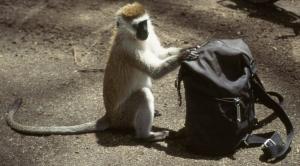 Wanting to go to India and going to India were two different things.
First I had to get a visa, but the High Commission couldn’t give me one because I wasn’t a Zimbabwe resident.
They could FAX my country of residence, which I unwisely listed as Hong Kong, and they did so but no answer ever came.
For a week I didn’t mind; while shopping to replace my stolen camera I had found some guy trying to sell my stolen camera, and the resulting police work took a fair bit of my time.
(I eventually recovered about half my belongings, counting by value).
During the second week the delay started to drag but by then I was busy with mail and shopping for things to sell.
While I did this two more guys tried to pick my pocket, I saw a few sprinting bag snatchers, and I began to wonder if Harare was Shona for “city of thieves.”
By the third week I had given up on my Indian visa, so I retrieved my passport and applied for a Pakistan visa instead, which proved much easier to get.
A flight out was easy to arrange also, with Egyptian Airlines.
That required me to get an Egyptian visa, which was easiest of all to obtain.
I showed up at the embassy Friday afternoon and they told me a visa would take days.
When I protested I had to fly soon, they changed their minds and just gave me one the same afternoon.
Wanting to go to India and going to India were two different things.
First I had to get a visa, but the High Commission couldn’t give me one because I wasn’t a Zimbabwe resident.
They could FAX my country of residence, which I unwisely listed as Hong Kong, and they did so but no answer ever came.
For a week I didn’t mind; while shopping to replace my stolen camera I had found some guy trying to sell my stolen camera, and the resulting police work took a fair bit of my time.
(I eventually recovered about half my belongings, counting by value).
During the second week the delay started to drag but by then I was busy with mail and shopping for things to sell.
While I did this two more guys tried to pick my pocket, I saw a few sprinting bag snatchers, and I began to wonder if Harare was Shona for “city of thieves.”
By the third week I had given up on my Indian visa, so I retrieved my passport and applied for a Pakistan visa instead, which proved much easier to get.
A flight out was easy to arrange also, with Egyptian Airlines.
That required me to get an Egyptian visa, which was easiest of all to obtain.
I showed up at the embassy Friday afternoon and they told me a visa would take days.
When I protested I had to fly soon, they changed their minds and just gave me one the same afternoon.
Before leaving I wanted to see Victoria Falls, at least, but never did manage it. Just as I finished my paperwork, the school holidays started and every available spot on every plane and train was booked solid. My visa time didn’t allow me to postpone my flight so I had to leave without seeing anything in Zimbabwe at all.
Pakistan and India 1996
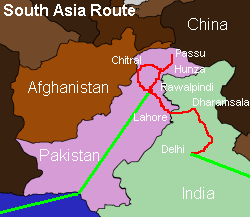 In Cairo I had a 36-hour break between flights, put up in a nice hotel at EgyptAir’s expense.
I tried again to get an Indian visa, and failed again.
I didn’t go to see the pyramids again, but spent my time seeing the newer and relatively rich suburb of Heliopolis.
In Cairo I had a 36-hour break between flights, put up in a nice hotel at EgyptAir’s expense.
I tried again to get an Indian visa, and failed again.
I didn’t go to see the pyramids again, but spent my time seeing the newer and relatively rich suburb of Heliopolis.
From there I flew on to Karachi. The airport there wasn’t the tiny concrete box I expected, but a modern plush facility that would’ve fit in well in Europe or North America. I never left it, but simply bought a ticket on to Rawalpindi.
In ’Pindi I immediately felt back in Asia again, surrounded by noise and pollution and humidity. It felt good, surprisingly, after almost a year in Africa. I settled in at a local hotel and collected maps and guidebooks and finally got my Indian visa. When I applied for this in Islamabad they told me the same thing I had heard in Harare; “we have to FAX your country of residence.” However, in Islamabad the official went on to add “but I won’t put Hong Kong: tell me some place in Canada.” So, I put down Vancouver and got my visa easily.
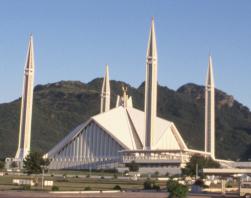 Rawalpindi and Islamabad between them offered quite a bit to see.
’Pindi, the old town, bustled with looping chaotic streets roamed by auto rickshaws and other strange contraptions.
Islamabad, the new town, was arranged in an orderly grid with modern buildings. Around town were cool evergreen forests.
Islamabad also boasted a huge modern mosque, and not far out of town were the ancient ruins (not well preserved) of Taxila.
Entrepreneurs seemed to be everywhere, running efficient restaurants and shops out of ramshackle buildings.
Popular western magazines could be bought cheap, and it seemed all of them were trumpeting boom times for Asia.
Just reading them made me want to run out and leap headfirst into business, investing and wheeling and dealing.
After a few days touring town, I met another cyclist and we debated which route to take going north.
There were three choices; west to Peshawar then north, north directly along the Karakoram Highway or east to Murree and then north.
Peshawar took too long for him and the lower KKH looked boring so we headed for Murree.
Rawalpindi and Islamabad between them offered quite a bit to see.
’Pindi, the old town, bustled with looping chaotic streets roamed by auto rickshaws and other strange contraptions.
Islamabad, the new town, was arranged in an orderly grid with modern buildings. Around town were cool evergreen forests.
Islamabad also boasted a huge modern mosque, and not far out of town were the ancient ruins (not well preserved) of Taxila.
Entrepreneurs seemed to be everywhere, running efficient restaurants and shops out of ramshackle buildings.
Popular western magazines could be bought cheap, and it seemed all of them were trumpeting boom times for Asia.
Just reading them made me want to run out and leap headfirst into business, investing and wheeling and dealing.
After a few days touring town, I met another cyclist and we debated which route to take going north.
There were three choices; west to Peshawar then north, north directly along the Karakoram Highway or east to Murree and then north.
Peshawar took too long for him and the lower KKH looked boring so we headed for Murree.
Since the short road there looked easy we decided to take a back route for a little variety, and left Islamabad climbing the Margalla Hills. My maps weren’t very accurate, though, and on the other side the road degenerated to a rough track leaving us in the middle of an unknown valley. We bumbled along, fording streams and dodging mudholes, drinking whatever questionable water we could get as it was quite hot. Finally we found the main highway. At sunset we had just reached the bottom of the final thousand-metre climb up the hill to Murree. Here, unlike in Africa, I had no worries about bandits but we also had no moonlight and there was a real chance of simply riding over the edge of a cliff in the dark. So, we rode up in a mining lorry full of gravel.
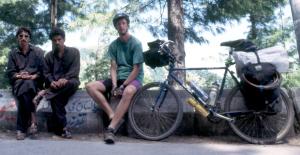 Murree was a hill station and should have been pleasant but wasn’t really.
Instead it was overdeveloped, busy and polluted.
We left immediately, heading towards Abbottabad.
The hill country farther north was beautiful; ridges crested with evergreens and scenic cliff-hanging villages.
People were somewhat reserved, possibly because of our cycling shorts.
I knew locals didn’t like shorts and had no desire to offend them but if we wore long trousers we would have collapsed in the heat,
or at best managed less than half the daily distance we were doing.
I solved this problem by putting on my long trousers any time I got off my bike for more than half an hour,
but the English guy couldn’t solve it because he had no other clothes with him.
Murree was a hill station and should have been pleasant but wasn’t really.
Instead it was overdeveloped, busy and polluted.
We left immediately, heading towards Abbottabad.
The hill country farther north was beautiful; ridges crested with evergreens and scenic cliff-hanging villages.
People were somewhat reserved, possibly because of our cycling shorts.
I knew locals didn’t like shorts and had no desire to offend them but if we wore long trousers we would have collapsed in the heat,
or at best managed less than half the daily distance we were doing.
I solved this problem by putting on my long trousers any time I got off my bike for more than half an hour,
but the English guy couldn’t solve it because he had no other clothes with him.
Soon after Murree, we started to develop stomach problems. We rested a day in Dunga Ghali,a small village looking down two sides of a high hill, with green forest in all directions. Then we set off to Abbottabad and Mansehra. Both these towns seemed noisy and dusty, but the first looked a bit more modern and colonial, whereas the second seemed much older, with narrow winding lanes. After a night looking around town and window-shopping for submachine guns, we turned east and cycled over a couple easy hills into the Kaghan Valley.
The lower reaches were easy going on a well-surfaced road which wound up and down steep hillsides in a narrow valley.
We stopped for the night at Balakot.
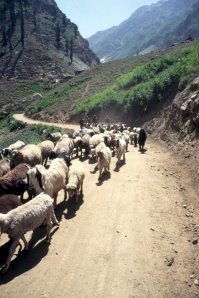 The next day continued on much the same, along steep green hillsides until finally we descended to the river and over a flood plain into Naran, the tourist centre of the valley.
We had to stop yet again for a day’s rest.
Near the village were many short hikes up various hills and mountains, some showing glaciers.
We had no energy for them, though. Then after a day we continued on, winding higher up into the mountains.
The next day continued on much the same, along steep green hillsides until finally we descended to the river and over a flood plain into Naran, the tourist centre of the valley.
We had to stop yet again for a day’s rest.
Near the village were many short hikes up various hills and mountains, some showing glaciers.
We had no energy for them, though. Then after a day we continued on, winding higher up into the mountains.
The valley grew wider and drier, still green but with fewer trees. The road also degenerated, becoming a bumpy and rocky track. Sheep wandered and were herded. That night we paid to sleep in a small, low tent at a seasonal village.
The next day we crossed the river a few more times, skirted a small mirror lake and passed a couple villages with hostile residents. Shepherds ran along the hillsides, toting machine guns. Finally the road slanted up from the valley bottom and headed more or less directly to the Babusar Pass. At some 4100 m, this was the highest point on my trip. Getting to it exhausted me. The road was straight but rocky, and I felt the altitude. The top of the pass didn’t offer great monuments, just a small pile of rocks and a couple comfortable places to sit for lunch. Coming down the far side, I met a couple boys who wanted to push my bicycle for me “while I walked ahead.” I declined their offer. (I was told later that this section of road was somewhat bandit-ridden. This was no surprise.) On the north side of the pass, the track wound down from a roughly circular basin, making numerous switchbacks. It eventually reached the bottom of the valley, near a small winding stream. Farther down, the stream became the road and I found myself carrying my bike over impossible boulders through a torrent of water.
We thought the ride downhill would be easy so didn’t bother to top up our water bottles during the next day’s ride. This was a mistake. The road did indeed zoom down the hillside, but as it did so the river dropped farther and farther below the road until at the last minute the road suddenly turned a corner and climbed up again, with no shade and no chance by then to get more water. Nevertheless, we did make it the last few kilometres into town, then had lunch and rode down the very last hill to the Indus, stopping in a small town called Chilas. The valley near there had a lot of rock carvings left by pilgrims on the Buddhist trail a couple thousand years ago. The setting was dramatic, but even at sunset the heat oppressed and this suggested the daytime heat would be unbearable.
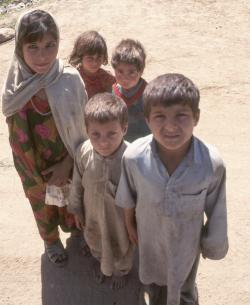 I cycled on by myself the next day, sharing the road with an Austrian bicycle tour.
All of us started at sunrise and it did, as expected, get very hot very quickly.
Both sides of the valley consisted of dark rock which soaked up the sunlight, and there was little shade anywhere.
We escaped the worst part by ten am.
At Raikot Bridge the tour left on a different road for Skardu, while I pushed north towards Gilgit.
On the other side of Raikot Bridge I had to mount a giant pile of rock, the remains of an avalanche from over a hundred years ago.
This had apparently completely blocked the Indus, making a giant lake until the natural dam had burst years later and destroyed every village for a couple hundred kilometres downriver.
I cycled on by myself the next day, sharing the road with an Austrian bicycle tour.
All of us started at sunrise and it did, as expected, get very hot very quickly.
Both sides of the valley consisted of dark rock which soaked up the sunlight, and there was little shade anywhere.
We escaped the worst part by ten am.
At Raikot Bridge the tour left on a different road for Skardu, while I pushed north towards Gilgit.
On the other side of Raikot Bridge I had to mount a giant pile of rock, the remains of an avalanche from over a hundred years ago.
This had apparently completely blocked the Indus, making a giant lake until the natural dam had burst years later and destroyed every village for a couple hundred kilometres downriver.
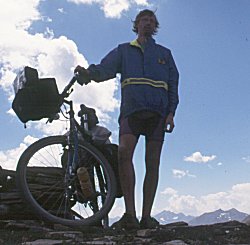 The other side of this scree pile was still hard cycling, with next to no shade and even closer to no water.
It did provide a nice view of Nanga Parbat and the sight of all the ice on that 6000 m high wall did help me along.
Farther north I reached a geologic wonder; the meeting point of the Himalaya, Karakoram and Hindu Kush.
The three mountain ranges sat on different tectonic plates which moved against each other, and one could easily see the difference between the different kinds of rock in each.
Still, that didn’t compare to the sign I saw farther down the road; “Ambush Site — 200 m.”
It made me stop and think but turned out to be just a historical marker.
The other side of this scree pile was still hard cycling, with next to no shade and even closer to no water.
It did provide a nice view of Nanga Parbat and the sight of all the ice on that 6000 m high wall did help me along.
Farther north I reached a geologic wonder; the meeting point of the Himalaya, Karakoram and Hindu Kush.
The three mountain ranges sat on different tectonic plates which moved against each other, and one could easily see the difference between the different kinds of rock in each.
Still, that didn’t compare to the sign I saw farther down the road; “Ambush Site — 200 m.”
It made me stop and think but turned out to be just a historical marker.
Gilgit was the Pakistani equivalent of Kampala, full of backpackers and tourists, many of them on bicycles. Giardia hit me again here so I took my Flagyl again and again had a break of a few days to look around town. Gilgit sits in a broad flat valley bottom, with a typical mixture of old stone and new concrete buildings. It’s a crossroads town, at the confluence of two branches of the Indus with roads going west, north and south.
After recovering somewhat from this latest illness, I rode up to Hunza and on to Passu and Gulmit. The bottom of the valley there was higher than the top of the Col d’Aubisque, the first pass I had traversed with such a feeling of satisfaction a year earlier in France. The peaks of the Karakoram were higher still, of course, some standing over 7000 m tall. I found it hard to appreciate the scale of them. Next to me were peaks roughly twice as high as the Rocky Mountains. While they certainly looked dramatic, they somehow didn’t seem loftier than any other mountains. One noticeable effect of them was near-constant shade in the valley bottom. It got quite cool there and in several places glaciers reached the road.
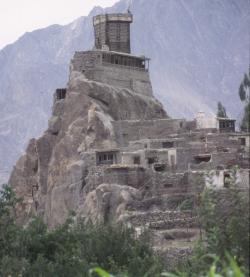 Passu didn’t provide much for facilities but it did have enough good food to eat and no end of places to go hiking.
Unlike some other parts of Pakistan there was also little chance of wandering into the wrong valley and getting shot by bandits.
I stretched my stay there as long as my cash would allow, tramping up hills and cycling off on various roads and paths, crawling like a spider over dubious cable bridges across the river.
Passu didn’t provide much for facilities but it did have enough good food to eat and no end of places to go hiking.
Unlike some other parts of Pakistan there was also little chance of wandering into the wrong valley and getting shot by bandits.
I stretched my stay there as long as my cash would allow, tramping up hills and cycling off on various roads and paths, crawling like a spider over dubious cable bridges across the river.
Heading south again, I stopped in Hunza. Giardia struck me yet again and so I took my Flagyl yet again. When I got that under control I hiked on one of the numerous trails around town and climbed up over a thousand metres for spectacular views. If you start very early and climb quickly, and don’t lose the trail as I did, it is possible to climb all the way to the top of a local peak and see K2 in the distance, on a good day.
Hunza has cultural attractions as well; Baltit and Altit forts occupied perches high on rock outcroppings. The local people, Ismailis, were friendlier than in many other parts of Pakistan so that it was easy to pass an afternoon just walking around and meeting people. They lived on a vegetarian diet, owing to the difficulty of raising animals for food in that harsh environment, and had developed a characteristic cuisine which was quite tasty even to an omnivore like me.
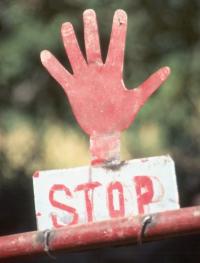 From Hunza back to Gilgit was a pretty easy day despite signs that my particular strain of giardia was fighting off Flagyl again.
In Gilgit I wanted to continue to Chitral but the bicycle trip would take at least 6-8 days and possibly longer allowing time for rest due to illness.
That stretched my visa time a little too much so I opted to hire a jeep, shared with an American couple.
From Hunza back to Gilgit was a pretty easy day despite signs that my particular strain of giardia was fighting off Flagyl again.
In Gilgit I wanted to continue to Chitral but the bicycle trip would take at least 6-8 days and possibly longer allowing time for rest due to illness.
That stretched my visa time a little too much so I opted to hire a jeep, shared with an American couple.
As with the Tambacounda-Bamako road months before, I wished I’d had the time to cycle here as it was beautiful and the road good, or at least good enough for a mountain bike. The jeep ride still let me admire the scenery, anyway. The rocky hills reminded me quite a bit of my home in southern Alberta.
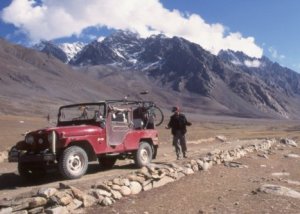 Halfway along the trip we had a social problem.
The American man in our trio had loaned his coat to our driver and later discovered his sunglasses missing from the coat pocket.
Immediately he accused the driver of stealing them.
The driver responded with indignant queries as to why he would do such a thing, and I tended to side with him,
suspecting our American friend had forgotten them
in the hotel the night before.
If he knew his sunglasses were in the coat pocket that morning, why hadn’t he taken them out?
Not wishing to fuel this fire, I ignored it as much as I could.
Unfortunately, that just led to his wife snidely hinting that I must have stolen them.
I was glad when the ride ended.
Halfway along the trip we had a social problem.
The American man in our trio had loaned his coat to our driver and later discovered his sunglasses missing from the coat pocket.
Immediately he accused the driver of stealing them.
The driver responded with indignant queries as to why he would do such a thing, and I tended to side with him,
suspecting our American friend had forgotten them
in the hotel the night before.
If he knew his sunglasses were in the coat pocket that morning, why hadn’t he taken them out?
Not wishing to fuel this fire, I ignored it as much as I could.
Unfortunately, that just led to his wife snidely hinting that I must have stolen them.
I was glad when the ride ended.
Historical note: in 1996 the Taliban had won control of Afghanistan but not yet backed Al-Qaida's terrorist attacks. Neighbouring governments tolerated them without approving of them, and there was some tension. It would be easy to overestimate this, though, because in that part of Pakistan (and Afghanistan) conflict was eternal and central governments had no more than limited control at most. Tourists could nevertheless travel there without much concern, if we kept a few local realities in mind.
The last part of the drive was a bit more exciting than we liked as the driver had started guzzling wine along the route, but we arrived safe and sound in Chitral. Before I moved on I went and got some Fasigyn to cure my giardia forever (or so I hoped). While it took effect I cycled up the Kalash Valleys, a non-Muslim area on the border with Afghanistan and the setting for Kipling’s story “The Man Who Would Be King.” The valley I visited didn’t match the drama of the story. It was scenic and the people were friendly, but I noticed their overwhelming poverty and lack of facilities most. They lacked clean water, power and basic sanitation. The rooms I stayed in were infested with fleas and bedbugs.
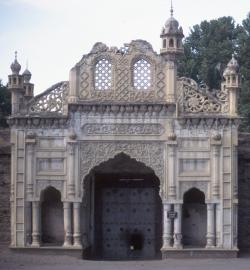 My next day riding south was both one of the most interesting and one of the most demanding ever.
It got off to a bad start with a sleepless night due to bedbug attacks,
and continued bad with one of my water bottle cages falling apart on the road.
I started up the Lowari Pass, a steep climb, but didn’t have the energy to do it so I hitched a ride on a truck.
The truck stopped rather too often for me and when I reached the last part of the pass,
forty-four switchbacks going straight up the side of a mountain, I got off and started pushing my bike again.
My next day riding south was both one of the most interesting and one of the most demanding ever.
It got off to a bad start with a sleepless night due to bedbug attacks,
and continued bad with one of my water bottle cages falling apart on the road.
I started up the Lowari Pass, a steep climb, but didn’t have the energy to do it so I hitched a ride on a truck.
The truck stopped rather too often for me and when I reached the last part of the pass,
forty-four switchbacks going straight up the side of a mountain, I got off and started pushing my bike again.
On the way up other people offered me rides as well. The police had machine-gun posts every couple kilometres along the road, and I got the impression this was not a very safe area. On one side of the pass was Afghanistan and on the other side Kohistan, an area of Pakistan famous for bandits. The police confirmed my impression of unsafety and strongly recommended I get off the road before dark even if it meant camping with them. On the other side of the pass I found two particularly chatty officers who told me the whole story. Apparently gangs of Afghan “mohajirs,” by which I guessed they meant refugees, had taken to shooting drivers and running off with their cargo. I stayed with those two policemen till sunset, when they found me a ride in a convoy into Dir town.
Dir district was positively schizoid. As I continued my ride south the next day I alternately met people actively hostile to me, then very friendly people who warned me to be suspicious of everyone else. In every village boys threw stones (stone-throwing was relatively common in Pakistan, but in Dir it was constant). At one point on the road I passed two boys carrying a big washtub. When a rock whizzed by my ear a few seconds later I knew I had them. Wheeling quickly, I chased them down on my bicycle with the expected response: they dropped their tub and ran off. I picked up the tub, waved it up and down over my head a few times while making a wild Tarzan-like yell, then threw it as far down the hillside as I could.
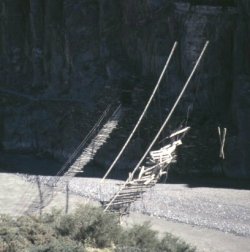 After this most satisfying bit of revenge I was wary of big brothers coming after me.
Indeed, two drivers tried to hit me on the road but I don’t know if there was any connection.
By dinner time I had lost all interest in cycling there, so I happily accepted another ride,
on a truckload of potatoes south over the hills.
The day ended with a beautiful moonlight ride into Mardan.
After this most satisfying bit of revenge I was wary of big brothers coming after me.
Indeed, two drivers tried to hit me on the road but I don’t know if there was any connection.
By dinner time I had lost all interest in cycling there, so I happily accepted another ride,
on a truckload of potatoes south over the hills.
The day ended with a beautiful moonlight ride into Mardan.
From Mardan back to Islamabad I didn’t have a huge range of choices. There were plenty of roads south but I didn’t want to cycle on them. Going east I could try back roads, which all looked unprofitable, or the Grand Trunk Road. One sight of the latter convinced me not to cycle on it so I had yet another truck ride back to Rawalpindi.
Almost done in Pakistan, I rested up a week and lazed there reading cheap books and eating fast food again. Finally I got up and headed off to Lahore. The most direct way out of town was along the Grand Trunk Road again, which I envisioned as being busier than a salmon run. Still, it would save me quite a bit of time so I planned to ride a bit on it and then turn off. To my surprise that section of the big road was good cycling. The government was converting it to dual carriageway and I often had one whole half of the highway to myself. Other times I could ride on broad shoulders. Under those conditions I rode my second longest day ever, 166 km, then followed it with another 125 km and made Lahore in two days.
Lahore had lots of sights and lots of good food but was too crowded and polluted for me, and I ran into a lot of people I didn’t like. I left for the border on a canal road. As I wandered out of town, the traffic volume dropped off sharply. I found myself on a tree-lined country lane, and after a couple sharp turns arrived at a quiet little border post. The Indian side sat on the other side of a small clearing, and sported a much bigger and more officious immigration hall.
The greedy and corrupt officials there were a bit annoying, but I managed to get through them quickly with a bit of stubborn persistence at the right times (for example, refusing to sit down in a corner when they asked me). I was lucky in this as well; while I was waiting a much bigger fish arrived, a German man in a caravan. I heard later they kept him all day while searching his vehicle and checking every possible opening for problems and bribe opportunities.
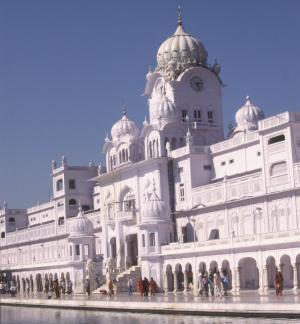 From the border, the road went straight as an arrow to Amritsar, lined with occasional trees on each side.
Amritsar was smaller than Lahore, and different in some insubstantial way.
It seemed to bustle more, with more neon signs and noisy traffic, and looked slightly newer.
A busy highway slanted through one side of the city, running north to Kashmir and south to Delhi.
Greenery within the city seemed hard to find.
Amritsar’s point of fame is the Golden temple of the Sikhs, which occupied a huge site with a deceptively small front door at the end of a trail of windy lanes.
I went through the rituals upon entering, then followed the crowds around the temple.
The central sanctuary was being renovated at the time I visited, so bamboo scaffolding obscured much of the famous gold work.
From the border, the road went straight as an arrow to Amritsar, lined with occasional trees on each side.
Amritsar was smaller than Lahore, and different in some insubstantial way.
It seemed to bustle more, with more neon signs and noisy traffic, and looked slightly newer.
A busy highway slanted through one side of the city, running north to Kashmir and south to Delhi.
Greenery within the city seemed hard to find.
Amritsar’s point of fame is the Golden temple of the Sikhs, which occupied a huge site with a deceptively small front door at the end of a trail of windy lanes.
I went through the rituals upon entering, then followed the crowds around the temple.
The central sanctuary was being renovated at the time I visited, so bamboo scaffolding obscured much of the famous gold work.
It was an interesting sight, but I wanted to get back up in the hills. After a day or two, I got on my bike and rode off again, heading north. I quickly abandoned the busy and narrow main highway for a quite enjoyable canal path. This emerged at a small junction town named Pathankot, which offered a cheap and uncomfortable concrete room in a hotel. From there I began the climb up into the hills. The environment improved immediately, becoming quieter and more green. I wandered over hills which grew gradually higher and steeper, finally working my way up to the lower reaches of Dharamsala.
I had intended to stay a few days in Dharamsala but actually stayed over two weeks. First, I had giardia again and determined to stamp out all my parasite problems once and for all. In order I used the last of my Flagyl, then bought and took a full course of Fasigyn on top of that, and for good measure de-wormed myself as well. That took a week. Then I spent another week people-watching and doing a bit of hill walking. McCleod Ganj, the upper part of Dharamsala, had collected a fascinating group of people; a mix of Indians, Tibetans (the most famous of which was Dalai Lama), foreign tourists and foreigners on exotic spiritual quests. This meant that I could always find somebody interesting to listen to or talk to. There I met again the old Spanish man who had spent his days weeping and wailing in my Beijing dormitory in 1992, and numerous new acquaintances.
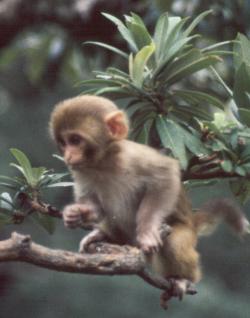 There were also monkeys running wild over the rooftops, fighting and stealing.
The Tibetans pelted them with rocks while the Indians tolerated them.
I came to agree with the Tibetans, after having to fight off the monkeys a few times myself.
From a distance the monkeys were great fun to watch, but up close many species of them were less pleasant.
They seemed to share some of the worst characteristics of humans, including greed and the capability for senseless violence against each other.
There were also monkeys running wild over the rooftops, fighting and stealing.
The Tibetans pelted them with rocks while the Indians tolerated them.
I came to agree with the Tibetans, after having to fight off the monkeys a few times myself.
From a distance the monkeys were great fun to watch, but up close many species of them were less pleasant.
They seemed to share some of the worst characteristics of humans, including greed and the capability for senseless violence against each other.
When I finally left Dharamsala I was sorry to do so and found little reason to change my mind later in India. The ride to Shimla took a couple pleasant days through canyons and hill country. One night I stopped along the way in a little roadside hotel deep in a canyon. The place was busy with businessmen coming and going. Two of them offered to buy me a drink. I accepted, expecting a beer, but instead they poured me three fingers of Scotch. It was good stuff and made my cold shower that night more bearable.
The road was generally enjoyable, until the actual climb to Shimla at the end of it. This was surely my most dangerous ride ever, a one-lane winding mountain road with heavy traffic in both directions. I opted not to ride and got on a bus, which was marginally safer (a few days after I left India, a bus on the same route rolled over the side of that road killing many people). Shimla itself didn’t compare to Dharamsala. It was pleasant enough and had a few left-over glories of the Raj, but was too built-up and busy for my taste. On a hill above town stood a temple of Hanuman, the monkey god, and the monkeys near it had grown quite arrogant. Two of them mugged me on my way up the hill, grabbing the paper bag I carried and running off with it. I enjoyed the look on their faces when they discovered the bag held firecrackers instead of peanuts.
Continuing south to Uttar Pradesh, the road continued on through the Himalayan foothills. Near Shimla, one entire hilltop had been flattened and used to build an airport runway. A bit farther down the road, I saw a small brush fire on a hillside. Ordinary motorists stopped their cars and ran up the hill to put it out. The road tossed up numerous small hillside restaurants and hotels to eat at, and that night I passed Diwali in one such hotel in a small town. Local people celebrated with lots of fireworks and a fair bit of alcohol. At Dehra Dun I stopped a couple nights and made a side-trip to Delhi to collect mail. Dehra Dun was less than pleasant, topping the list of noisy, crowded and dusty cities I had stayed in so far. Delhi itself seemed quite calm and orderly in comparison.
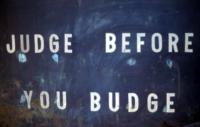 From Dehra Dun, I ascended hills again and cycled up to Mussoorie.
Although not as nice as Dharamsala, this was a big improvement over Shimla.
Mussoorie stretched along the line of a high ridge, wandering off a bit over connected hills and down to valleys.
I enjoyed it enough to stay a week, catching up on mail and making further travel arrangements.
However, it was November and winter was coming, and finally the cold forced me down the hill again.
From Dehra Dun, I ascended hills again and cycled up to Mussoorie.
Although not as nice as Dharamsala, this was a big improvement over Shimla.
Mussoorie stretched along the line of a high ridge, wandering off a bit over connected hills and down to valleys.
I enjoyed it enough to stay a week, catching up on mail and making further travel arrangements.
However, it was November and winter was coming, and finally the cold forced me down the hill again.
Next I settled in Rishikesh, an easy one-day cycle ride from Mussoorie. I also enjoyed this town, despite its filth. The area around Rishikesh is a top Hindu pilgrimage site, so an endless stream of people passed through. These included not only Indians but foreigners as well. To obey religious rules, the diet there was strictly vegetarian. They managed to vary it quite a bit anyway, enough to interest food tourists like me. Sacred cows wandered the streets freely, drinking from the public fountains when it suited them. They seemed to be welcome almost anywhere, although I did see one man shooing a cow that tried to walk into his house. Rishikesh had considerable natural attractions as well, sitting at the base of the Himalayan foothills with roads running off in all direction through scenic hill country. The abundant wildlife included monkeys. The forests housed both mild-mannered Langurs and the aggressive Rhesus monkeys which had mugged me in Shimla and harassed me everywhere.
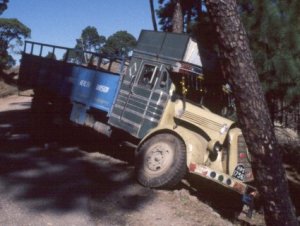 I’d enjoyed the Indian hill country, and knew there were lots of other interesting places to visit farther south, but I wasn’t looking forward to getting there.
Nevertheless, after a couple weeks in Rishikesh I worked up the enthusiasm to ride across the plains to Rajasthan, on the other side of Delhi.
This doesn’t, however, mean I actually did it.
The road was busy and accidents were frequent but my backup plan of riding on canal paths didn’t work because there were none I could easily ride on.
When I reached Meerut, I thought of staying there and ducking in to Delhi for business again but it seemed impractical so I cycled right into Delhi.
This last ride was so harrowing that once I had arrived I decided I would rather leave India than cycle out of Delhi again.
I’d enjoyed the Indian hill country, and knew there were lots of other interesting places to visit farther south, but I wasn’t looking forward to getting there.
Nevertheless, after a couple weeks in Rishikesh I worked up the enthusiasm to ride across the plains to Rajasthan, on the other side of Delhi.
This doesn’t, however, mean I actually did it.
The road was busy and accidents were frequent but my backup plan of riding on canal paths didn’t work because there were none I could easily ride on.
When I reached Meerut, I thought of staying there and ducking in to Delhi for business again but it seemed impractical so I cycled right into Delhi.
This last ride was so harrowing that once I had arrived I decided I would rather leave India than cycle out of Delhi again.
Thus, for a week or two I saw some of the sights of Delhi, none of which impressed me, and ate my fill of good food. Then, just before Christmas, I flew out to Kuala Lumpur.
I had ideas about visiting some places in Malaysia and Indonesia but quickly abandoned them. It was the height of the rainy season when I arrived, making all but the west coast of Malaysia bad for cycling, and the west coast I knew already. There were other possibilities, but nothing inspired much enthusiasm in me. At that point I admitted I simply didn’t want to travel on any more. Even early on in India I had, in my mind, finished my “survey”: I had a good enough idea of what all these parts of Africa and Asia were like, and without trying I had made the mental leap of moving on to more concrete plans. I wanted to set myself up permanently living and working overseas, and after a short holiday goofing off in Malaysia, I got on with it.
The Hong Kong SAR, 1997
My first destination was also my last — Hong Kong. In four and a half years it had changed a lot but I had become quite attached to it. Big things had been happening here and everyone in the world knew about it or thought they knew about it. China had promised nothing would change for fifty years but I doubt that many locals believed it. The Chinese government was already changing things. Local newspapers had begun censoring themselves long before, and the South China Morning Post dropped so much in quality I found it difficult to enjoy it any more. The provisional legislature passed laws which denied local people the right of free assembly and right of free speech. The soon-to-be-commander of the local PLA contingent arrived and tried to bully his way through border officials. Future Chief Executive Tung-Chee-Hwa made himself unpopular when he attempted to placate people by mouthing circular thoughts like “protests will be allowed as long as they are legal.”
About the beginning of June we suffered an invasion of foreign reporters desperately searching for seething unrest or impending natural disaster. Foreign business executives made self-serving speeches about Hong Kong’s brilliant future and attacked the Democratic Party for “destabilizing” Hong Kong. Usenet filled with silly questions about communism and visa restrictions, and hotel occupancy dropped as foreign tourists and small businessmen stayed away. Less silly local foreigners debated whether or not to celebrate the handover. To my mind it was a sad occasion. Something special was ending and we didn’t know what would replace it.
The night itself was as dramatic as one could hope, including a gigantic rainstorm. I watched on television as the Governor left his mansion and all kinds of people gave speeches. The Democratic Party staged a noisy protest at the legislative council, from which they were being evicted despite being elected to their positions by an overwhelming majority. Fireworks went off. A little after midnight I went down to the harbour and watched Prince Charles and the ex-Governor sail away on the royal yacht. The waterfront was very crowded and a group of noisy Indians cheered and jeered loudly at the departing British while scattering beer cans everywhere.
The People’s Liberation Army arrived early in the morning of July first, rolling across the border in tanks and armoured cars of the same kind which they had used to roll over protestors at Tiananmen Square. The next day the Chinese fireworks show attracted a crowd which I estimated must have numbered over a million people. Then the celebrations ended and we all got back to business.
Practical Details
Internet and technological change have rendered much of what I did irrelevant now, if not impossible. I've left the basic points here for historical interest, and amusement. On many points I added some 2022 perspectives, looking back at it with a more modern eye.
General Preparation
- I started reading up on travel health very early on, learning all about malaria drugs and antibiotics and local diseases. I fixed my teeth and got prescriptions and immunizations (Polio, Tetanus, Diphtheria, Yellow Fever, Hepatitis A & B, Japanese Encephalitis, and Meningitis). I read up on culture shock, and how to deal with it. In 2022 that's still what to do, but do get a more recent list of recommended shots! Also, I wish I had known in advance that reverse culture shock is far, far harder to deal with than culture shock. In other words, when you travel for such a long time you really cannot go home again.
- I used the rec.travel newsgroup to collect information and a few addresses. Newsgroups have faded into history now. The 2022 equivalents would be travel forums and social media. Wherever you do your research, remember to question all of it. Shills abound online, and there are even bots posting fake comments. Honest opinion is still often biased, sometimes because people have axes to grind and more often because they remember things the way they want without much effort to be objective.
- Travel/medical insurance for a very long trip proved difficult to get. I finally joined WEXAS in the UK to get their insurance. It was a good deal but I later realized didn’t cover me completely so I dumped it in favor of expatriate health insurance (from BUPA, also in the UK). I have no idea where one would get good insurance in 2022, but the general points still apply: don't assume your health insurance from home will cover you, and don't try to cheat or skimp because it's just giving the insurance company an excuse not to pay out.
- Before leaving I got a new 48-page passport; a normal 24-page would have been too small.
- I didn’t want to carry around $10,000 in cash or cheques so made various arrangements to pay money from a savings account into a current account periodically, and draw on that. The basic approach of separating accounts is more advisable in 2022 than back then, but getting money while abroad is so much easier now it's hardly worth mentioning. These days I'd likely get minimal cash from an ATM, charge as much as I could to a special low-limit credit card, and pay the bills online.
Reading and Research
- My plans began with various Lonely Planet guides. Later I came to favour Rough Guides for actual use on the road. Even by 2000, though, I'd largely stopped bothering with guidebooks at all. These days they seem particularly pointless, when a simple online search will turn up more information than you want on every stop. The reasons I went off them remain relevant: they're all subjective and vary greatly in reliability. The ultimate problem with them is the whole approach, though. Do you really want to follow somebody else around everywhere, or even just their book? If you want to find anything new for yourself you need to strike out on your own.
- Coffee-table books kept my enthusiasm up while I planned, but I can’t remember any names that stand out. History books were sometimes better. Two must-reads are Alan Moorehead’s books The White Nile and The Blue Nile. A most interesting book I found later in Hong Kong has two titles; The Barbarians of Central Asia and The Heartland. It’s by Stuart Legg and well worth chasing down. In Africa I read The Scramble for Africa by Thomas Pakenham. I highly recommend this as well.
- Travelogues didn’t interest me much at first. Later I ran across Danziger’s Travels, and Running With The Moon, and my opinion of the genre improved.
- Novels I generally liked more, especially good ones written about the places I was visiting. I often carried one of James Michener’s monster tomes while travelling. Others I have enjoyed and found insightful were The Year of Living Dangerously and (surprisingly?) James Clavell’s Noble House.
- I particularly like maps and atlases so piled them up. However, early in 2022 I threw out most of my map collection, after reflecting that I almost never looked at any of them. GPS isn't a good substitute for a paper map of your current location, and I still carry a paper map with me when I travel. However, the paper maps just aren't as useful for advance planning as they once were, and few of them have any real souvenir value.
What did I take with me? (and where did it go?)
- Baggage: a Lowe Cerro Torre I backpack (finally sold in HK). It was good quality but way more than I needed to travel by bus and hitch-hiking. Also, it was heavy. On short trips I take a light day pack now and find it completely adequate. In 2022, I'm still partial to Lowe and have a ProTactic camera backpack I use for road trips in my car.
- Footwear: I first took Dolomite Trek-king boots and sandals. The sandals wore out soon and the boots I eventually sold, to my great relief (they were stiff and heavy). Although I’ve never solved the footwear problem completely I eventually took to carrying one pair of ultra-light shoes or sandals and one pair of lightweight boots or walking shoes, plus occasionally a cheap pair of flip-flops.
- Sleeping Bag: a cheap Dodo Safari proved thoroughly satisfactory and perfectly suited for the sort of tropical backpacking I did at first, as well as the cycling later. I also used a foam pad, which was difficult to carry but handy and well worth it.
- Insect protection: I took a net at first and it was stolen before I could use it. I never needed it; if rooms didn’t come with a net or (better) a fan, I could buy coils or electronic mosquito mats, or use repellent.
- Clothes: I took too many and most of them got stolen early on. Some people like jeans but I can’t stand to wear them in the heat. While cycling, I reached my optimum clothing load; one pair of trousers, one pair of shorts, one pair of cycling shorts and two pairs of underwear, two t-shirts, one good shirt and two pairs of socks (used exclusively for cycling).
- Books: too many guidebooks (which got stolen), "Work Your Way Around the World" (good to read but useless to carry so I sold it), and various language books which I condensed to Berlitz phrasebooks and finally did without completely, plus one or two novels. These days I still carry a novel or two, but look up everything else online.
- Water purifiers: I started with Iodine crystals but my bottle got smashed early on. In Asia I managed with tea, soft drinks and bottled water so never needed any tablets or treatment. In Africa I tried Iodine drops, Chlorine, filters and boiling and found them all ultimately ineffective for different reasons (usually that they were too much trouble after a long and exhausting day’s cycling). Instead of counting on pure water, I finally carried along a big bag of de-worming and anti-parasite drugs and used them up as I went.
- Sunglasses (smashed on my first flight to Asia). For cycling I got a pair of wrap-around mirror shades and cannot recommend this highly enough. As well as actual eye protection I simply felt less hot with no glare coming in. For around-town use I later bought a cheap pair of Polaroids, which later still were stolen. I never did find a perfectly satisfactory sunglass solution, but in general lean towards not spending lots of money on them.
- Camera: a Canon AE-1 with 24, 50 and 70-210 mm lenses. I later replaced the zoom lens with a 60-300 mm, the 50 mm lens was stolen and my first 24 mm lens died of fungus so I had to buy a second. Nowadays, when every smart phone has a decent camera built in, there's no great need to worry about camera gear at all. If you do carry proper camera gear, though, I have two specific tips. First, take precautions against fungus and take them seriously. Second, no lens is ever long enough for all your needs. If you're really serious about wildlife photography or other similar uses, get a proper telephoto lens or don't bother at all. These days I use a huge 150-600mm zoom lens, which is good enough for most long-distance shots. Also, ask yourself if it's worth bothering with "standard shots" of famous scenes, since there'll likely be dozens of top-quality ones available online already. If there isn't something unique and personal about your photo, why bother?
- Realistic DX-380 short-wave radio (used then upgraded in HK), nice but too big. I replaced it with a wallet-size Sony ICF SW-100E, which was perfect. Both had to be protected from humidity or would quickly die. Shortwave radio is largely a thing of the past now, but all electronics should be similarly protected against humidity (and dust).
- Medical box: I took ordinary things such as band-aids and moleskin (very useful) plus antibiotics, anti-malaria drugs, headache pills, Imodium, antacid, Iodine, antibiotic ointment. Recommendations change over time and prescriptions change with each person.
- Extra medical supplies for cycling: gauze (never used) and zinc oxide ointment (handy) plus extra bandages and moleskin (which got used up quickly). Later I added Ibuprofen to my bag of pain-killers and found it useful.
- Watch: a Casio world-time watch, which outlived several watch straps and proved vastly useful. These days, though, I don't carry a watch at all and check the time on my phone.
- Security devices: chain for backpack (too heavy so dumped), leg safe (never used, sent home), neck safe (too much trouble, exchanged for money belt)
- Small gifts (a waste of space; I never did give them all away, because I got tired of beggars and one-pen kids).
- Tents: first a Trigano three-man dome tent (sold in HK), a good buy but a bit heavy so I traded it in for a Eureka Gossamer ultra-small (sold in Harare later), which was much lighter but not as weatherproof.
- Cooking gear: an MSR XGK-II camp stove and cheap pots and pans. It all worked well. The important detail about the stove, aside from being lightweight, was that it would burn several different kinds of fuel.
- Binoculars: a small pair of Pentax 10x24 CF-III binoculars. I quite missed these after they were stolen in Harare.
-
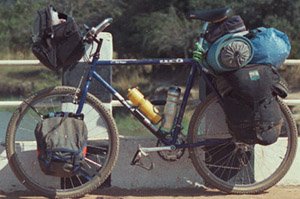 Bicycle: A KHS Montana Pro-FZ racing mountain bike. TrueTemper OX tubing with Deore XT groupset and Dia-Compe 989 brakes.
I had it modified with an extra-strong back wheel (36-spoke XTR hub and Araya rim), touring saddle and higher stem.
I began with normal pedals and changed to Onza clipless pedals later.
The bike performed very well and I kept on riding it until 2022, although I also went back to rat-trap pedals.
Bicycle: A KHS Montana Pro-FZ racing mountain bike. TrueTemper OX tubing with Deore XT groupset and Dia-Compe 989 brakes.
I had it modified with an extra-strong back wheel (36-spoke XTR hub and Araya rim), touring saddle and higher stem.
I began with normal pedals and changed to Onza clipless pedals later.
The bike performed very well and I kept on riding it until 2022, although I also went back to rat-trap pedals.
- Bicycle accessories: Cannondale Mountain rear panniers and Bardale front bag. Both were satisfactory but I didn’t like the cumbersome locking system on the back panniers so sawed it off in Uganda. On the front I had Karrimor Korniche panniers, which were good bags but had a completely inadequate mounting system. In addition to these things I had a Cateye cycling computer and Vista-lite headlight, both of which proved very useful until they were stolen. These days my cycling computer is a Garmin Edge GPS, and it's tempting to just use my phone on a special mount. My spares and tools included several dozen patches (needed), three spare tubes and a set of dirt tires, odd nuts and bolts, spokes (never needed), a chain breaker which broke and which I replaced with another one which also broke, plus an all-in one tool and a few wrenches to fit every nut on my bicycle. I would carry all the same spares again.